ILLUSTRATIONS
OF
NEW SPECIES
OF
EXOTIC BUTTERFLIES.
BY
WILLIAM C. HEWITSON.
SELECTED CHIEFLY FROM THE COLLECTIONS OF
W. WILSON SAUNDERS AND WILLIAM C. HEWITSON.
VOL. III.
JOHN VAN VOORST, LONDON.
1862—1866.
LONDON:
PRINTED BY WOODFALL AND KINDER,
MILFORD LANE, STRAND, W.C.
INTRODUCTION.
IT is now fifteen years since this work was first begun, and during that time the Diurnal Lepidoptera in our collections have been increased twofold in number; for this great wealth, to us who take pleasure in such things, we are indebted chiefly to the industry of Messrs. Bates and Wallace. I well remember that some thirty years ago, Mr. E. Doubleday told me that the largest collection of Rhopalocera in Europe did not, he believed, exceed fifteen hundred species. At the present time my own collection contains more than forty-three hundred and fifty, none of them varieties only, such as have names given to them now (these I do not recognize at all), but such as would have satisfied the sounder judgment of Latreille and Godart.
When I completed my second volume, I gave a short summary of the general progress made during its publication towards the study of the Diurnal Lepidoptera. I did so with unalloyed pleasure, because some useful work had been accomplished. I regret to say that I cannot rejoice over all that has been done since then. Much of it will obscure and render more difficult rather than elucidate and simplify—as all scientific labour ought to do—this delightful subject of inquiry. The Messrs. Felder have edited the first volume of the "Reise der Fregatte Novara" with several well-drawn plates, which are interesting and of use; but I must confess that I can better employ my time than in wading through a page and a half of Latin description to ascertain what minute difference they have thought worthy of a name. The same gentlemen have published a "Species Lapidopterorum," admirable for its great accuracy, but marred, according to my old-fashioned notions, by scores of names, in the genus Papilio alone, given to varieties which would not have been considered worthy of notice when Boisduval edited his "Species Général," and which they themselves do not consider of specific value. Mr. Bates has described many new species—some of them of great beauty and novelty—from the collections of Messrs. Salvin and Godman, of which we have been long promised illustrations. Mr. Wallace's paper on "The Papilionidæ of the Malayan Region" is one of great interest. Bremer has given us some of the butterflies of Siberia, and Vollenhoven the Pieridæ of the Dutch possessions in the East. Mr. Butler, a lepidopterist of great promise, now filling the place formerly occupied by Mr. Doubleday at the British Museum, is doing some good work, but unfortunately, in his too great eagerness for distinction, has committed many errors and added many useless synonyms to our nomenclature. The volume now completed contains one hundred and ninety-nine new species, and three hundred and seventy-three figures. Three parts (including the British Museum Catalogue), towards a monograph of the Lycænidæ, containing one hundred and twenty-one new species, and three hundred and eighty-five figures, have been published by the same author.
Mr. Watson and Mr. Labrey, both of Bowdon, near Manchester, have been for
some time assiduously examining the plumules on the wings of the Diurnal Lepidoptera, and have obtained evidence, which Mr. Watson proposes to publish, that will assist in determining the sexes, as well as in testing the worth, of nearly allied species.
I have to regret the publication of some species previously described by the Felders, but this cannot be avoided when two entomologists are at work upon the same subject at the same time.
I hope to commence my fourth and last volume with the new year, and, if life and health are given me, to bring it in another five years to a successful close.
CORRECTIONS.
Papilio Numicus is P. Caiguanabus of Poey, His. Nat. de la Cuba.
Pieris Læta may be called P. Lætissima, if the present name is objected to from there being a Terias so called.
Ithomia Janarilla is I. Agarista of Felder.
Eresia Gyges is E. Frisia of Poey.
Diadema Diagoras is Apatura Japonica of Felder, but must remain in the genus in which I have placed it.
Romalæosoma Cutteri, though so closely resembling the genus in which it is placed, is, I believe, a Euryphene.
Harma Hemeresia is N. œmilius of Doumet, "Revue et Mag. de Zoologie, 1859, Pl. X." Our figures fortunately represent the two sexes.
Adolias Imperator is A. Satrapes of Felder.
Debis Marpessa will be more properly placed in the genus Taygetis.
Mycalesis Lalassis is M. Samba of Moore.
Hypocista Haemonia ought to have three white pupils in the large ocellus of the posterior wing.
N.B.—An Index is given, by which the binder will be enabled to arrange the Plates, as in the "Genera of Diurnal Lepidoptera."
A second Index, alphabetically arranged, is given for the benefit of those who will take the trouble to number the Plates (from 1 to 60) and the text (from 1 to 120), after the book has been arranged by the first Index.
N.B.—On append un Index par lequel le relieur peut arranger les planches de la même manière qu'en "Genera of Diurnal Lepidoptera."
On append un second Index, arrangé alphabétiquement, pour servir à ceux qui veulent mettre les nombres aux planches (1 à 60), et aussi au texte (1 à 120), après qu'on aura arrangé le livre par l'aide du premier Index.
OATLANDS, WALTON-ON-THAMES,
Sept. 15, 1866.
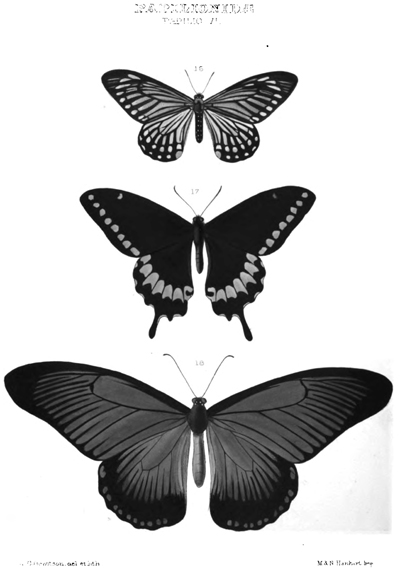
16. PAPILIO EPYCIDES
17. PAPILIO NUMICUS
18. PAPILIO ZALMOXIS
PAPILIONIDÆ.
PAPILIO. VI.
PAPILIO EPYCIDES. 16.
UPPERSIDE. Male dark brown. The discoidal cell of the anterior wing grey: the posterior wing with the cell white: both traversed longitudinally by two lines of black, one of which is bifurcate: both wings traversed longitudinally between the nervures by rays of grey-white, followed closely by a transverse band of white spots, and on the posterior wing by a second submarginal band of similar white spots, the anal spot large and orange: the abdomen with four rows of white spots.
UNDERSIDE as above, except that it is paler, that the anterior wing is traversed at the apex by rays of white, and that the costal margin of the posterior wing is broadly rufous-brown.
Expan. 3 3/20 inch. Hab. North India.
In the Collection of W. C. Hewitson.
This species has been known to me for several years, but until I have had an opportunity of examining several specimens I was unwilling to describe it. It is very nearly allied to P. Agestor, but differs from it in the colour and form of the posterior wing, and has besides an orange spot at its anal angle. The abdomen is spotted with white, not banded as in P. Agestor.
PAPILIO NUMICUS. 17.
Papilio Numicus, Hopffer, Schmet. der Ins. Samm. des Mus. Univers. zu Berlin.
II. Heft. 1856.
UPPERSIDE. Male dark brown. Both wings crossed near the outer margin by a band of orange-yellow spots; on the anterior wing round, or nearly so, and eight in number; on the posterior wing seven, large and conical, the spot, at the anal angle bisected with black. Anterior wing with a spot of the same colour near the costal margin beyond the middle.
UNDERSIDE as above, except that the anterior wing has one or two small spots beyond the end of the cell, that the posterior wing has two spots of unequal size above the middle of the transverse band, and below and on each side of them spots of pale blue, five in number.
Expan. 3 8/10 in. Hab. Cuba.
In the Collections of Dr. Kaden and W. C. Hewitson.
I have to regret that my time has been misspent in figuring a butterfly which has been so well represented before by M. Hopffer. I was not aware of it until my figure had been drawn; and ignorance is perhaps excusable, there having been a lapse of twenty years between the first and second parts of the work in which it is figured.
This species is very distinct, and has little resemblance to any other, but, as M. Hopffer remarks, comes nearest to P. Philenor. For the possession of this rare butterfly I am indebted to the kindness of Dr. Kaden, of Dresden.
PAPILIO ZALMOXIS. 18.
UPPERSIDE dull green, with the margins, the nervures, and rays between the nervures black. Anterior wing with the apex broadly black. Posterior wing with the outer margin broadly black, with a submarginal band of twelve green spots in pairs: the abdomen orange.
UNDERSIDE with the nervures and rays between them black. Anterior wing grey-white, with the apex broadly rufous-brown. Posterior wing rufous-brown; the base orange, with the nervures upon it very black: the cell, which is traversed longitudinally by two black lines, and a portion of the abdominal margin, white: the outer margin with a narrow border of black: the submarginal spots as above, but white.
Expan. 6 2/10 in. Hab. Calabar.
In the Collection of W. C. Hewitson.
This very remarkable butterfly was received by Mr. Stevens in such a state of decomposition that the body, except the outer covering of the abdomen, was completely gone; and it is very probable that the green may have undergone a change of tint.
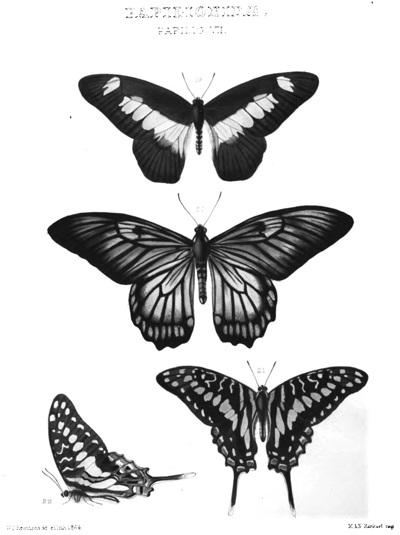
19. PAPILIO UCALEGON.
20. PAPILIO VEIOVIS.
21.22. PAPILIO PORTHAON.
PAPILIONIDÆ.
PAPILIO VII.
PAPILIO UCALEGON. 19.
UPPERSIDE. Male dark brown. Both wings crossed, from near the middle of the anterior wing to the abdominal fold of the posterior wing, by an irregular broad band of white, intersected by black nervures. Anterior wing with a bifid white spot towards the apex.
UNDERSIDE as above, except that it is rufous brown, with the nervures, rays between them and traversing the cells, black. Posterior wing with the base rufous, marked by three black spots.
Exp. 3 9/10 in. Hab. Old Calabar.
In the Collection of W. C. Hewitson.
Although at first sight this species seems, from its great resemblance in colour, to be intimately connected with P. Cynorta and P. Zenobius, it will be found, upon closer examination, to be more closely allied to P. Adamastor or P. Latreillianus. These species resemble each other in the form of the cell of the posterior wings.
PAPILIO VEIOVIS. 20.
UPPERSIDE grey-white, irrorated throughout with dark brown; the nervures and rays traversing the cells black. Anterior wing clouded from the middle to the apex with dark brown; rays of brown between the nervures near the outer margin; the cell crossed by a band of black. Posterior wing with the outer margin broadly brown, traversed by a submarginal band of oblong grey-white spots.
UNDERSIDE as above.
Exp. 5 in. Hab. Menado.
In the Collection of W. C. Hewitson.
Very distinct from any known butterfly; but more nearly allied to P. Encelades than to any other species.
U
PAPILIO PORTHAON. 21, 22.
UPPERSIDE. Male black. Both wings crossed obliquely, from the costal margin (beyond the middle) of the anterior wing to near the abdominal fold of the posterior wing, by a band of pale green spots; both with a submarginal band of white spots. Anterior wing with two bands near the base; three curved linear bands and a white spot within the cell, and three minute white spots beyond the cell. Posterior wing with the abdominal fold and four small spots of white.
UNDERSIDE as above, except that the posterior wing is rufous brown, with a linear crimson spot (bordered on both sides with black) from the costal margin; crimson spots between the median nervules and at the end of the abdominal fold, and black spots between the nervures.
Exp. 3 4/10 in. Hab. Zambesi.
In the Collection of W. C. Hewitson.
Near to P. Policenes: nearer still to P. Anthæus, from which, though much alike on the anterior wing, it is very different on the posterior wing. The P. Evombar, in the Collection of Dr. Boisduval, does not appear to me to be specifically distinct from P. Anthæus; the difference is very slight. For the species now figured I am indebted to the great kindness of Mrs. Dickinson, whose son took it on the Zambesi.
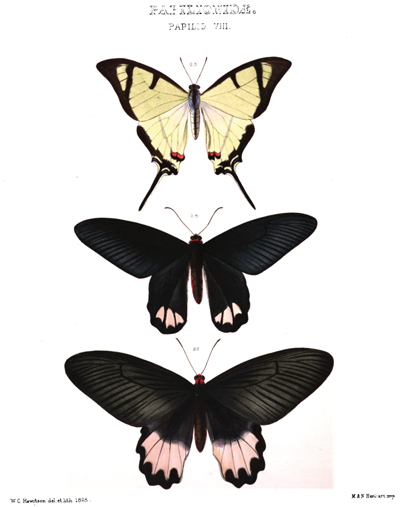
23. PAPILIO SALVINI.
24, 25.PAPILIO ZALEUCUS.
PAPILIONIDÆ.
PAPILIO. VIII.
PAPILIO SALVINI. 23.
Papilio Salvini, Bates. Entomologist's Monthly Magazine, Vol. I. p. 4.
UPPERSIDE. Male pale green. Anterior wing with the costal and outer margins, a band at the end of the cell and a band beyond the middle which connects the costal and outer margins and thus forms a triangular spot, all black. Posterior wing crossed obliquely at the middle by an indistinct band of grey (seen through), touching, near the anal angle, a bifid spot of scarlet which is bordered below with black; outer margin black, with two lunular pale green spots: the tail black, bordered on its inner margin with white.
UNDERSIDE glossy white, tinted with green and lilac. Anterior wing as above, except that the outer margin is so narrow that the transverse band does not reach it. Posterior wing as above, except that the central band is dark brown; that there is a black band near the abdominal margin; that the outer margin is much narrower near the apex; the white lunular spots upon it are much larger; and that there is below each of them, and at the anal angle, a black lunular spot, traversed by a line of pale blue.
Exp. 3 6/10 inches. Hab. Guatemala.
In the Collection of W. C. Hewitson.
For the possession of this beautiful and very distinct species, I am indebted to the generosity of Mr. Salvin. The rich collection of Dr. Boisduval has for some years contained an example of this species, but from what locality I do not know.
Y
PAPILIO ZALEUCUS. 24, 25.
UPPERSIDE. Male blue-black. Anterior wing paler towards the outer margin, with the nervures and rays between them black. Posterior wing with, near the outer margin, three large spots of white: the abdominal fold very large.
UNDERSIDE as above, except that it is paler; that the three spots of the posterior wing are much larger and form one spot, the central portion marked by a spot of black; and that there is a fourth white spot between them and the apex.
Female larger, much paler; the outer half of the posterior wing white; the nervures black; the outer margin with four large conical black spots; the underside grey-brown, with the margins, the nervures, the rays between them, and three longitudinal folds in the cell, black. Posterior wing with two minute black spots upon the white, and a spot of grey-white near the apex.
Exp. ♀ 4½, ♀ 5 inches. Hab. Burmah.
In the Collection of W. C. Hewitson.
Two examples only of this beautiful species have yet come to Europe; they were taken by Captain J. Smyth, of the 69th Regiment, after a day's chase; and are the only ones he saw during his residence in Burmah. They most nearly resemble P. Varuna, the male having the same large and remarkable folding of the hind wing.
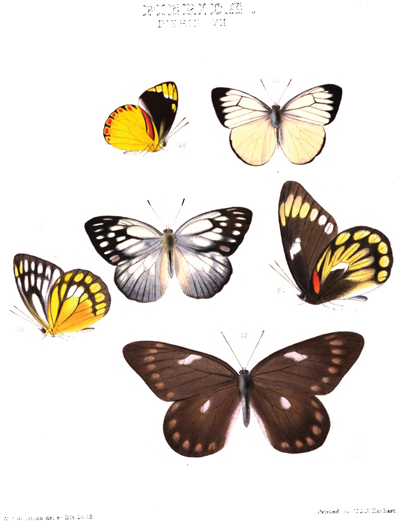
45, 46. PIERIS LAETA.
47, 48. PIERIS TIMNATHA
49, 50. PIERID ZEBUDA
PIERIDÆ.
PIERIS. VII.
PIERIS LAETA. 45, 46.
UPPERSIDE. Male, white: anterior wing with the nervures, the apex (broadly), and the outer margin (which is deeply sinuated on its inner border) black; posterior wing cream-colour with the outer margin black.
UNDERSIDE. Anterior wing black: the base of the costal margin and an oblong spot within the cell grey and green: the inner margin white: a bifid pale yellow spot on the costal margin beyond the middle: the apex crossed by a broad triangular band of very bright yellow divided into six by the nervures. Posterior wing brilliant yellow; a band of scarlet bordered on both sides with black from the base of the wing to the middle of the costal margin: a band of six scarlet spots near the outer margin separated by short black bands at the termination of the nervures: some of these spots inclosed above by a delicate black line.
Expan. 2 in. Hab. Timor.
In the Collection of A. R. Wallace.
PIERIS TIMNATHA. 47, 48.
UPPERSIDE. Male, anterior wing black; the costal margin to beyond the middle, the cell, three small spots beyond the cell, a large trifid space below the median nervure (irrorated with grey towards the inner margin), and a submarginal band of eight spots (two of them irrorated with grey), all white. Posterior wing grey irrorated with black: the nervures below the middle and lines between them black: the cell, a spot near it, and two spots lower down towards the apex, white.
G
UNDERSIDE. Anterior wing as above, except that the white spots are larger and that two of them near the apex are pale yellow. Posterior wing yellow tinted with orange, partly white beyond the cell, intersected by dark brown nervures: the outer margin broadly brown, traversed by a band of seven pale yellow spots.
Expan. 2 6/10 in. Hab. Tondano.
In the Collection of A. R. Wallace.
This species is closely allied to P. Aspasia of Stoll; on its underside it scarcely differs from the female of that species.
PIERIS ZEBUDA. 49, 50.
UPPERSIDE. Male, white; anterior wing elongated at the apex as in P. Thestylis and Nero, with the costal margin, the apex (broadly), and the outer margin to nearly the anal angle, dark grey: the nervures black where they join the outer margin. Posterior wing with the outer margin of a paler grey.
UNDERSIDE. Anterior wing from the base nearly to the middle (except the centre of the cell which is black) light grey and green, followed by dark brown paler towards the apex and crossed by a curved band of seven oblong pale yellow and white spots: at the end of the cell an oblique oblong white spot. Posterior wing orange-yellow; the base and the costal and outer margins dark brown: a submarginal band of six yellow spots: an oblong scarlet spot at the base of the costal margin.
Female, upperside grey- or green-brown; both wings with a white spot at the end of the cell, both crossed near the outer margin by a curved band of six indistinct grey- or green-white spots. Underside as in the male, except that there is no grey at the base of the anterior wing, and that the centre of the posterior wing is yellow, deeply intersected outwardly with black.
Expan. 3½; in. Hab. Menado.
In the Collections of W. W. Saunders and W. C. Hewitson.
This species bears so close a resemblance to P. Descombesi that, were it not for the elongated fore wings, I might have hesitated to describe it as a new species.
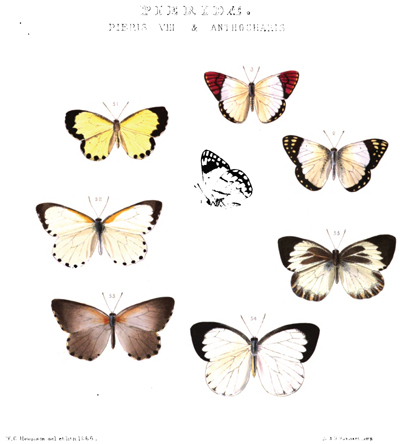
51. PIERIS ERASTUS
52, 53. PIERIS CYNIS
54. PIERIS BERNICE
55. PIERIS POLISMA
1, 2, 3. ANTHOCHARIS AMINA
PIERIDÆ
PIERIS VIII. AND ANTHOCHARIS.
PIERIS ERASTUS. 51.
UPPERSIDE pale yellow. Anterior wing, with the costal margin irrorated with brown; the outer margin (especially near the apex) broadly brown, its inner border deeply sinuated twice below the middle. Posterior wing, with an oblong spot at the apex, and below it four large round spots, brown.
UNDERSIDE paler than above. Anterior wing with the base orange. Both wings with marginal spots of dark brown, each intersected by a line of pale yellow; six spots on each wing.
Expan. 1 8/10 inch. Hab. Gaboon.
In the Collections of W. W. Saunders and W. C. Hewitson.
PIERIS BERNICE. 52, 53.
UPPERSIDE. Male, white. Anterior wing with the base and costal margin, to its middle, orange; apex and outer margin, to below the middle, brown, with its inner border sinuated twice, followed near the anal angle by two brown spots. Posterior wing with six marginal round spots of brown.
UNDERSIDE. Anterior wing white tinted with yellow near the apex, the base orange, as above. Posterior wing pale yellow. Both wings with small marginal brown spots; seven on the anterior wing, six on the posterior wing.
Female, above grey-brown, darkest near the margin; both wings with marginal brown spots. It scarcely differs from the male below.
Expan. 2 2/10 inch. Hab. Gaboon.
In the Collections of W. W. Saunders and W. C. Hewitson.
PIERIS CYNIS. 54.
UPPERSIDE white. Anterior wing with the costal margin to near its middle irrorated with brown; the costal margin from its middle, the apex, and outer margin, brown; its inner border three times sinuated. Posterior wing slightly spotted with brown on the margin.
UNDERSIDE as above, except that the apex of the anterior wing is irrorated with grey; the margin of the posterior wing spotless.
Expan. 2 5/20 inch. Hab. Sumatra.
In the Collection of W. C. Hewitson.
PIERIS POLISMA. ♀
Male, Hewitson's Exotic Butterflies, Vol. II. Pl. VII. fig. 38.
UPPERSIDE. Female, white. Anterior wing with the costal margin irrorated with brown from the base to the middle, the base broadly brown trifid; the apex and outer margin broadly brown, the inner border dentated. Posterior wing with large brown spots on the outer margin.
UNDERSIDE. Anterior wing as above, except that the base is pale grey, and the apex pale rufous-brown. Posterior wing pale yellow, slightly clouded with brown towards the outer margin.
Expan. 2 1/20 inch.
In the Collection of W. C. Hewitson.
ANTHOCHARIS AMINA. 1, 2, 3.
UPPERSIDE. Male, white tinted with yellow on its basal half. Both wings with a marginal band of yellow spots. Anterior wing, with the apical half carmine, crossed by a curved line of black, and bordered inwardly by the same colour. Posterior wing with the outer margin brown.
UNDERSIDE yellow. Anterior wing white, the base orange, a minute black spot at the end of the cell; the apex yellow crossed by the curved band as above which incloses a spot of carmine; the nervures, and a submarginal band which crosses them, brown. Posterior wing crossed by three rufous-brown bands; one near the base, the second (broken into three parts) at the middle, and the third near the costal margin; the ends of the nurvures between the last band and the margin also rufous-brown.
Female like the male, except that the apical half of the anterior wing is dark brown, marked by three pale yellow spots, and that the brown outer margin of the posterior wing is broader. On the underside there is no difference.
Expan. 1 8/10 inch. Hab. Zambesi.
In the Collection of W. C. Hewitson.
I do not feel sure that I have done right in placing this beautiful species where in colour it is most in harmony. It ought, perhaps, to stand next to Pieris Gidica, but I must confess myself unable to find any characters by which, in cases of doubt, to separate Anthocharis from Pieris.
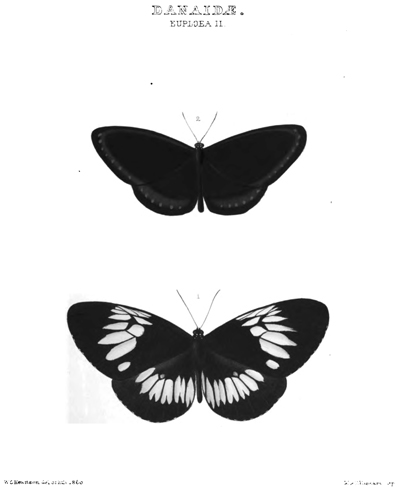
1. EUPLOEA EUPATOR
2. EUPLOEA EUCTEMON
DANAIDÆ.
EUPLOEA, II.
EUPLOEA EUPATOR. 1.
♂ Hewitson's Exotic Butterflies, Vol. II Pl. XII. fig. 1.
UPPERSIDE. Female, dark brown. Anterior wing, with a broad central macular band of eleven white spots: four on the costal margin, two within the cell, and five succeeding each other and increasing in size from the subcostal nervure towards the anal angle, where they are followed by a separate white spot. Posterior wing crossed by a central band of six white spots, four of them sinuated at their bases, and one at its upper extremity as well; a small pale spot within the cell.
UNDERSIDE as above, except that the anterior wing has two minute white spots near its anal angle, and that the posterior wing has four of the spots of the central band subdivided into two: that there are four or five minute white spots within the cell, and a submarginal band of seven, also small.
Expan. 4 3/10 inch. Hab. Menado.
In the Collection of W. C. Hewitson.
H H
EUPLOEA EUCTEMON. 2.
UPPERSIDE. Male, blue-black, with a submarginal band of ultramarine blue near the costal margin of the anterior wing and the outer margin of both wings; the band of blue near the outer margins traversed by a band of pale blue spots, seven in number on the anterior wing, six on the posterior wing.
UNDERSIDE dark brown. Anterior wing, with three oblong spots on the costal margin beyond the middle, two at the centre of the wing, and two submarginal bands of spots from the middle to the anal angle; all pale blue. Posterior wing, with two submarginal bands of pale blue spots.
Expan. 3½ inch. Hab. Menado.
In the Collections of W. W. Saunders and W. C. Hewitson.
I have hitherto been prevented from figuring a number of beautiful new species in this genus, in deference to the long-expressed intention of Dr. Boisduval to monograph the family of which they form a part, very unwilling in any way to interfere with the wishes of so kind a friend; now that it is useless to wait any longer (Mr. Butler having published a monograph of the genus), I have figured a species omitted by him, and the remarkable female of my Eupator.
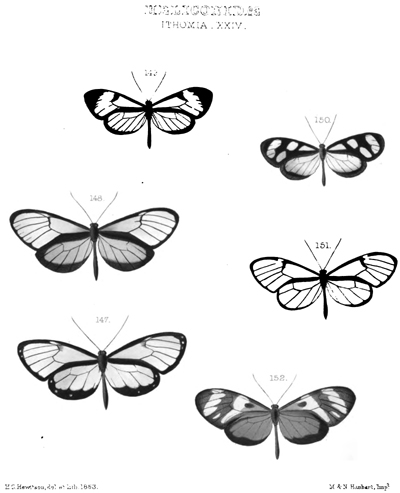
147. ITHOMIA TELESILLA.
148. ITHOMIA TERESITA.
149. ITHOMIA PADILLA.
150. ITHOMIA JANARILLA.
151. ITHOMIA POLISSENA.
152. ITHOMIA AGRIPPINA.
HELICONIDÆ.
ITHOMIA XXIV.
ITHOMIA TELESILLA. 147.
UPPERSIDE. Male transparent, very glossy: the margins and nervures (except at the centre of the posterior wing) black. Anterior wing with a small ill-defined white spot on the costal margin: two indistinct white spots at the apex. Posterior wing with the outer margin broadly black, marked by some very indistinct white spots.
UNDERSIDE as above, except that the white spots at the apex of the anterior wing and near the margin of the posterior wing are white and conspicuous.
Expan. 2 ½ in. Hab. Quito.
In the Collection of W. C. Hewitson.
ITHOMIA TERESITA. 148.
UPPERSIDE. Female transparent, rufous-white, the margins and nervures black. Posterior wing with the costal and outer margins broadly black.
UNDERSIDE as above, except that the margins are all rufous-brown, that the apex of the anterior wing is marked by one or two white spots: the outer margin of the posterior wing by several white spots in pairs.
Expan. 2½ in. Hab. Quito.
In the Collection of W. C. Hewitson.
This may be, and probably is, a female variety of Ithomia Adina of Vol. I. pl. xvii. fig. 47.
ITHOMIA PADILLA. 149.
UPPERSIDE. Male transparent, white: the margins and nervures (except where they cross the white band of the anterior wing) black. Anterior wing crossed beyond the middle by a broad band of white, bounded on one side by a short triangular band, at the end of the cell; on the other by a broad apical band of black sinuated on its inner side.
UNDERSIDE as above, except that the band and margins are entirely rufous.
Expan. 1 9/10 in. Hab. Quito.
In the Collection of W. C. Hewitson.
Very nearly allied to I. Alexina, Vol. II. Pl. xviii. fig. 135; the neuration is the same.
L
ITHOMIA JANARILLA. 150.
UPPERSIDE. Male black. Anterior wing with four transparent spots; one at the base, triangular, two placed obliquely across the middle of the wing, the fourth forming a transverse bifid band near the apex. Posterior wing transparent: the outer margin rufous-brown.
UNDERSIDE as above, except that there is a rufous submarginal band encircling the wings, and that both wings have two or three small white spots at the apex.
The female does not differ.
Expan. 1 17/20 in. Hab. Cuenca.
In the Collections of W. W. Saunders and W. C. Hewitson.
Most nearly allied to I. Onega, Vol. I. Pl. x. fig. 1, of which it is probably only a variety, since the nervures do not differ.
ITHOMIA POLISSENA. 151.
UPPERSIDE. Male transparent, very glossy: the margins, which are very narrow, the nervures, and a slight triangular band at the end of the cell, black. Anterior wing with a small white spot on the costal margins beyond the middle.
UNDERSIDE as above, except that the margins and band are all pale rufous, and that the anterior wing has two minute white spots at the apex.
Expan. 2 2/10 in. Hab. Quito.
In the Collections of W. W. Saunders and W. C. Hewitson.
Very near to I. Diaphanus of Drury, figured in the First Volume of this work, Plate xxiii. fig. 82. This species has the band at the end of the cell at the middle of the wing, whilst I. Diaphanus has the cell of unusual length, and the band much beyond the middle of the wing.
ITHOMIA AGRIPPINA. 152.
UPPERSIDE. Female. Anterior wing semi-transparent black, crossed before and beyond the middle by oblique bands of pale yellow: the base rufous, marked by a spot of brown. Posterior wing rufous, with the apex and outer margin broadly brown.
UNDERSIDE as above, except that the anterior wing has three small white spots at the apex, and that the posterior wing has a submarginal band of eight spots.
Expan. 2 4/10 in. Hab. New Granada.
In the Collection of E. Birchall.
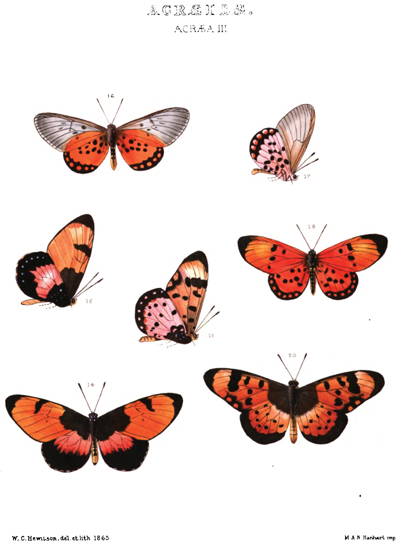
14, 15. AGRÆA ANEMOSA.
16, 17. AGRÆA ADMATHA.
18. ACRÆA ACRITA.
19, 20. ACRÆA ACARA.
ACRÆIDÆ.
ACRÆA III.
ACRÆA ANEMOSA. 14, 15.
UPPERSIDE orange. Anterior wing, with the base, two minute spots, a short transverse band beyond the middle and the apex dark brown. Posterior wing crossed near the middle by a broad band of orange-carmine.
UNDERSIDE as above, except that the anterior wing is paler near the apex, the posterior wing paler at the centre of the transverse band (which is broader), and that there are some minute white spots near the base, and a transverse band of similar spots near the margin.
Exp. 2 7/10 inches. Hab. Zambesi.
In the Collection of W. C. Hewitson.
ACRÆ ADMATHA. 16, 17.
UPPERSIDE. Anterior wing transparent, clouded with brown towards the margin; with some obscure brown spots. Posterior wing scarlet, spotted with black from the base to beyond the middle; the outer margin broadly black, traversed by a band of six round scarlet spots.
UNDERSIDE as above, except that the posterior wing is carmine-white, rufous near the base; the black spots eighteen in number; the submarginal spots orange and carmine-white.
Exp. 2 4/10 inches. Hab. Old Calabar.
In the Collection of W. C. Hewitson.
This species is near to A. Horta, but differs from it in having the broad band on the upperside of the posterior wing. It is nearer to A. Neobule of Reich, "Voyage en Abyssinie," Plate 33, figs. 3, 4 (not A. Nobule of Doubleday, in the "Genera," which is A. Mahela of Boisduval).
Z
ACRÆA ACRITA. 18.
UPPERSIDE. Anterior wing rufous-orange, paler beyond the middle: with a spot in the cell, a band of three spots at the middle and the apex dark brown. Posterior wing orange-carmine with some brown spots at the base and a transverse band of five black spots at the middle; the outer margin broadly black, traversed by a band of seven rufous spots.
UNDERSIDE. Anterior wing as above, except that the apex is not brown. Posterior wing carmine, with nineteen black spots, bordered irregularly with white; the submarginal spots larger, white.
Female like the male, except that it is rufous-brown above.
Exp. 2 3/10 inches. Hab. Zambesi.
In the Collection of W. C. Hewitson.
ACRÆA ACARA. 19, 20.
UPPERSIDE rufous; the base of both wings dark brown. Anterior wing with a spot in the cell, a transverse band of three spots at the middle, a broad band beyond the middle, the apex and the outer margin (marked with two rufous spots) from the middle to the anal angle, all dark brown. Posterior wing with two bands of spots and the outer margin which is broad, black.
UNDERSIDE as above, except that the anterior wing near the apex and the posterior wing are carmine-white, and that there are minute spots of white at the base and a band of seven white spots near the outer margin.
Var. one-third smaller, with the outer margin above much broader, the sub-marginal spots of the underside very minute.
Exp. 2 8/10 inch. Hab. Natal and White Nile.
In the Collection of W. C. Hewitson.
This may be only an extraordinary variety of A. Menippe. When we know more of Africa and its entomological productions, we shall, I believe, find that the Acræas and the Lepidoptera generally vary more than those of other parts of the world.
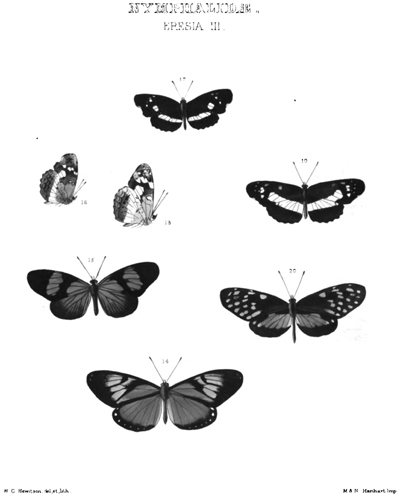
14. ERESIA DATIS
15. ERESIA ACRÆINA
16, 17. ERESIA MYIA
18, 19. ERESIA OFELLA
20. ERESIA ITHOMIOIDES
NYMPHALIDÆ
ERESIA. III.
ERESIA DATIS. 14.
UPPERSIDE. Male. Anterior wing black, with a large triangular spot of scarlet at the base: a large triangular spot of yellow at the middle, divided into six by the nervures: three or four indistinct minute white spots near the apex. Posterior wing scarlet: the outer margin black, traversed by a band of minute white spots.
UNDERSIDE as above, except that the anterior wing has a submarginal band of white spots, and that the nervures of the posterior wing are brown.
Expan. 2½ inch. Hab. New Granada.
In the Collection of W. C. Hewitson.
ERESIA ACRÆINA. 15.
UPPERSIDE. Female black. Anterior wing with the base and a band which crosses the centre of the wing carmine. Posterior wing from the base to beyond the middle carmine: the nervures and rays between them black.
UNDERSIDE as above, except that the apex of the anterior wing is pale brown, the nervures and rays between them black, and that the posterior wing is grey-brown, rufous at the base, clouded beyond the middle with darker brown; the nervures and rays between them black.
Expan. 2 3/20 inch. Hab. Upper Amazon.
In the Collection of W. C. Hewitson.
Near to E. Castilla of Felder, of which it can scarcely be a variety as he does not mention the basal spot of the anterior wing, and describes the band which crosses it as pale ochraceous. It is also nearly allied to E. Perilla of this work (vol. i. pl. 30), but is of different form and colour.
ERESIA MYIA. 16, 17.
UPPERSIDE. Male black. Anterior wing deeply emarginate at the middle of the outer margin: a bifid round spot near the middle of the inner margin: crossed beyond the middle by a band of four small spots, two of them grey, two white.
P
Posterior wing dentate, with a central transverse band of white, ending in two minute white spots where it touches the costal margin.
UNDERSIDE. Anterior wing rufous-brown: the cell rufous, marked at the end by two minute white spots; the spots as above, but larger: a white spot near the middle of the outer margin: two minute white spots on the costal margin near the apex. Posterior wing with the basal half white, marked with two spots and several lines of brown: outer half of the wing clouded with rufous-brown, marked with some lunular black spots and two submarginal waved brown lines.
Expan. 1 6/10 inch. Hab. Mexico.
In the Collection of W. C. Hewitson.
ERESIA OFELLA. 18, 19.
UPPERSIDE black. Both wings crossed transversely by a common band of white, commencing at the third median nervule of the anterior wing. Anterior wing with a spot in the cell: crossed beyond the middle by a band of five small spots; and nearer the apex by a second band of four smaller spots.
UNDERSIDE. Anterior wing as above: the white spots larger: the base grey-yellow: the middle of the outer margin and apex white. Posterior wing with the basal half white, undulated near the base with brown: the outer half rufous-brown, with black spots and two submarginal waved lines of black.
Expan. 1 9/10 inch. Hab. New Granada.
In the Collection of E. Birchall.
ERESIA ITHOMIOIDES. 20.
UPPERSIDE. Male dark brown. Anterior wing with numerous spots of rufous-yellow. Posterior wing crossed transversely before the middle by a broad band of scarlet: the apex with two small white spots, one of them touching the transverse band.
UNDERSIDE as above; except that the posterior wing has a submarginal band of seven white spots.
Expan. 2 7/20 inch. Hab. New Granada.
In the Collection of E. Birchall.
The Eresias form a genus exceedingly interesting from its great diversity of form and colour; whilst figure 15 of the plate has a considerable resemblance to Acræa Trinacria of Felder, figure 20 bears a remarkable likeness to Ithomia Peridia of the "Exotic Buterflies" (vol. i. pl. 13).
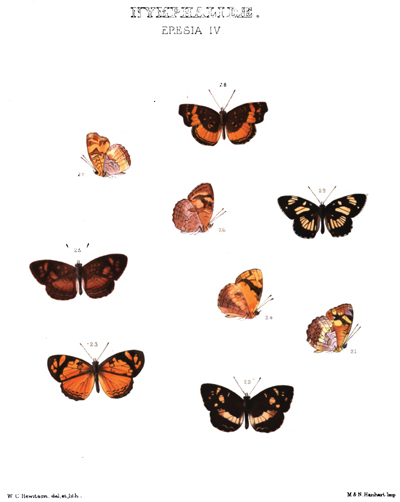
21, 22. ERESIA ORTHIA.
23, 24. ERESIA OROBIA.
25, 26. ERESIA VELICA.
27, 28. ERESIA VERENA.
29. ERESIA EZRA.
NYMPHALIDÆ.
ERESIA. IV.
ERESIA ORTHIA. 21, 22.
UPPERSIDE. Male dark rufous-brown. Anterior wing with several rufous-yellow spots; one in the cell, a second trifid by the median nervules, a third near it, a fourth near thecostal margin beyond its middle, and three smaller nearer the outer margin. Posterior wing with a central transverse band of rufous-yellow and a single lunular spot near the anal angle.
UNDERSIDE. Anterior wing with the spots as above; the basal half orange-yellow: beyond it dark brown: the apex and outer margin broadly rufous, with paler spots at the apex and the middle of the outer margin. Posterior wing with the transverse band as above: the base clouded with rufous spots and lines; beyond the central band rufous, marked with black spots: the outer margin and a parallel waved line rufous-brown.
Expan. 1½ inch. Hab. Minas Geraes.
In the Collection of W. C. Hewitson.
ERESIA OROBIA. 23, 24.
UPPERSIDE. Anterior wing dark brown: the basal half orange, divided in the cell and near the anal angle into separate spots: an oblong spot near the costal margin, and three near the outer margin also orange. Posterior wing rufous-orange, with a submarginal band of spots and waved line of black from the anal angle to the middle of the wing: the outer margin dark brown.
UNDERSIDE. Anterior wing as above; except that the spots near the outer margin are extended to the apex and outer margin. Posterior wing rufous-yellow, clouded and undulated with rufous-brown.
Expan. 1 6/10 inch.
In the Collection of W. C. Hewitson.
ERESIA VELICA. 25, 26.
UPPERSIDE. Male dark rufous-brown. Anterior wing with several ill-defined rufous spots; three near the base, one near the costal margin, three between it and the inner margin, and three towards the apex. Postcrior wing with a broad transverse rufous band and some submarginal lunules of the same colour.
UNDERSIDE. Anterior wing brown; with the base and two spots near it, the spots above (the three lower spots united in one), and the apex and outer margin rufous. Posterior wing rufous, clouded and undulated with darker colour.
Expan. l 6/10 inch.
In the Collection of W. C. Hewitson.
ERESIA VERENA. 27, 28.
UPPERSIDE. Male dark brown. Both wings crossed by a common band of orange; both with several smallspots near the base, and a submarginal band, irregular and broken into spots, on the anterior wing, continuous and waved on the posterior wing.
UNDERSIDE rufous-yellow, with the bands as above: the base of both wings crossed by lines of brown. Anterior wing with the apex rufous-brown, with spots of paler colour. Posterior wing undulated with brown at the outer margin.
Expan. 1 9/20 inch. Hab. Bolivia.
In the Collection of the British Museum.
ERESIA EZRA. 29.
UPPERSIDE Male black. Anterior wing with two spots in the cell, a large spot below them bifid by the first median nervule, a quadri-partite band from the costal margin beyond the middle, and below it a small spot, all rufous-white. Posterior wing with a minute spot in the cell; crossed before the middle by a curved band divided by black nervures.
UNDERSIDE as above; except that the posterior wing has three spots at the base, a band of indistinct spots near the outer margin, and a submarginal band of white spots.
Expan. 1 9/20 inch.
In the Collection of W. C. Hewitson.
I have thought with Dr. Felder that the butterflies figured in this plate, as well as the North-American species, which were put with Melitæa in Doubleday and Hewitson's Genera of Diurnal Lepidoptera, would be better associated with Eresia; they cannot be separated from E. Herä and Ianthe, which Mr. Doubleday considered as belonging to this genus. It seems to me that there is very little generic difference between Melitæa Eresia and Synchloe besides their outward appearance. I am, however, quite content with this distinction when the eye can at once separate them.
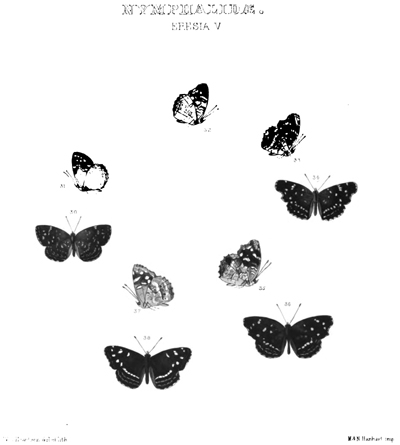
30, 31. ERESIA SIMOIS.
32. ERESIA HERMAS.
33, 34. ERESIA SMERDIS.
35, 36. ERESIA ARDYS.
37, 38. ERESIA ABAS.
NYMPHALIDÆ
ERESIA. V.
ERESIA SIMOIS 30, 31.
UPPERSIDE brown. Anterior wing rounded at the apex and outer margin, with several indistinct white and rufous spots. Posterior wing scarcely dentated; crossed by three equi-distant bands of rufous spots.
UNDERSIDE. Anterior wing orange, with the white spots as above enclosing a large black spot: a band of three white spots near the base. Posterior wing orange yellow, with the three bands of white spots as above.
Expan. 1 1/10 to l 5/20 inch. Hab. Brazil.
In the Collection of the British Museum.
There is a variety of this species in which the central white spots of the anterior wing become a broad rufous band, broken in the middle; the inner row of spots on the posterior wing is also increased to a broad band; the black spot on the underside of the anterior wing is much smaller, aud the bands of spots on the posterior wing much more defined.
ERESIA HERMAS. 32.
UPPERSIDE. Male, dark brown. Anterior wing with twelve or more distinct white spots: outer margin slightly sinuated. Posterior wing with two white spots near the base, and a broad macular central band, followed by two narrow bands of rufous spots.
UNDERSIDE. Anterior wing orange at the base, brown beyond it; with the white spots nearly as above. Posterior wing brown-white, with several indistinct white spots and a submarginal band of white lunules: the outer margin rufous: a spot on the costal margin and one near the middle of the outermargin rufous.
Expan. 1 3/10 inch. Hab.
In the Collection of the British Museum.
ERESIA SMERDIS. 33, 34.
UPPERSIDE dark brown, paler at the base. Anterior wing with eleven or more white spots; the outer margin deeply sinuate. Posterior wing crossed by two bands of white spots: the outer margin deeply dentate.
Q
UNDERSIDE. Anterior wing with the basal half bright orange, the middle dark brown; the outer margin rufous brown; the spots as above. Posterior wing pale brown, crossed before the middle by a band of brown, at the middle by a band of white: marked beyond the middle by two large triangular brown spots.
Expan. l 7/20 inch. Hab. Mexico.
In the Collection of the British Museum.
ERESIA ARDYS. 35, 36.
UPPERSIDE. Male, dark brown. Anterior wing with eight or nine yellow spots: the costal margin much curved: the outer margin sinuate, toothed below the sinuation. Posterior wing with a central band of yellow spots, a submarginal band of lunules, and between them a band of linear spots half across the wing.
UNDERSIDE. Anterior wing dark brown, with the base and a large spot on the outer margin orange: the spots nearly as above, but larger. Posterior wing beautifully variegated with grey, white, orange yellow, and brown.
Expan. 1½ inch. Hab. Mexico.
In the Collection of the British Museum.
This and the preceding species are nearly allied to Hera of Hubner: his figures are, however, so accurate in form and colour that I am compelled to consider them as distinct.
ERESIA ABAS. 37, 38.
UPPERSIDE. Male, dark brown. Anterior wing with seven distinct white spots (one bifid), three in a line, nearly parallel to the outer margin: a submarginal line of indistinct white spots.Posterior wing with a central band of white, followed by two narrow rufous bands.
UNDERSIDE. Anterior wing with the basal half and spots at the apex and outer margin ochreous yellow; the outer half brown, with the spots as above. Posterior wing pale, with the central band as above; followed by four blind ocelli.
Expan. 1½ inch. Hab. New Granada.
In the Collection of the British Museum.
This species may be known from those just described by the arrangement of the white spots of the anterior wing.
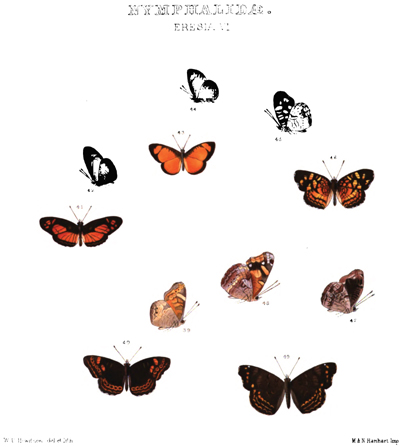
39, 40. ERESIA ACETA
41, 42. ERESIA GYGES
43, 44. ERESIA DICOMA
45, 46. ERESIA OTANES
47. ERESIA ANIETA
48, 49. ERESIA ACESAS.
NYMPHALIDÆ.
ERESIA. VI.
ERESIA ACETA. 39, 40.
UPPERSIDE dark brown. Anterior wing with some indistinct rufous spots near the base, and two rufous spots beyond the middle. Both wings crossed by a band of eye-like spots, with rufous-orange borders; more distinctly ocellated on the anterior wing: both with a linear rufous submarginal band.
UNDERSIDE. Anterior wing rufous, with the spots as above, and two blind ocelli towards the apex. Posterior wing pale brown, with spots of rufous brown near the costal and outer margins, and three or four minute blind ocelli.
Expan. 1½ inch. Hab. New Granada.
In the Collection of the British Museum.
ERESIA DICOMA. 41, 42.
UPPERSIDE dark brown, with a spot near the base, a large 5-partite spot near the inner margin, a linear spot beyond the middle, and three spots (one bifid) near the outer margin, all rufous. Posterior wing with a broad rufous band and a submarginal band of rufous lunules.
UNDERSIDE rufous. Anterior wing crossed beyond the middle by a band of darker colour: the apex and the whole of the posterior wing marked with lunules and lines of rufous brown.
Expan. 1 3/10 inch.
In the Collection of W. C. Hewitson.
There is a variety of this species in which the large rufous spot on the inner margin is extended to the base. It is near Teletusa on the upperside, but of different form: on the underside it is identical with Claudina of Eschscholtz.
ERESIA ANIETA. 43, 44.
UPPERSIDE rufous orange. Anterior wing with the base and costal margin and a band near the apex rufous brown: the outer margin broadly dark brown. Posterior wing with the outer margin brown.
UNDERSIDE paler. Anterior wing darker at the base and outer margin: the apex with some lunular spots. Posterior wing clouded beyond the middle with rufous lines and lunules.
Expan. 1 1/10 inch. Hab. Venezuela.
In the Collection of W. C. Hewitson.
ERESIA GYGES. 45, 46.
UPPERSIDE. Male, dark brown: the base of both wings crowded with rufous spots. Anterior wing with seven large orange spots. Posterior wing with four transverse bands; the first rufous, the three following orange; the first and second united towards the inner margin.
UNDERSIDE. Anterior wing with the base orange, the middle dark brown, the outer margin broadly rufous: the spots as above, but larger; one of them extending to the outer margin. Posterior wing pale rufous yellow, with darker spots on the costal and near the outer margins: a submarginal band of white lunular spots and three or four minute blind ocelli.
Expan. 1 3/10 to 1 6/10 inch. Hab. Jamaica.
In the Collection of W. W. Saunders and W. C. Hewitson.
This species has a close resemblance to E. Drusilla of Felder in the marking of the upperside, but differs from it in its much paler colour.
ERESIA OTANES. 47.
UPPERSIDE. Male, uniform dark brown: anterior wing with a small rufous spot near the apex. Posterior wing of a different colour, slightly tinted with purple: the outer margin of the same brown as the anterior wing.
UNDERSIDE. Anterior wing rufous brown; the base paler, crossed by bands of black: a spot on the costal margin, a triangular spot at the apex, and a spot near the outer margin, rufous white. Posterior wing grey and rufous, with several large rufous brown spots.
Expan. 1 3/10 inch. Hab. Guatemala.
In the Collection of W. C. Hewitson.
This butterfly was kindly added to my collection by Mr. Salvin. It may be only a variety of the next species, C. Acesas, of which I possess several examples, which are of the same size and of a spotless brown above.
ERESIA ACESAS. 48, 49.
UPPERSIDE. Female, dark rufous brown: anterior wing with two spots near the base and four or five near the outer margin orange yellow: two large indistinct triangular spots near the middle. Posterior wing crossed by three bands of spots; the first orange yellow, the others rufous.
UNDERSIDE. Anterior wing, with the base, two large spots in the middle, and a spot at the outer margin, orange: the apex grey, with lunular white spots. Posterior wing grey and rufous, with spots and lunules of paler colour and a submarginal band of lunules.
Expan. 1 2/10 to 1 6/10 inch. Hab. Venezuela.
In the Collections of W. W. Saunders and W. C. Hewitson.
There are varieties of this species of much smaller size; some of a uniform spotless brown, others with one, two, or three of the transverse bands of the posterior wing.
I have thought it superfluous to describe minutely any of the species figured in the three accompanying plates where both sides are given.
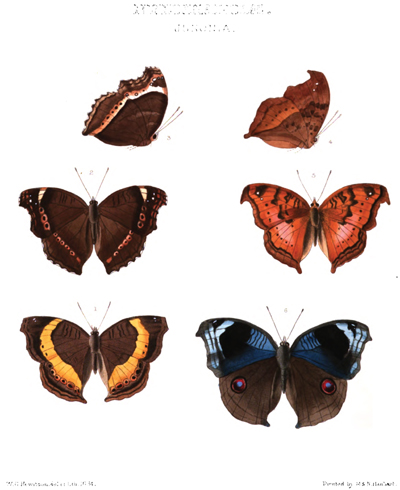
1. JUNONIA ELGIVA
2, 3. JUNONIA CHAPUNGA.
4, 5. JUNONIA CUAMA.
6. JUNONIA ARTAXIA.
NYMPHALIDÆ.
JUNONIA.
JUNONIA ELGIVA. 1.
UPPERSIDE. Female, rufous brown: both wings crossed beyond the middle by a continuous band of orange-yellow and two submarginal bands of dark brown. Anterior wing crossed in the cell, and beyond it by five lines of black: two minute white spots near the apex, and two or three black spots upon the transverse band. Posterior wing with a band of ocelli touching the outer border of the transverse band: the and ocellus (which is double) and the next to it, brick-red, bordered with orange, and again with black: the pupils black, with centre of pale blue: the other ocelli are blind, with a rufous centre and border of black.
UNDERSIDE pale yellow. Both wings crossed beyond the middle by a band of ocelli; on the anterior wing by five without pupils, the middle one represented by a pale yellow spot: on the posterior by six, three of which are pupilled with blue, the first, third, and fourth nearly obliterated. Anterior wing crossed before the middle by three zigzag rufous bands: clouded at the apex and marked with two minute white spots. Posterior wing with some indistinct spots and a curved linear rufous band near the base: crossed at the middle by a linear band of brown: the anal angle with a purple line.
Expan. 2 4/10 inch. Hab. Zambesi.
In the Collection of W. C. Hewitson.
This species bears a close resemblance to J. Terea, but differs from it in various ways: in the absence of the line which passes through the transverse band of that species, and in having the upper margin of the said band clearly defined. My examples of J. Terea are very much less than J. Elgiva; Cramer's and Drury's figures are, however, of the same size.
JUNONIA CHAPUNGA. 2, 3.
UPPERSIDE rufous brown. Both wings crossed beyond the middle by a common band of spots, commencing on the anterior wing by a quadrifid white spot, followed by three rufous spots with black centres, and on the posterior wing by five similar spots: both wings with a submarginal black line. Anterior wing with three minute white spots, and four rufous spots near the apex.
UNDERSIDE rufous brown. Both wings crossed beyond the middle by a common band of white rufous on its outer border, traversed by a line of small black spots, bifurcate on the anterior wing, where some of the black spots are centred with white. Anterior wing with three indistinct bands before the middle, posterior wing with one similar band: both wings with the outer margin rufous.
Expan. 2 4/10 inch. Hab. Zambesi.
In the Collection of W. C. Hewitson.
This may be a variety of J. Pelasgis of Godart, and although the broad transverse band of that species is only represented on the upperside of this by round spots, it has the band, as in that species, on the underside.
R
JUNONIA CUAMA. 4, 5.
UPPERSIDE rufous. Both wings with the outer margin broadly brown, traversed by a line of brown, and bordered inwardly by a line of the same colour: both wings with a band of small black spots, two of which, near the apex of the anterior wing, have white centres. Anterior wing with a spot in the cell, a spot at the end of the cell, a transverse broken band (from margin to margin) of irregular spots, and a large spot near the apex, all dark brown. Posterior wing with a large black spot on the costal margin, and two smaller spots below it.
UNDERSIDE rufous and lilac brown. Both wings with several indistinct spots near the base: both crossed near the middle by an indistinct band of paler colour: both with a band of indistinct rufous spots; posterior wing with a submarginal band of indistinct spots.
Expan. 2 4/10 inch. Hab. Zambesi.
In the Collection of W. C. Hewitson.
JUNONIA ARTAXIA. 6.
UPPERSIDE. Anterior wing grey blue: the centre blue black: the margin rufous brown: the cell crossed by five bands of black: two minute white spots near the apex, and three bands of brown near the outer margin. Posterior wing rufous brown with a crimson ocellus, with pupil of lilac and yellow iris bordered with black and two indistinct submarginal bands of brown.
UNDERSIDE grey brown. Anterior wing crossed before the middle by three rufous brown bands: beyond the middle by a curved band of purple brown: marked at the apex by three minute black spots, and below them, near the outer margin, by several rufous and brown spots. Posterior wing crossed at the middle from the costal margin to the anal angle by a linear rufous band, with its outer border broadly brown; clouded near the base by some indistinct spots, and marked beyond the band by an indistinct blind ocellus, and some minute black spots; and nearer the margin by a curved black line.
Expan. 2 8/10 inch. Hab. Zambesi.
In the Collection of W. C. Hewitson.
On the underside this species has a near resemblance of J. Iphita.
The butterflies represented in the accompanying plate were collected by Mr. John Dickinson, of Jarrow, in the county of Durham, who was appointed surgeon to the Universities' Mission to Central Africa, under Bishop Mackenzie, but unfortunately did not live to return to England. The collections in the various branches of Natural History which have reached his relations, show the zeal with which he must have prosecuted the pursuit. To the generosity of his relations I owe the pleasure of publishing these new species, and of adding them and others of equal interest to my collection.
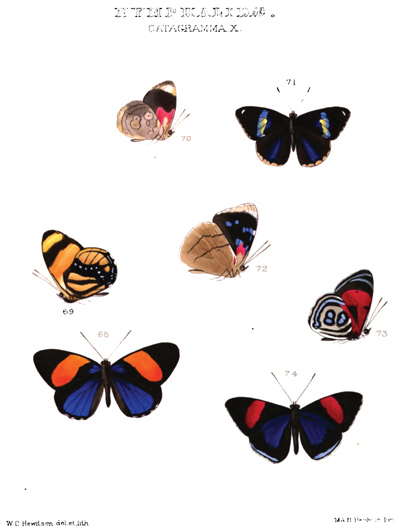
68, 69. CATAGRAMMA FELDERI
70, 71. CATAGRAMMA CERYX.
72. CATAGRAMMA BONPLANDII
73, 74. CATAGRAMMA PASITHEA
NYMPHALIDÆ.
CATAGRAMMA. X.
CATAGRAMMA FELDERI 68, 69.
UPPERSIDE. Male black. Anterior wing crossed by a broad oblique band of orange. Posterior wing with a large space of ultra-marine blue.
UNDERSIDE. Anterior wing with the band of orange as above, but connected to the base of the wing by a narrow band of paler colour, which passes through the cell; a band of pale yellow near the apex, and at the apex a line of white. Posterior wing ochre-yellow, crossed obliquely from the middle of the costal margin to the anal angle by a broad black band, which is traversed by seven white spots; crossed before the middle by two bands of black, one curved and parallel to the abdominal margin, the other straight, meeting each other, and the central band near the anal angle: the abdominal margin, the nervures below the middle, and a submarginal line, black; the outer margin from its middle also broadly black, marked with lunules of blue and white.
Expan. 2 1/10 in. Hab. Upper Amazon.
In the Collection of W. C. Hewitson.
I have pleasure in dedicating this very distinct species to the Messrs. Felder, father and son—two ardent brother lepidopterists. On the upperside it resembles closely many species; on the underside it is very different from all.
CATAGRAMMA CERYX. 70, 71.
UPPERSIDE. Male black. Anterior wing crossed obliquely at the middle by a band of blue-green; a spot of white near the apex. Posterior wing with the centre ultra-marine blue, the outer margin pale rufous-white.
UNDERSIDE. Anterior wing black; the base pale yellow, followed by carmine; the apex rufous-white, with a submarginal black line. Posterior wing pale brown,
O
clouded with darker brown beyond the middle; crossed near the base by two black lines: marked in the centre by four circular spots in pairs (three dotted with black); crossed beyond the middle by two waved black lines: the costal margin from the base to its middle carmine.
Expan. 1 13/20 in. Hab. Cuenca.
In the Collection of W. C. Hewitson.
CATAGRAMMA BONPLANDII (Var.) 72.
CATAGRAMMA PASITHEA. 73, 74.
UPPERSIDE. Male black. Anterior wing blue near the base; crossed at the middle by an oblique band of carmine. Posterior wing from the base to the middle brilliant blue, with a submarginal band of grey-blue: the outer margin black: the fringe white.
UNDERSIDE. Anterior wing black: the cell (the end of which is marked by a black line) and the band as above carmine: a band across the apex, a sub-marginal band, and the fringe, white. Posterior wing white: the base and costal margin to its middle carmine: the costal and outer margin, two lines parallel to them, and two central bifid oval rings, all black: the space within these rings as well as that which is inclosed by the lines which run parallel to the outer margin, pale blue.
Expan. 2 in. Hab. Ecuador.
In the Collection of W. C. Hewitson.
I have felt doubtful whether or not I ought to consider this as another variety of C. Kolyma. On the underside it does not differ from it, except that the submarginal band of the anterior wing, which in C. Kolyma is pale blue bordered with black, is in this species all black. On the upperside C. Pasithea has no submarginal band on the anterior wing.
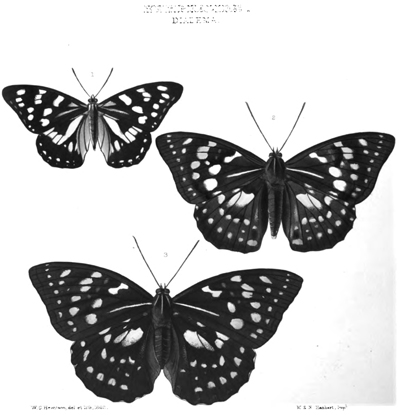
1. DIADEMA DIAGORAS.
2, 3. DIADEMA CHARONDA.
NYMPHALIDÆ.
DIADEMA.
DIADEMA DIAGORAS. 1.
UPPERSIDE. Female, dark brown with numerous white spots. Anterior wing with a triangular and linear spot at the base; crossed obliquely before the middle by three large spots, beyond the middle near the costal margin by a trifid spot, and toward the outer margin by an irregular band of five spots, and nearer the margin by some indistinct minute white spots. Posterior wing with a spot near the base of the costal margin, a large longitudinal spot from the base to beyond the middle occupying the whole of the cell: crossed transversely at the middle by five spots, three between the longitudinal spot and the costal margin, and two (one minute) between it and the abdominal fold: the abdominal fold (which is traversed by black, nervures) and a linear spot parallel to it also white: a marginal and submarginal band of white spots.
UNDERSIDE as above, except that the posterior wing has a white spot near the anal angle, and that the double row of spots are larger and lunular, and only separated by a black line.
Expan. 3 4/10 in. Hab. Japan.
In the Collection of W. C. Hewitson.
H
DIADEMA CHARONDA. 2, 3.
UPPERSIDE. Male, dark brown with numerous white and yellow spots; both wings from the base to the middle violet-blue. Anterior wing with a line of white from the base outwards: a bilobed spot within the cell and two large spots below it white: a transverse band of five spots beyond the middle, two spots near the apex, and a submarginal band of nine small spots, all pale yellow. Posterior wing with an indistinct spot at the base, two small spots and a large bifid white spot before the middle, followed by a curved transverse band of six pale yellow spots, by three minute spots towards the inner margin, by a submarginal band of six spots, and by two or three small marginal spots near the apex, all pale yellow; a semicircular carmine spot at the anal angle.
UNDERSIDE very pale green; anterior wing from the base to beyond the middle dark brown (black within the cell), with the spots as above, except that there is a white spot near the base, and three white spots between the bilobed spot in the cell and the transverse band: from the said band to the apex pale green marked by some ill-defined black spots: the outer margin with pale green lunular spots (one spot bifid); posterior wing pale green, with the spots of the upperside very indistinct.
Female differs little from the male: it is larger, is on the upperside without the blue, has the spots more deeply tinted with yellow, and is without the anal carmine spot: on the underside it is more deeply tinted with yellow.
Expan. ♂ 4½, ♀ 5 1/10 in. Hab. Japan.
In the Collections of W. W. Saunders and W. C. Hewitson.
This remarkable species was brought from Japan by Mr. Fortune, it bears considerable resemblance (especially the female) to Adolias Dirtea, but its very robust antennæ and great length of body determine its proximity to Diadema, and more especially to D. Assimilis, which it resembles also in having the anal carmine spot; in the position of the branches from the subcostal nervure it agrees with D. Nama of Doubleday, the only species in the first division of the subsection Hestina of Westwood, which has "the second branch of the subcostal vein arising close to the origin of the upper disco-cellular vein;" the other species D. Assimilis, Persimilis, and Consimilis, together with D. Diagoras of the plate, have the second branch arising considerably beyond the disco-cellular nervules—D. Charonda has the cell of both wings open. D. Nyctelius Doubleday of Westwood's second division of Hestina and D. Isa of Moore (Euripus Haliartus of Felder) must go with the genus Euripus.
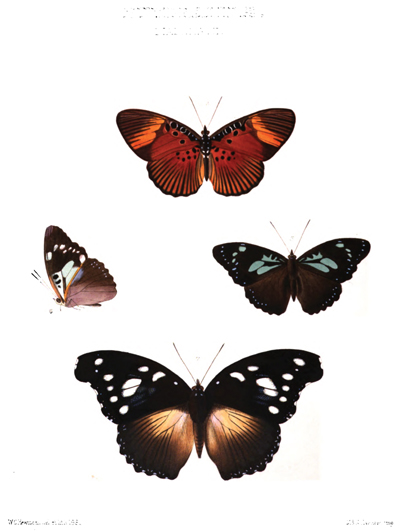
4. DIADEMA DOLOMENA.
5, 6. DIADEMA IMERINA.
7. DIADEMA DINARCHA.
NYMPHALIDÆ.
DIADEMA II.
DIADEMA DOLOMENA. 4.
UPPERSIDE. Female. Anterior wing dark brown traversed from the middle to the apex by rays of black; crossed beyond the middle by a band of rufous orange; a large semicircular rufous spot on the inner margin; six round black spots between the base and the middle, in two parallel lines of three spots each; the outer spots margined on both sides with white. Posterior wing rufous; the nervures from the middle to the outer margin, and rays between them, broadly black: marked near the base by eight round black spots.
UNDERSIDE as above, except that it is paler, and that the portion which is rufous or brick-red above is here rufous orange.
Exp. 2 9/10 inch. Hab. Old Calabar.
In the Collection of W. C. Hewitson.
The butterfly now figured being a female, I believed, at first, might be the other sex of D. Hirce of Drury which is a male; but having since received examples of D. Eurytus of Clerck, I find that they are the females of Hirce.
DIADEMA IMERINA. 5, 6.
UPPERSIDE. Female dark brown. Both wings with a submarginal band of minute white spots. Anterior wing with several spots of pale green; a tridentate spot at the base, two large oval spots below it, and a band of four spots beyond the middle. Posterior wing dark rufous brown.
UNDERSIDE as above, except that it is paler; the submarginal spots of the anterior wing larger; that the basal half of the posterior wing is lilac, almost white near the costal margin; the margin itself orange.
Exp. 2 6/10 in. Hab. Madagascar.
In the Collection of W. C. Hewitson.
DIADEMA DINARCHA. 7.
UPPERSIDE. Male blue-black. Anterior wing with several white spots; three spots near the base of the costal margin (two in the cell); two larger spots and some blue irrorations near the middle; a band of six spots (the second minute) towards the outer margin; some very minute white spots near the outer margin; the margin itself intersected with white. Posterior wing dark rufous brown, with a large spot of orange-yellow before the middle: the nervures, and rays between them and the outer margin blue-black; a submarginal band of minute white spots in pairs; the margin dentated, spotted with white.
UNDERSIDE as above, except that it is paler; that the anterior wing has two white spots at the base, and two white spots adjoining the third spot described above; and that the minute white spots composing the submarginal band of both wings are here more distinct, and very beautifully arranged in groups each of four spots.
Exp. 4 in. Hab. Old Calabar.
In the Collection of W. C. Hewitson.
Unlike any other species; but with a resemblance to D. Dubia.
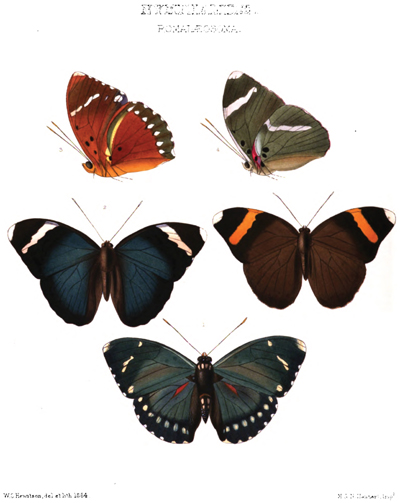
1, 3. ROMALÆOSOMA ZAMPA
2, 4. ROMALÆOSOMA LUPERCA.
5. ROMALÆOSOMA LOSINGA.
NYMPHALIDÆ.
ROMALÆOSOMA.
ROMALÆOSOMA ZAMPA. 1, 3.
Romalæosoma zampa, Westwood in "Genera of Diurnal Lepidoptera," page 284.
UPPERSIDE. Male, glossy green, with white lunular spots on the outer margins. Anterior wing crossed beyond the middle by a narrow broken pale rufous band: the apex and a spot at the anal angle, white. Posterior wing with the base black, a red spot within the cell, the outer margin broadly dark green traversed by a band of seven round white spots.
UNDERSIDE orange rufous, the outer margins green, the band and spots as above. Anterior wing with three black spots within the cell, and a fourth indistinct spot on the upper disco-cellular nervule: the anal angle (bordering the spot) purple. Posterior wing with two black spots near the base, and a longitudinal band of pale green—yellow near and parallel to the costal margin.
Expan. 3 2/10 inch. Hab. Sierra Leone.
In the Collection of the British Museum.
ROMALÆOSOMA LUPERCA. 2, 4.
UPPERSIDE. Male, dark blue green. Anterior wing with the apical half blue-black crossed obliquely by a band of rufous white: the apex white. Posterior wing with the inner margin broadly brown; the outer margin blue-black.
UNDERSIDE green. Anterior wing, with the costal margin, the band, and apex white: three black spots bordered with white (in a line) within the cell. Posterior wing with the base carmine, followed by a band of white and two black spots bordered with white: crossed obliquely from the middle of the costal margin by a band of white which terminates before the middle of the outer margin: the inner margin rufous.
Expan. 3 2/10: inch. Hab. Calibar.
In the Collection of W. C. Hewitson.
ROMALÆOSOMA LOSINGA. 5.
UPPERSIDE. Male, rufous brown. Anterior wing with the apical half dark brown crossed obliquely by a band of orange: the apex white: the base of the costal margin lilac.
UNDERSIDE pale green, clouded with brown: the base of the costal margin, the band (which is rufous near the outer margin of the wing), and the apex white: three black spots(forming a triangle) within the cell: the inner margin lilac. Posterior wing crossed obliquely from the middle of the costal margin by a band of white which terminates a little below the centre of the wing: a single black spot within the cell: a submarginal band of indistinct brown spots.
Expan. 1/0 2 9/10, 0/1 3 6/10 inch. Hab. Congo.
In the Collection of the British Museum.
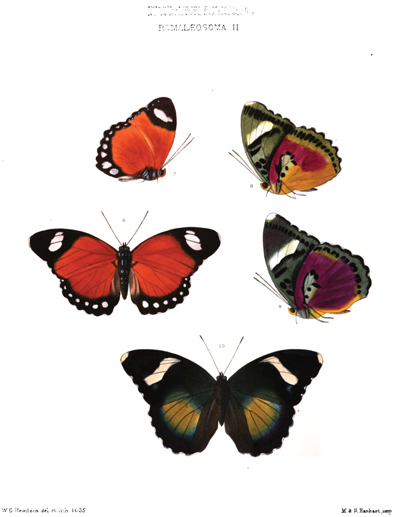
6, 7. ROMALÆOSOMA RUSPINA.
8, 9. 10. ROMALÆOSOMA XYPETE.
NYMPHALIDÆ.
ROMALÆOSOMA. II.
ROMALÆOSOMA RUSPINA. 6, 7.
UPPERSIDE. Male (Fig. 7) brick-red; the costal and outer margins black; the apex broadly black with an oblong trifid white spot. Posterior wing with the outer margin broadly black, traversed by a band of seven white spots.
UNDERSIDE as above, except that there are two or three obscure white spots below the apex, and that the border of the abdominal fold is white.
Female differs only in form, and in having the apical white spot larger.
Exp. ♀ 2 8/10, ♀ 3½ inches. Hab. Old Calabar.
In the Collection of W. C. Hewitson.
This species, although very closely allied to R. Eleus, is abundantly distinct. The posterior wing is of a different form; the apical white trifid spot of R. Ruspina is, inEleus, a band divided into three or four parts. On the underside the difference is more apparent. In this species, the apex of the anterior wing, and the outer margin of the posterior wing, are dark brown, with the inner border sharp and clearly defined: in R. Eleus they are rufous-brown (in some examples not much darker than the rest of the wing) without a defined boundary. Eleus has the costal margin of the posterior wing broadly white, the new species is without it.
ROMALÆOSOMA XYPETE. 8, 9, 10.
UPPERSIDE. Male (Fig. 8) dark blue-black, Anterior wing with an oblique band beyond the middle and the apex white; the inner margin marked by a spot of green. Posterior wing with a large central spot of green or ochreous-blue.
UNDERSIDE. Both wings with the outer margin brown spotted with white, and a submarginal band of black, narrower and broken into spots (in pairs), on the posterior wing. Anterior wing green; the band and apex white, as above: four spots at the base (three of them round); a short band at the end of the cell; a longer band at the middle of the wing, forming the inner border of the white band; and the inner margin all blue-black. Posterior wing with the costal margin and centre carmine; the outer margin broadly green; the inner margin broadly ochreous: a pale green spot near the base, marked with two spots of blue-black: bordered above with black, and below by three spots of the samecolour.
Female differs only in the larger space of roseate colouring of the posterior wing, and its generally darker hue.
Without excepting even Agrias or Catagramma, this genus is, I think, the most gorgeousof all the Lepidoptera; combining as it does the greatest contrast of colouring with, at the same time, the most exquisite and harmonious blending. The species now figured resembles several others on the upperside, but surpasses them all below.
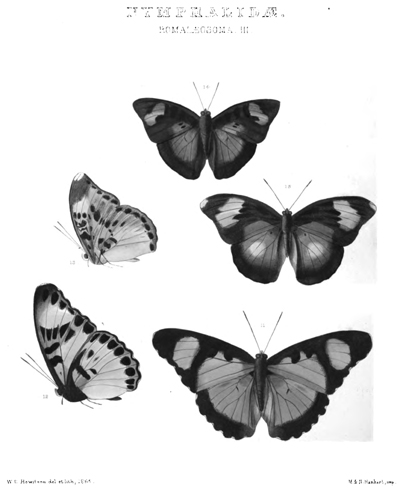
11, 12. ROMALÆOSOMA ADONINA.
14, 15. 16. ROMALÆOSOMA CUTTERI.
NYMPHALIDÆ.
ROMALÆOSOMA. III.
ROMALÆOSOMA ADONINA. 11, 12.
UPPERSIDE. Female ochreous-yellow, broadly bordered with dark brown: the base of both wings carmine. Anterior wing with a black spot in the cell; the outer half dark brown, with a large quadrifid spot of ochreous-yellow. Posterior wing with an oblong spot of brown at the end of the cell.
UNDERSIDE green-yellow. Both wings with the margins dark brown, the outer margins with lunular white spots; both with a submarginal band of conical blue-black spots; both with a spot of carmine near the base. Anterior wing with a minute brown spot on the carmine, two blue-black spots in the cell, and a transverse band of five conical spots beyond the middle, four of which are dark brown, the fifth irrorated with yellow and indistinct. Posterior wing with the base and four spots beyond the carmine blue-black.
Expan. 3 8/10 inch. Hab, Old Calabar.
In the Collection of W. C. Hewitson.
This may be a variety of R. Themis. On the upperside the difference is one of colour only. On the underside the carmine at the base of the posterior wing is in R. Themis nearer to the base.
ROMALÆOSOMA CUTTERI. 13, 14, 15.
UPPERSIDE. Male dark brown. Anterior wing with several undefined black spots near the base; a large ochreous clouded oblique spot near the apex, and a spot of green (marked by two black spots) before the middle of the inner margin. Posterior wing with the centre green marked at the end of the cell by a black linear spot.
UNDERSIDE. Anterior wing green-brown: the cell blue-green, with three spots and a line of blue-black: two spots of brown below them; crossed at the middle by a band of four black spots, and beyond them by a spot of pale yellow. Posterior wing green-yellow clouded with brown at the apex; the base yellow, followed by seven black spots and a transverse broad band of brown; both wings with a submarginal band of brown spots.
B B
Female like the male on the upperside, except that the anterior wing has the oblique spot beyond the middle yellow and much larger: the green spot on the inner margin larger and an apical spot of white, that the green of the posterior wing has its centre yellow, and that on the underside the anterior wing has a band of three dark brown spots between the median nervules.
Expan. ♀ 2½, ♀3 inch. Hab. Old Calabar.
In the Collection of W. C. Hewitson.
I have pleasure in naming this species after Mr. Cutter and his family, by whose zeal entomological knowledge and my own Collection have been, and I trust will yet be, greatly enriched. This species is especially interesting, because, though clearly belonging to this genus, it has altogether the aspect of an Euryphene.
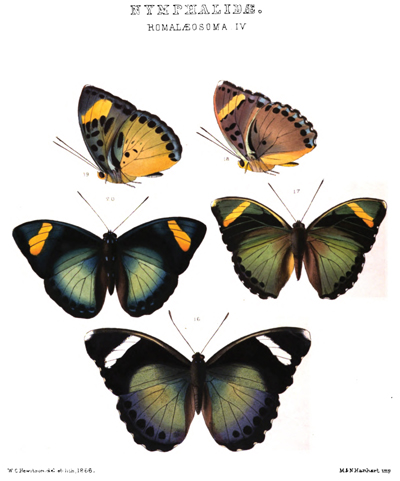
15 17, 18. ROMALÆOSOMA REZIA.
19, 20. ROMALÆOSOMA RAVOLA.
NYMPHALIDÆ
ROMALÆOSOMA IV.
ROMALÆOSOMA REZIA. 16,17,18.
UPPERSIDE. Male, green, with the outer margins broadly brown. Anterior wing crossed obliquely from near the base to the outer margin by a broad band of dark brown; crossed obliquely beyond the middle by a quadrifid band of orange yellow; the apex white; three small submarginal black spots near the apex. Posterior wing with a submarginal band of dark brown spots.
UNDERSIDE grey-green. Both wings with the outer margins rufous-brown, both with a submarginal band of black spots. Anterior wing with the orange-yellow band as above; three black spots within the cell, two at the end of the cell, and four on the inner border of the said band. Posterior wing with the base pale yellow bordered inwardly with black, and below it a spot and band of black.
Female, blue-black on the upperside, with the inner margin of the anterior wing and the centre of the posterior wing green. Anterior wing with an oblique band beyond the middle and the apex, white; posterior wing with a submarginal band of large black spots. On the underside like the male, except that it is of a rufous-grey, that the band of the anterior wing is white, and that the short black band of the posterior wing forms the upper border of a spot of white which is marked by a black spot.
Expan. ♂ 3, ♀ 3 8/10 inch. Hab. Gaboon.
In the Collections of W. W. Saunders and W. C. Hewitson.
This, though quite distinct from any described species, has considerable resemblance to the one which is figured on the same plate.
F F
ROMALÆOSOMA RAVOLA. 19, 20.
UPPERSIDE. Male, blue-black; the inner margin of the anterior wing and the posterior wing green; anterior wing crossed obliquely beyond the middle by a band of orange bordered on each side with green. Posterior wing with a submarginal row of black spots; the outer margin brown.
UNDERSIDE. Anterior wing green clouded with brown, the band of orange as above; three large spots within the cell, two at the end of the cell, five forming a transverse band in the middle and a band of indistinct submarginal spots, all black. Posterior wing ochreous and orange-yellow, green near the base, where it is marked by a bifid band of black, and below it by a shorter band, by two spots within and one at the end of the cell, and below these by three indistinct spots of the same colour; a submarginal band of eight large black spots; the outer margin brown.
Expan. 3 3/10 inch. Hab. Old Calabar.
In the Collection of W. C. Hewitson.
This species is easily known from all those most nearly allied to it, by having its body very robust, and spotted with white, and comes into Mr. Westwood's first section of the genus with R. Zampa, and Perseis.
My specimens of R. Ravola differ a good deal from each other: one has the orange band of the anterior wing much less oblique than that which is figured and of different form; on the underside it is much more green, and the spots, though most of them are indicated, are obscure and undefined.
It may possibly be only a variety of R. Zeuxis, but in all the other species which have the white spots on the body both sexes are thus marked. My examples of R. Zeuxis have no such white spots.
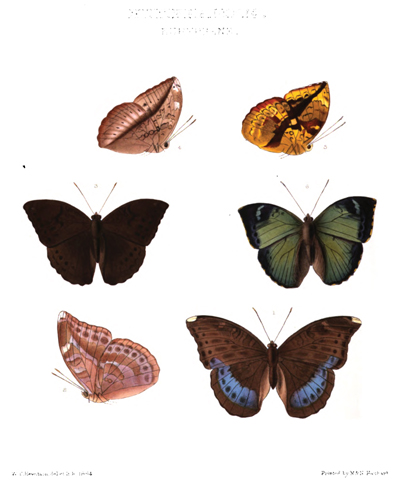
1, 2. EURYPHENE SOEMIS.
3, 4. EURYPHENE THEOGNIS.
5, 6. EURYPHENE LESBONAX.
NYMPHALIDÆ
EURYPHENE.
EURYPHENE SOEMIS. 1, 2.
UPPERSIDE rufous-brown. Anterior wing with some spots within the cell: a rufous spot near the costal margin, beyond the middle: a white spot at the apex: a lilac spot at the anal angle, and two submarginal bands of dark brown spots. Posterior wing, darker brown tinted with purple: crossed beyond the middle by a broad band of lilac traversed by a line of dark brown spots.
UNDERSIDE lilac grey, with rufous bands and spots. Both wings crossed at the middle by a broad rufous band, and beyond it by a band of spots and a sub-marginal band of the same colour. Anterior wing with a spot in the cell: a spot on the costal margin beyond the middle, and a bifid spot at the apex all white: two rufous spots in the cell. Posterior wing, with one rufous spot in the cell.
Expan. 2 9/10 inch. Hab. Ashanti.
In the Collection of the British Museum.
This butterfly resembles in the white apex of the anterior wings, some of the species of Roma-læosoma. There is a variety in which the underside is much more tinted with green.
EURYPHENE THEOGNIS. 3, 4.
UPPERSIDE. Male dark rufous-brown; both wings crossed beyond the middle by a band of spots and submarginal band of dark brown. Anterior wing with some spots in and at the end of the cell, and a small rufous white spot near the apex.
UNDERSIDE pale lilac white and grey brown; both wings crossed near the middle by a common band of darker brown: both wings with spots in the cell and linear spots beyond them: both with a series of indistinct spots beyond the central band, and two obscurely marked submarginal bands of brown.
Expan. 2 4/10 in. Hab. Ashanti.
In the Collection of the British Museum.
This species is very nearly allied to E. Senegalensis: the anterior wings are more acute at the apex, and the posterior wings are more regularly rounded. On the underside they scarcely differ. Some of the species of this genus either vary much, or, like Adolias, possess only slight specific distinction. This can only be determined by the examination of numerous examples which do not yet exist in our collections.
EURYPHENE LESBONAX. 5, 6.
UPPERSIDE glossy green; the outer margins pale brown. Anterior wing with the apical half purple, crossed near the costal margin by a short band of green, and near the outer margin by a band of indistinct black spots. Posterior wing with the outer margin purple, broadest near the apex, where it is marked by two or three black spots.
UNDERSIDE orange-yellow, clouded with darker colour. Both wings crossed by a common band of red brown, tinted on the anterior wing with purple, marked on the posterior wing at the costal margin by a pale yellow spot: both wings with a submarginal zigzag band of black: both rufous from the apex to the middle of the outer margin. Anterior wing with a broad bifid band of red brown near the base, and beyond it several zigzag black lines. Posterior wing with some small spots near the base, and a central rufous spot beyond the band, with, between it and the costal margin, three small lunular spots of the same colour, followed by a band of black linear spots.
Expan. 2 3/10 in. Hab. Niger.
In the Collection of the British Museum.
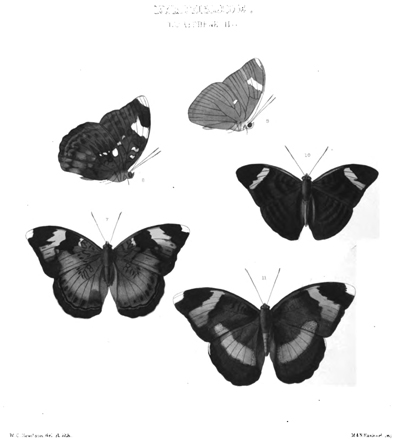
7, 8. EURYPHENE PHRANZA
9, 10. 11. EURYPHENE PHANTASIA
NYMPHALIDÆ.
EURYPHENE II.
EURYPHENE PHRANZA. 7, 8.
UPPERSIDE. Female dark brown. Anterior wing with two circular black spots, a small white spot and a black line within the cell; crossed beyond the middle by an oblique band of orange-yellow, clouded at its lower extremity and marked by three black spots; the apex white: a spot of blue at the middle of the inner margin. Posterior wing with three circular spots within the cell; crossed at the middle by as band of green, followed by some indistinct oblong black spots and a submarginal black line.
UNDERSIDE brown. Anterior wing brown, paler towards the outer margin, where it is crossed by two indistinct macular bands; the base, two small spots within the cell, a large spot beyond the middle of the costal margin, the apex, a minute spot near it, and two spots near the middle of the inner margin, all white. Posterior wing with the base brown; the outer half grey, crossed by two macular bands and an undulated line of rufous brown: two circular spots and a line of black within the cell; a spot before the middle of the costal margin, and near it three smaller spots of white.
Exp. 2 9/10 inch. Hab. Old Calabar.
In the Collection of W. C. Hewitson.
It will be seen that the females of the two species now described scarcely differ from each other on the upperside, and are nearly related to E. Soemis of a former Plate.
X
EURYPHENE PHANTASIA. 9, 10, 11.
UPPERSIDE. Male brown crossed by several obscure bands of darker brown. Anterior wing with some indistinct spots in and below the cell; crossed obliquely near the apex by a band of orange yellow. Posterior wing crossed by four obscure bands of dark brown.
UNDERSIDE green clouded. Anterior wing with the band as above, but with its upper half white: the base and a spot at the apex also white. Posterior wing with some very indistinct bands and spots of brown, and a small lilac-white spot before the middle of the costal margin.
Female dark brown. Anterior wing crossed beyond the middle by an oblique irregular band of orange yellow marked by two or three ill-defined black spots; the apex white: a spot of blue on the inner margin, below the middle. Posterior wing crossed at the middle by a curved band of blue, in continuation with the blue spot of the anterior wing. On the underside it does not differ from the male, except in having a small white spot within the cell of the anterior wing, and a similar spot (bisected by the first discoidal nervure) on the posterior wing. Both of these spots are indicated (but scarcely visible) in the male.
Exp. ♀ 2½, ♀ 3 3/10 inch. Hab. Old Calabar.
In the Collection of W. C. Hewitson.
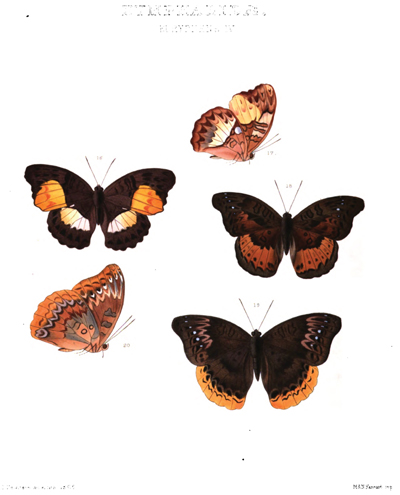
16, 17. EURYPHENE ARAMIS
18, 19, 20. EURYPHENE DORALICE
NYMPHALIDÆ.
EURYPHENE. IV.
EURYPHENE ARAMIS. 16, 17.
UPPERSIDE. Female dark brown. Anterior wing with a large spot of orange, touching the anal angle, covering one-third of the wing, and marked with three indistinct rufous spots; the cell crossed by four bands of black; a submarginal band of four conical black spots from the apex to the orange spot. Posterior wing crossed before the middle by a broad band of white tinted with orange, and by a submarginal band of conical black spots.
UNDERSIDE as above, except that it is rufous and that there is a pale spot at the end of the cell of the anterior wing and a round white spot before the middle of the costal margin of the posterior wing.
Expan. 2 11/20 inch. Hab. Old Calabar.
In the Collection of W. C. Hewitson.
EURYPHENE DORALICE. 18, 19, 20.
UPPERSIDE. Male rufous-brown. Anterior wing with three spots in the cell and some spots below them dark brown, followed by a rufous spot, a band of five minute white spots from the costal margin to the middle, and by two submarginal bands of black spots. Posterior wing with two black spots near the base; crossed beyond the middle by a broad band of rufous-orange traversed by a band of black spots and bordered outwardly with black.
UNDERSIDE as above, except that it is rufous; that the anterior wing has some pale spots in the cell, a white spot beyond the middle of the costal margin and at the apex, and that the minute white spots of the upperside are larger, and encompass some of the black spots of the inner submarginal band; that the posterior wing has a third spot near the base, and a submarginal band of pale conical spots.
Female like the male on the upperside, except that the anterior wing is crossed at the middle by a band of pale conical spots; that the posterior wing has no transverse band of rufous-orange, but is broadly bordered by the same colour, traversed by zigzag black spots, and bordered inwardly by lunular spots of the same colour. On the underside the difference between the sexes is very slight.
Expan. ♂ 2 6/10, ♀ 2 9/10 inch. Hab. Old Calabar.
In the Collection of W. C. Hewitson.
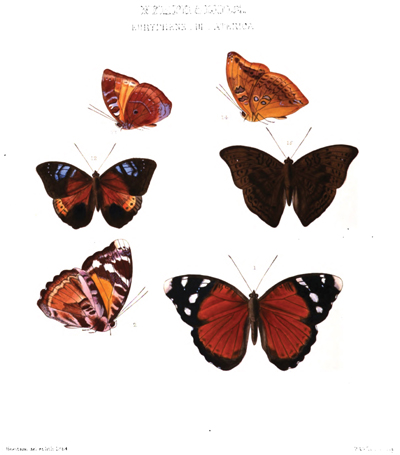
12, 13. EURYPHENE MILNEI
14, 15. EURYPHENE PLAUTILLA.
1, 2. ATERICA ATOSSA
NYMPHALIDÆ.
EURYPHENE III. ATERICA.
EURYPHENE MILNEI. 12, 13.
UPPERSIDE. Male dark brown. Anterior wing rufous at the base; crossed near the middle of the costal margin by three short bands of blue (one within the cell), crossed near the apex by four minute white spots. Posterior wing rufous at the base and costal margin, with, near the apex, a short band of three orange spots, each marked by a black spot: a large spot towards the anal angle of blue-black.
UNDERSIDE rufous. Both wings crossed beyond the middle by a band of minute black and white spots. Anterior wing below the median nervure orange yellow: marked in the cell by two white spots, and at the middle of the margin by a third similar white spot. Posterior wing with the base darker, marked by a black spot: crossed before the middle by an indistinct lilac band: the apex lilac-white.
Exp. 2 1/10 inch. Hab. Old Calabar. In the Collection of W. C. Hewitson.
I have named this singular species after Mr. Milne, to whom I feel greatly indebted for the pleasure of possessing the many beautiful new butterflies figured in the accompanying Plates.
EURYPHENE PLAUTILLA. 14, 15.
UPPERSIDE. Male dark rufous brown. Both wings crossed by two submarginal bands of black spots. Anterior wing with two spots near the costal margin bordered with black (one within the cell), and beyond them four spots of black; marked beyond the middle by a minute white spot. Posterior wing dark brown, with a spot at the end of the cell, and two transverse bands of black spots: the outer margin broadly rufous.
UNDERSIDE rufous in the centre, rufous orange near the margins. Anterior wing with the two spots as above, in and at the end of the cell: crossed obliquely near
the outer margin by a rufous band, marked with black spots: the apex irrorated with white, marked by black spots. Posterior wing with three spots near the base, bordered with black: crossed beyond them by four macular bands of rufous brown: near the apex a lilac spot, bordered with black.
Exp. 2 4/10 inch. Hab. Old Calabar.
In the Collectious of M. Doumet and W. C. Hewitson.
ATERICA ATOSSA. 1, 2.
UPPERSIDE. Female brick red. Anterior wing with the outer half blue-black, crossed by an oblique band of three white spots: the apex and three spots near it also white. Posterior wing with the margin broadly dark brown, and near it a band of very obscure brown spots.
UNDERSIDE. Anterior wing as above, except that it is much paler, that it has some rufous bands in the cell, and some lunular white spots beyond the middle. Posterior wing rufous: the base rufous brown, marked by spots and bands of white and brown, crossed longitudinally by a broad band of rosy white, which is continued nearly to the apex: the apex white: a submarginal band of hastate spots: the outer margin dark rufous brown.
Exp. 3 1/10 inch. Hab. Old Calabar.
In the Collection of W. C. Hewitson.
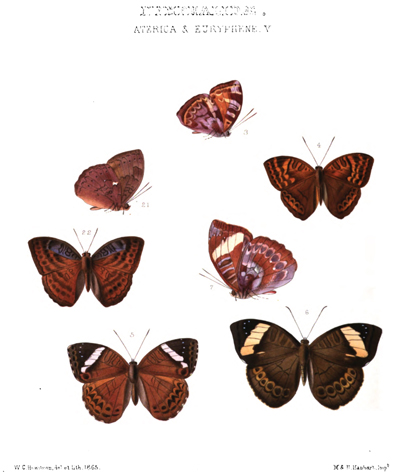
3, 4. 5. ATERICA AMPEDUSA.
6, 7. ATERICA ARIDATHA
21, 22. EURYPHENE TENTYRIS.
NYMPHALIDÆ
ATERICA AND EURYPHENE.
ATERICA AMPEDUSA. 3,4,5.
UPPERSIDE. Male rufous-brown. Anterior wing with the outer half dark brown; the cell rufous, marked by two brown spots bordered with black; crossed at the middle and beyond it by three rufous bands. Posterior wing crossed at the middle by an indistinct band of brown, and beyond the middle by a broad rufous band traversed by a band of lunular spots, and below them by a second band of oblong spots.
UNDERSIDE nearly as above, but paler; anterior wing with the transverse bands, and the spaces between them, near the costal margin and the apex, white or lilac; posterior wing clouded with lilac: crossed longitudinally near the costal margin by a band of paler colour.
Female like the male, except that the anterior wing is crossed obliquely near the middle bya band of white, that there is between it and the apex a curved band of four minute white spots, and that the apex is white and the outer margin spotted with white.
Expan. ♀ 1 8/10, ♀ 2 2/10 inch. Hab. Old Calabar.
In the Collection of W. C. Hewitson.
This is, I have little doubt, the P. Auge of Donovan's "Insects of India," plate 36, but does not at all agree with the Fabrician descripton "fasciis viridibus."
ATERICA ARIDATHA. 6, 7.
UPPERSIDE. Female rufous-brown. Anterior wing, except near the base, dark brown: the cell marked by four bands of darker brown; crossed beyond the middle by a broad band of yellow with between it and the apex a curved band of four minute white spots; a submarginal band of dark brown. Posterior wing crossed before the middle by a band of dark brown, and beyond the middle by a band of oblong ochreous spots with their centre and lower border dark brown.
UNDERSIDE as above, except that it is paler, the spots in the cell of the anterior wing bordered with lilac: that the base of the posterior wing is rufous-brown, marked in its middleand outer border by spots of lilac and white; that the spots of the band are marked at their upper extremities with white; and that the outer margin is spotted with white.
Expan. 2½ inch. Hab. Old Calabar.
In the Collection of W. C. Hewitson.
C C
ATERICA ABASA.
UPPERSIDE. Female obscure rufous-brown. Anterior wing with some bands of darker brown in the cell; crossed obliquely beyond the middle by a quinquefid band of ochreous yellow and near the apex by four minute white spots. Posterior wing crossed before the middle by an obscure band of darker brown, and beyond the middle by a band of obscure pale brown conical spots with their centres and lower border brown.
UNDERSIDE as above, but slightly paler; the base of the posterior wing to the first band rather darker than the rest of the wing; the band of conical spots scarcely seen, their upper extremities represented by a nearly straight line of white spots.
Expan. 2 7/10 inches. Hab. Old Calabar.
In the Collection of W. C. Hewitson.
Very closely allied to A. Aridatha, from which it differs in its very obscure colouring, the greater length and different shape of the band of the anterior wing, the position of the minute white spots which are nearer the apex; and on the underside by wanting the lilac and white spots which adorn the other species.
EURYPHENE TENTYRIS. 21, 22.
UPPERSIDE. Male brown. Both wings crossed at and beyond the middle by three oblique rufous bands. Anterior wing tinted with blue near the costal margin: the cell marked by spots and lines of black; posterior wing with two spots in the cell bordered with black.
UNDERSIDE rufous, crossed by the bands as above, but much less distinct, the second and third composed of minute spots: posterior wing with a dentate white spot before the middle of the costal margin, and a minute spot of the same colour lower down.
Expan. 1 9/10 inch. Hab. Old Calabar.
In the Collection of W. C. Hewitson.
I think that this may prove to be the male of E. Absolon.
EURYPHENE OXIONE.
UPPERSIDE. Male rufous-brown. Both wings crossed by three rufous waved bands. Anterior wing with three lines and a bifid spot of dark brown within the cell, a similar bifid spot at the end of the cell, and a short rufous band near the base: posterior wing with a rufous band near the base.
UNDERSIDE rufous: some of the bands of the upperside indicated by curved lines and spots indistinctly seen. Both wings crossed (from the apex of the anterior wing to the middle of the inner margin of the posterior wing) by a common straight rufous-brown band.
Expan. 2 2/10 inch. Hab. Old Calabar.
In the Collection of W. C. Hewitson.
Very nearly allied to E. Absolon, from which it differs in the greater obscurity of colouring of the upperside and the band of the underside.
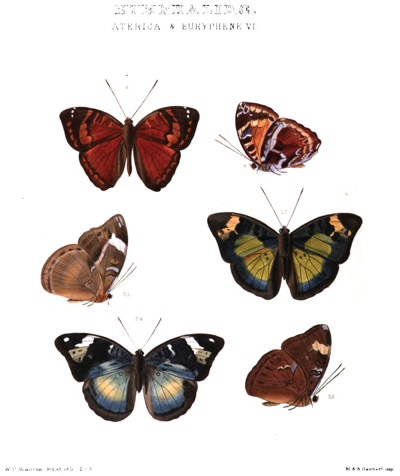
8, 9. ATERICA AMAXIA.
23, 24. 25, 26. EURYPHENE ELIENSIS.
NYMPHALIDÆ
ATERICA AND EURYPHENE VI
ATERICA AMAXIA. 8, 9.
UPPERSIDE. Male rufous. Anterior wing with the outer half dark brown; two bands in the cell, a similar band beyond the cell, a broad transverse band beyond the middle, and a submarginal band of spots all rufous, paler than the rest of the wing; a band of three white spots before the apex. Posterior wing with the outer margin brown, traversed by a band of pale rufous spots.
UNDERSIDE rufous. Anterior wing with the basal half rufous-orange; the costal margin, threespots within the cell and a transverse band beyond the middle, all rufous-brown, bordered with grey-white; the central rufous band as above; a spot of lilac-grey at the middle of thecostal margin, and a band of the same colour towards the outer margin, bordered outwardly with small lunular white spots. Posterior wing with the submarginal band of spots as above: a longitudinal lilac-white band parallel to the costal margin: the costal margin dark rufous-brown, clouded with lilac, three short bands of dark rufous-brown, bordered with lilac-white below, near the inner margin; a spot of dark rufous-brown before the middle of the wing.
Expan. 2½ inch. Hab. Old Calabar.
In the Collection of W. C. Hewitson.
The antennæ of this species are very remarkable for their great length.
EURYPHENE ELIENSIS. 23, 24, 25, 26.
UPPERSIDE. Male dark brown. Anterior wing crossed beyond the middle by an oblique ochreous band, clouded and spotted with brown as it approaches the outer margin; crossed transversely by a broad band of obscure golden green; the cell crossed by bands of blue-black. Posterior wing obscure golden green, with two or three brown spots within the cell; the outer and inner margins broadly brown.
UNDERSIDE rufous, clouded with brown. Both wings with a submarginal band of brown. Anterior wing crossed within the cell by two pale yellow or lilac bands, and beyond the middle by a short broad band of the same colour; a small round spot, a bilobed spot between the bands, and a spot at the end of the cell bordered with black; an apical grey spot. Posterior wing glossed with lilac, with some indistinct conical brown spots above the submarginal band; an oblique white spot on the middle of the costal margin, and below it two similar white spots; a minute black spot and two small spots bordered with black within the cell.
Female (Figs. 23, 24), like the male, except that it is darker: the band across the apex more distinct, white: that there is a subapical white spot, and that the transverse green band is reduced to an oblong spot upon the inner margin. Posterior wing with its centre ochreous-yellow. Underside like the male, except that it is of a different tint of colour; that the band near the costal margin is less oblique and higher up, and has no second band below it.
Expan. 3 inches. Hab. Gaboon.
In the Collection of W. C. Hewitson.
This butterfly scarcely differs on the upperside from the species which I have figured as Roma-læosoma Cutteri.
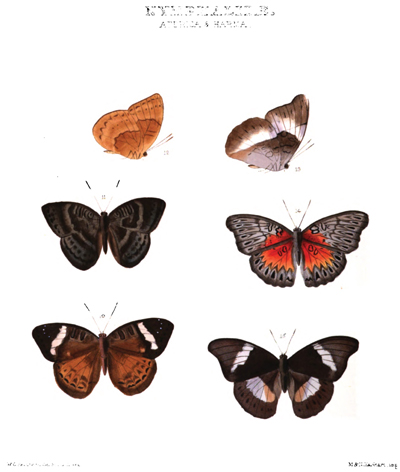
10, 11, 12. ATERICA TADEMA.
13, 15. HARMA INDAMORA.
NYMPHALIDÆ.
ATERICA AND HARMA.
ATERICA TADEMA. 10, 11, 12.
UPPERSIDE. Male, green-brown, with bands of paler colour. Anterior wing with a round spot within the cell, a band below it, two parallel bands across the cell, one at the end of the cell, a transverse curved band at the middle, and a submarginal band (having its outer border dark brown) all pale green. Posterior wing with a band of green before the middle and a broad band of the same colour beyond the middle traversed by a band of brown spots and bordered outwardly with dark brown.
UNDERSIDE ochreous yellow, darkest near the base; both wings crossed before the middle by a pale rufous band (not continuous), both with a band of small brown spots beyond the middle and a submarginal band of rufous spots. Anterior wing with rufous lines in the cell; posterior wing with a black spot.
Female, rufous. Anterior wing, with the basal half rufous brown, two brown spots within the cell with rufous border and a pale bifid spot on the inner margin beyond the middle; the outer half dark brown, crossed by an oblique band of white, four minute white spots, and a submarginal band of dark brown. Posterior wing rufous, darker near the base which is marked with some lines of brown; crossed beyond the middle (as the male is) by a broad band of paler colour, marked by hastate brown spots, and bordered outwardly by lunular spots of darker brown. Underside as above, but paler and more obscure, except that the posterior wing has a brown spot near the end of the cell.
Expan. ♂ 2 3/20 ♀ 2 9/20 inch. Hab. Old Calabar.
In the Collections of W. W. Saunders and W. C. Hewitson.
The butterfly now figured may be only a variety of A. Veronica of Cramer, from which it however differs very considerably; whilst Veronica is almost as bright in colour as A. Afer (without the brilliant blue) A. Tadema is on the upperside of an obscure green without the apical white spots. On the underside it is much paler than Veronica, has the band of the posterior wing nearer the base, and is always marked in the cell by a distinct black spot. E. Cærulea, of Boisduval, which he has kindly lent me for comparison, resembles Veronica more closely than Tadema and is also without the apical white spots.
HARMA INDAMORA. 13, 15.
UPPERSIDE. Female, dark brown, paler on the posterior wing. Each wing crossed at the middle by an oblique band of white. Posterior wing with a submarginal row of dark brown spots.
UNDERSIDE as above, except that it is much paler, that there are zigzag lines of brown near the base of both wings and that they are both crossed obliquely, a little before the middle, by a linear, nearly continuous, band of brown.
Expan. 2 6/10 inch. Hab. Old Calabar.
In the Collection of W. C. Hewitson.
I have to lament the death of Mr. Milne, from whom I have received so many new and beautiful butterflies.
HARMA SANGARIS. ♀ 14.
♂ Nymphalis Sangaris, Lucas, Lépidoptères Exotiques, Plate LXIX.
UPPERSIDE. Female, grey-brown; the base of the anterior wing, and the basal half of the posterior wing, scarlet; both wings with some black spots within the cell, both traversed by a submarginal band of conical dark brown spots, bordered with paler colour and crowned on the posterior wing by hastate spots of grey-brown.
UNDERSIDE as above, except that it is nearly white, with the basal half pale rufous; that both wings are crossed before the middle by a curved linear band of rufous brown; that the posterior wing has a bifid white spot before the middle of the costal margin, and that the conical spots of the upperside are here represented by linear spots.
Expan. 2 9/20 inch. Hab. Old Calabar.
In the Collection of W. C. Hewitson.
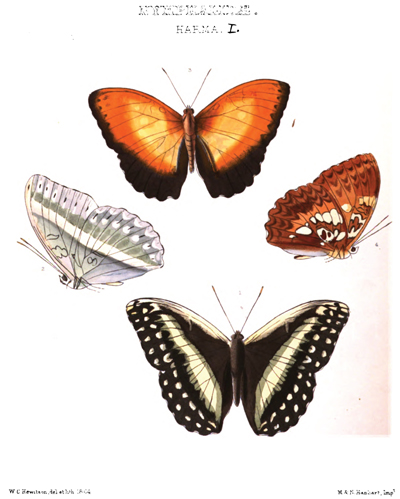
1, 2. HARMA HEMERESIA
3, 4. HARMA THEODOTA.
NYMPHALIDÆ.
HARMA. I.
HARMA HEMERESIA. 1, 2.
UPPERSIDE. Male dark brown. Both wings crossed at the middle by a straight band of pale yellow, bordered on both sides with green, broken into lunular spots near the apex of the anterior wing, broadest on the posterior wing; both wings crossed, between this band and the outer margin, by two parallel bands of pale yellow spots. Anterior wing with the costal margin broadly yellow.
UNDERSIDE pale green: the central band as above: the bands of spots indistinct, with between them a row of linear black spots; the base of both wings with irregular spots like those of Adolias within the cell.
Expan. 3 6/10 in. Hab. Calabar.
In the Collection of W. C. Hewitson.
There is a variety of this very remarkable species, in which the bands and spots, and costal margin are all of a grey white.
S
HARMA THEODOTA. 3, 4.
UPPERSIDE. Male rufous orange; both wings crossed before the middle by a band of paler colour: both wings with the outer margin brown (narrow on the anterior wing, broad on the posterior); both with a submarginal band of lunular black spots.
UNDERSIDE rufous brown; both wings with several irregular spots of white (some tinted with yellow) from the base to the middle: both with three bands of conical spots between the middle and the outer margin; anterior wing with some irregular spots in the cell, as in the genus Adolias.
Expan. 3 2/10 in. Hab. Calibar.
In the Collection of W. C. Hewitson.
Mr. Doubleday put the species of this genus with Adolias, and, except in general appearance, there is very little to divide them and the neighbouring genera from it, or from each other. Euryphene and Harma come very near together, as is shown by the similarity of the undersides of Harma Theodota and Euryphene Lesbonaz; Euryphene is very close to Aterica, and Euryphene Soemis bears a near resemblance to two of the species of Romalæosoma, which I have figured, to R. Luperca and R. Losinga.
The butterfly figured by Herrich Schäeffer in his Aussereuropaischer Schmetterlinge, Fig. 8, belongs to this genus.
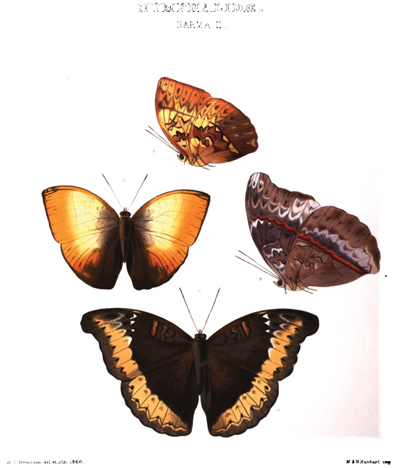
5, 6. HARMA HYARBITA.
7, 8. HARMA HYPATHA.
NYMPHALIDÆ.
HARMA II.
HARMA HYARBITA. 5, 6.
UPPERSIDE. Male. Anterior wing, with the base brown; the centre yellow; the apex and outer margin broadly orange. Posterior wing, with a space on the costal margin, yellow; a space below it (which is marked by two or three black spots) orange; the inner half of the wing and the outer margin dark brown.
UNDERSIDE yellow, rufous, and rufous-brown. Both wings crossed at the middle by a narrow common band of brown, succeeded on the anterior wing and near the apex of the posterior wing by two bands of hastate rufous-brown spots, and by a submarginal band of black spots, some of which are sagittate. Anterior wing, with the costal margin at the base, rufous: a black spot at the base of the cell, a lobed rufous spot bordered with black at the middle, a rufous spot at the end of the cell with a zigzag black line on each side of it. Posterior wing crossed before the middle by a broad dentate rufous-brown band, having within it in the cell a lobed rufous spot; from the central band to the margin (except near the apex, which has been described) rufous-brown, marked by linear rufous and black spots.
Expan. 3 inches. Hab. Old Calabar.
In the Collection of W. C. Hewitson.
This species seems at first sight to be identical with Harma Theodota, although upon a nearer examination it will be at once seen how different the wings are formed on their outer margins.
E E
HARMA HYPATHA. 7,8.
UPPERSIDE. Female dark brown: both wings crossed by a broad submarginal band of orange-yellow, marked near its upper border by indistinct brown lunular spots; on its lower border by dark brown spots, some of which are lunular, and on the underwing form the crown of arched spots of yellow. Anterior wing crossed in the cell by two zigzag black lines; at the end of the cell by an indistinct line of black, and beyond the cell by a rufous spot bordered with black: crossed beyond the middle by a band of three triangular white spots. Posterior wing with two circular spots within the cell, and two others below them indistinctly defined, sometimes united in one.
UNDERSIDE lilac and grey-brown. Both wings crossed at the middle by an undulating band of crimson bordered outwardly with lilac-brown, both from this band to the outer margin grey-white, clouded with grey and rufous-brown; the lunules and spots nearly as above. Anterior wing with the black lines of the cell bordered (the one inwardly, the other outwardly) with lilac; some rufous spots near the base, a lilac spot near the middle of the costal margin, two lunular lilac spots towards the middle of the inner margin, all bordered above with black.
Expan. 4 2/10 inch. Hab. Old Calabar.
In the Collection of W. C. Hewitson.
This species is placed in the British Museum Collection as the female of H. Fumana of Westwood. The two insects bear very little resemblance to each other on either side of the wings. As far as we know the sexes of Harma, they have a rather close resemblance to each other on the underside. I prefer to consider this as a distinct species at present.
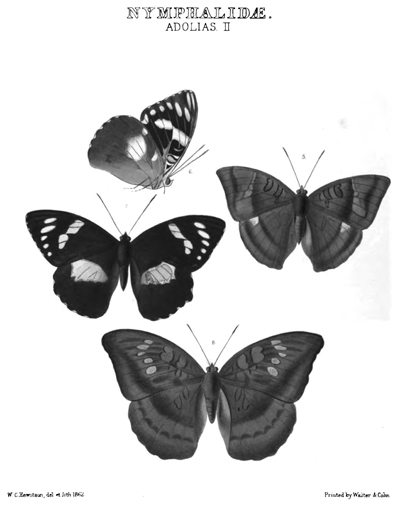
5. ADOLIAS ANYTE
6, 7. ADOLIAS AETION
8 ADOLIAS APHIDAS
NYMPHALIDÆ.
ADOLIAS. II.
ADOLIAS ANYTE. 5.
UPPERSIDE. Male, green-brown; both wings crossed beyond the middle by two bands of darker brown; anterior wing with a brown line and a spot of rufous-brown bordered on both sides with black within the cell: a small spot below the last, and a spot just beyond the end of the cell also bordered on both sides with black; the space between the two transverse bands is of a paler tint than the rest of the wing, marked with two indistinct round spots; posterior wing with a white spot on the costal margin beyond its middle.
UNDERSIDE as above, except that it is much paler; that the posterior wing has the oblong and transverse black marks near the base common to the species of this group, and that it is crossed in the place of the first transverse band by a band (broken in the middle) of six obscure white spots.
Expan. 2 8/10 in. Hab. East India.
In the Collection of W. C. Hewitson.
ADOLIAS AETION. 6, 7.
UPPERSIDE. Female, dark brown; anterior wing crossed obliquely at the middle by a quinque-partite band of yellow, and nearer the apex and outer margin by a curved band of five spots of the same colour; an oblong spot at the anal angle, and two near the inner margin beyond its middle grey and indistinct; posterior wing with a large spot of yellow before the middle.
UNDERSIDE. Anterior wing with the two transverse bands as above, except that the spots of the outer band are white; black from the base to the second band,
D
light brown beyond it: the base itself grey: the costal margin and costal nervure black: a triangular spot, a spot bordered with black and again with white within the cell: a curved white band at the end of the cell: two oblong white spots near the apex: the outer margin spotted with white; posterior wing pale rufous-brown: the costal margin near the base scarlet; the yellow spot smaller than above: a spot near the costal margin before the middle, and a curved band of five or six indistinct spots beyond the middle, all grey.
Expan. 3 2/10 in. Hab. Aru.
In the Collection of A. R. Wallace.
This butterfly bears but slight resemblance to any other species of Adolias. The anterior wing is of different form and the colouring of the underside singular. I cannot however, find any characters sufficiently marked by which to separate it. The cell of the anterior wing is closed, that of the posterior wing is open. The branches of the subcostal nervure are exactly as in A. Lubentina.
ADOLIAS APHIDAS. 8.
UPPERSIDE rufous-brown; both wings crossed by a continuous oblique band of dark brown, commencing at the apex of the anterior wing and reaching to the middle of the abdominal fold of the posterior wing. Anterior wing with a black line, two oblong spots (one within, the other just beyond the cell) and two smaller spots below these; crossed at the middle by a curved band of five clouded-white spots; the outer margin dark brown. Posterior wing with two oblong spots near the base; crossed beyond the middle by a band of dark brown lunular spots.
UNDERSIDE as above, except that it is orange-yellow; that the band described above as continuous, is much more distinct on the anterior wing, but scarcely seen on the posterior wing; that the spots near the base of the anterior wing and the band of white spots are all bordered with black: that there is a sixth white spot below the band of five spots; that the apex is white; that the posterior wing has the usual black spots and lines near the base, but indistinctly marked.
Expan. 3½ in. Hab. East India.
In the Collection of W. C. Hewitson
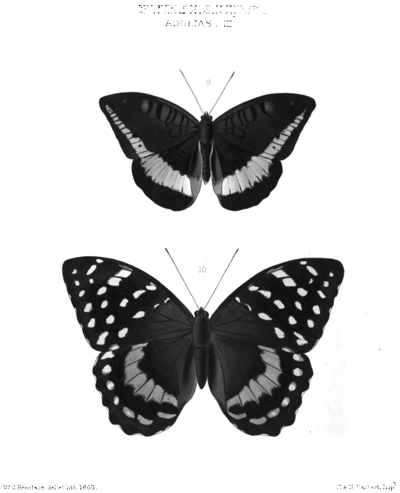
9. ADOLIAS CALLIPHORUS
10. ADOLIAS IMPERATOR
NYMPHALIDÆ.
ADOLIAS. III.
ADOLIAS CALLIPHORUS. 9.
Adolias Cattiphorus, Felder. Wien. Ent, Monats, Vol. V., p. 302.
UPPERSIDE. Male dark brown; paler near the base of the anterior wing. Anterior wing with several of the usual black lines in and below the cell. Both wings crossed obliquely near the outer margin by a common band: on the anterior wing narrow, gold-green, marked by one or two black spots: on the posterior wing broad, cerulean blue, tinted with green towards the anal angle.
UNDERSIDE pale green; both wings with the usual cellular black lines; both crossed beyond the middle by two parallel bands of black spots.
Female does not differ from the male, except that it is larger, and has the spots of the inner band, on the underside of the posterior wing, much less distinct.
Expan. 3 3/10 in. Hab. Luzon, Philippine Islands.
In the Collection of W. C. Hewitson.
K
ADOLIAS IMPERATOR. 10.
Adolias Imperator, Boisduval Ms.
UPPERSIDE. Female black; green-brown at the base of the wings. Anterior wing with twenty-two white spots; two of them within the cell, small and obscure. Posterior wing crossed at the middle by a broad curved band of cerulean blue; and near the outer margin by a band of seven spots; the first four round and white, the three nearest the anal angle lunular pale blue; the outer margins spotted with white.
UNDERSIDE. Anterior wing as above, except that the apex is broadly rufous, and that the two spots nearest to it are tinted with the same colour. Posterior wing red-brown from the base to beyond the middle marked by nine or ten dull lilac spots; the wing beyond dull lilac, with the white spots as above, those which are blue above lilac and indistinct; all the margins bright rufous.
Expan. 4 3/10 in. Hab. Luzon.
In the Collection of Dr. Boisduval.
I am indebted to the generous kindness of Dr. Boisduval for the pleasure of figuring this, one of the most beautiful species of a genus conspicuous for its rich variety of form and colour.
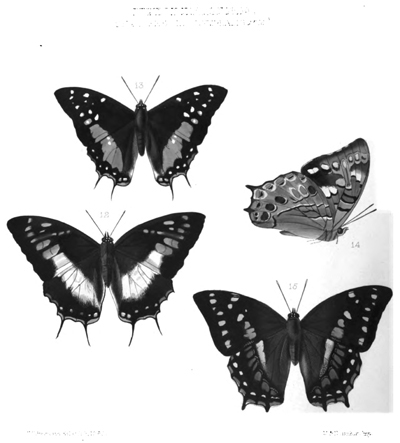
12, 13. CHARAXES CACUTHIS
14, 15. CHARAXES CAPHONTIS
NYMPHALIDÆ.
CHARAXES. III. (NYMPHALIS ante.)
CHARAXES CACUTHIS. 12, 13.
UPPERSIDE. Male black, with several white spots, and a broad common band of pale blue. Anterior wing with nine white spots, and a transverse band which commences in a spot between the second and third median nervules and continues to the anal angle of the posterior wing, marked on the posterior wing by two white spots. Posterior wing with two tails; some white spots near the outer margin: a submarginal band, rufous and obscurely marked between the apex and the first tail, blue or green between the tail and the anal angle.
UNDERSIDE as in C. Etheta.
Female dark brown, with a common broad band of white. Anterior wing with several rufous spots: two of these spots, between the median nervules, large; the lowest spot forming part of the transverse band which ends at the middle of the abdominal fold of the posterior wing; on the underside it does not differ from the male.
Expan. ♀ 3 in.; ♀ 3 5/20 in. Hab. Madagascar.
In the Collection of W. C. Hewitson.
Although very closely allied to C. Etheta, this butterfly has, I think, the characters of a distinct species. The blue band on the posterior wing of C. Etheta is composed of well-defined spots, which could scarcely be converted into the broad band of C. Cacuthis. The double band of white spots on the anterior wing of C. Etheta are also much further apart than they are in C. Cacuthis; these same spots also differ in colour in the female. On the underside the two species scarcely differ, but this is the case with other species of the genus Charaxes.
I find that I have been led into error in following what Mr. Westwood has done in "Doubleday and Hewitson's Genera of Diurnal Lepidoptera," he having there adopted Nymphalis as the name of this genus. Charaxes has the right of priority, and must therefore be used.
N
CHARAXES CAPHONTIS. 14, 15.
UPPERSIDE. Female dark brown with many spots of pale yellow. Anterior wing crossed by two bands of pale-yellow spots; one band at the middle of six spots (one minute); the second band towards the outer margin of seven spots. Posterior wing with two caudate dentations: crossed before the middle by a short band of white; crossed at the middle by a band of six brick-red spots (the middle spot linear), irrorated above (chiefly towards the anal angle) with white; crossed near the margin by a band of eight pale-yellow spots, and by a submarginal band of oblong rufous spots.
UNDERSIDE grey and green and rufous. Anterior wing with a spot of green-white and a rufous spot (both margined with black) within the cell; crossed at the middle and towards the outer margin by bands of spots as above, but of different form and size: clouded with dark brown between the bands and at the outer margin. Posterior wing crossed before the middle by two linear bands of black, one near the base short, bordered inwardly with white; the second oblique, longer, bordered outwardly with white; crossed at the middle by a band of six spots, the second and third spots orange, bordered with white, the other four spots sanguineous, bordered above with lilac-white, the white bordered again with black: a band of black spots near the outer margin, bordered with lilac, and crowned above with white; a submarginal band of oblong orange spots, each with a narrow border of white; the outer margin green-brown; the fringe white.
Expan. 3 9/20 in. Hab. Port Denison, Australia.
In the Collection of W. C. Hewitson.
This beautiful butterfly formed part of a very choice collection of insects made in Australia by Mr. Dämel, and is the only one seen by him. It is not easy to compare it with any other species; it has a remote resemblance on the upperside to C. Fabius, and on the underside to C. Sempronius.
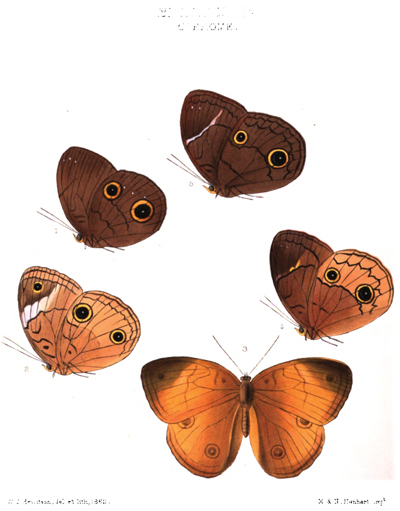
1. CLEROME BESA
2, 3. CLEROME CHITONE
4, 5. CLEROME MENADO
MORPHIDÆ.
CLEROME.
CLEROME BESA. 1.
UPPERSUDE. Female, rufous or yellow-brown, darker towards the margins.
UNDERSIDE brown. Anterior wing with two indistinct brown lines within the cell, an oblique short line from the middle of the costal margin and three minute white dots near the apex. Posterior wing crossed by two linear bands of brown before the middle; beyond the middle two large black ocelli, each with the pupil white and iris rufous, and between them three minute white dots.
Expan. 2 7/10 in. Hab. Borneo.
In the Collection of W. C. Hewitson.
This species is closely allied to C. Phaon of Erichson, but differs from it in wanting most of the transverse linear bands of the underside in having the ocelli of different form and colour, and three minute white dots between them.
CLEROME CHITONE. 2, 3.
UPPERSIDE. Female, rufous-orange: the apex broadly brown with some of the decorations of the underside seen through.
UNDERSIDE paler. Anterior wing with a black spot within the cell inclosed by an irregular band of black: the disco-cellular nervures, a linear transverse band at the middle, and two linear submarginal bands black: an oblique broad white band beyond the middle: an ocellus and minute white spot near the apex. Posterior wing with a spot at the base, a transverse line near it, a short line from the middle of the costal margin (indistinctly traced beyond) and two submarginal lines (the inner line zig-zag) all black; two large black ocelli, each with white pupil and ray of blue dots, the iris yellow margined with black.
Expan. 3 1/10 in. Hab. Celebes.
In the Collections of W. W. Saunders and W. C. Hewitson.
CLEROME MENADO. 4, 5.
UPPERSIDE. Male (fig. 5), orange-brown, slightly darker towards the outer margins.
UNDERSIDE brown. Anterior wing crossed obliquely from the middle of the costal margin by a narrow band of white: a spot and two lines within the cell, the end of the cell, a transverse curved band at the middle touching the white band, two undulated submarginal bands, and the outer margin, black: three minute white dots near the apex. Posterior wing with a spot at the base, two transverse undulated bands before the middle, two submarginal bands (the inner band zig-zag) and the margin, all black; two large black ocelli each with white pupil and ray of lilac dots: the iris yellow, margined with black.
Female differs little from the male, except in colour; it is much paler on the underside; the bands also which cross the anterior wing approximate more closely at the inner margin.
Expan. 3 in. Hab. Menado.
In the Collections of W. W. Saunders and W. C. Hewitson.
Near to C. Stomphax of Westwood.
The butterfly, which Mr. Westwood has placed in this genus under the name of C. Busiris, has little resemblance to the other species. He has, it is true, put it into a subgenus, and pointed out some of its divergencies, but, besides these, it has others; the eyes are more prominent, and the body much longer. Would it not be better placed with the Nymphalidæ, and if not in the genus Iaera at no great distance from it?
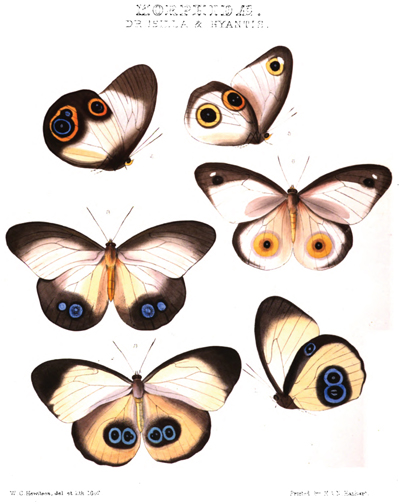
1, 2. DRUSILLA BIOCULATUS
3, 4. DRUSILLA DIMONA
5, 6. HYANTIS HODEVA
MORPHIDÆ.
DRUSILLA & HYANTIS.
DRUSILLA BIOCULATUS. 1, 2.
Morpho bioculatus Guérin, Voy. Coquille, Pl. 17. Hyades Indra Boisd., Voy. Astrolabe, p. 158.
UPPERSIDE. Female, white; anterior wing rufous-white: the costal margin, the apex, and the outer margin to a little beyond the middle (covering one-third of the wing), dark brown. Posterior wing orange-yellow; the costal and outer margins dark brown: a large dark brown circular spot near the middle of the costal margin, inclosing two black ocelli with the pupils and iris light blue; the ocellus nearest the inner margin has a third minute ocellus attached to it and inclosed within the same iris.
UNDERSIDE as above, except that the costal margin of the posterior wing is of a much darker brown and is marked beyond the middle by an ocellus similar to the others, but smaller: that the central spot is much larger, extending to the inner margin, and of a darker brown: that the ocelli are much larger, especially that nearest the inner margin which has absorbed the small ocellus mentioned above and contains two pupils.
Expan. 3½ in. Hab. Waigiou.
In the Collection of A. R. Wallace.
It was not until after the accompanying plate was finished, and I believed that I had figured a new species, when I ascertained that it is identical with the Morpho bioculatus of Guérin. It is not, as supposed by Boisduval and Westwood, the female of Melanitis (Dyctis) Agondas, from which it differs in the position of the nervures. It is a Drusilla, and was placed in that genus by Dr. Boisduval under the name of Hyades Indra. The Dyctis bioculatus of the "Genera of Diurnal Lepidoptera," Plate LIV.* is not the Morpho bioculatus of Guérin but the true female of Agondas; and not being able to discover any resemblance to the butterflies then before me in the figure given of Dyctis Agondas in the "Voyage de l'Astrolabe," I figured it and a series of the females in the "Proceedings of the Zoological Society," Annulosa, Plate LV., under the name of Melanitis Melane. D. bioculatus, though agreeing with the other characters of Drusilla, differs from all the other species or varieties in the arrangement of the disco-cellular nervures of the anterior wing; in D. Horsfieldii the first and second disco-cellular nervures are very short and of equal length, the third very long and curved; in D. bioculatus the first disco-cellular nervure is very short, the second very long, and the third short. On examining the numerous examples of Drusilla in my collection, I find that there is considerable difference in the length of the second disco-cellular nervure; in Horsfieldii, as stated above, the first and second disco-cellulars are of equal length: in all the others the second nervure is three or four times the length of the first.
DRUSILLA DIMONA. 3, 4.
UPPERSIDE. Male, white; anterior wing with the costal margin and apex broadly rufous-brown: posterior wing rufous-white: the outer half dark brown, with two unequal light blue ocelli near the outer margin, each pupilled with light blue, the larger irrorated with black.
UNDERSIDE as above, except that the base of the posterior wing is dark brown: that the large ocellus is all black with an iris of blue: that both of the ocelli are bordered with black, and again encircled by a common band of orange; and that there is a third ocellus near the apex with the blue iris incomplete.
Expan. 3½ in. Hab. Aru.
In the Collections of W. W. Saunders and W. C. Hewitson.
I have elsewhere stated my belief, and I may repeat it here (excepting D. Horsfieldii from the list in consequence of its differing in the length of the disco-cellular nervures) that D. Catops and Selene of Boisduval, D. Phorcas and Milæcha of Westwood, D. Myops and Macrops of Felder, and D. Artemis, Anableps, and Dioptica of Volleuhoven, are only varieties of Urania. D. Dimona should, very probably, add one more to the number; it differs, however, so much from all on the upperside, that I have preferred for the present to consider it as distinct.
HYANTIS. Hewitson.
Body small, quadrate, abdomen slender. Eyes small, smooth. Palpi rather long, compressed, clothed with scales throughout, encircling the eyes. Antennæ rather short, thickened gradually to the point, the articulations numerous and easily seen.
Anterior wing rather large: the costal margin arched, apex rounded, outer margin slightly sinuated at the middle, inner margin rounded, protruded as in Euploea; costal nervure swollen at its base, reaching beyond the middle of the wing: subcostal nervure with four branches: two together just before the end of the discoidal cell, the third midway between the end of the cell and the apex of the wing, the fourth at one-third of the distance between the last and the apex; discoidal cell nearly half the length of the wing, closed: upper disco-cellular nervure very short, the second semi-circular arched inwards rather short, the third more than twice the length of the second curved united to the third branch of the median nervure at a distance from its base.
Posterior wing oblong, circular, with large abdominal fold; costal nervure joining the margin considerably beyond the middle: subcostal nervure with its first branch arising near the base of the wing: the discoidal cell short and narrow, closed; the upper disco-cellular nervure long, arising at a short distance below the first branch of the subcostal nervure, at first in a transverse direction, and afterwards passing longitudinally down the wing: the second half its length, joining the third median nervure a little beyond its base.
Fore legs of both sexes short, tibiæ and tarsi of both so densely clothed with hair as to conceal the joints of the tarsi.
Hind legs long, slender, smooth: the femora tibiæ and tarsi of equal length.
HYANTIS HODEVA. 5, 6.
UPPERSIDE. Male, white; both wings with the costal margin and apex broadly brown, the outer margin also brown to beyond its middle; anterior wing rounded and produced at its inner margin as in Euploea: near this margin a large oval pale rufous spot: near the apex a small spot of white and a black ocellus with some minute white dots. Posterior wing, with a small black ocellus with white pupil, broadly bordered with yellow, and marked by a very indistinct circle round the ocellus.
UNDERSIDE as above, except that the ocellus at the apex of the anterior wing has the pupil and some smaller dots of white and an iris of yellow: that the ocellus of the posterior wing is larger and has several minute dots of white and the iris bordered with brown: that there is a similar ocellus on the costal margin bipupillated and dotted with white.
Female larger: the wings broader, suffused with darker brown, the nervures dark brown; anterior wing with the centre alone white; posterior wing white only to the middle, tinted with orange-yellow towards the inner margin: the ocellus small, indistinctly pupilled with white; the iris orange-yellow, bordered with brown and encircled above by a pale line; underside it differs only in the broader outer margin of the posterior wing.
Expan. ♀ 3 2/10 ♀ 6/10. Hab. Waigiou.
In the Collection of A. R. Wallace.
This is a species of singular interest, from the remarkable resemblance it bears to the Drusillas, differing at the same time from them widely in the arrangement of the branches from the subcostal nervure of the anterior wing, in the form of that wing with its projected inner margin, and in the closed discoidal cell of the posterior wing. It is unique in the collection of Mr. Wallace.
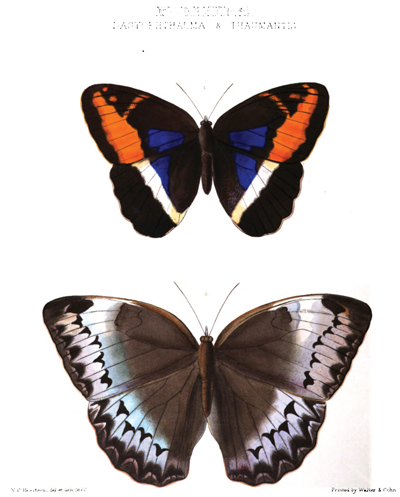
1. DASYOPHTHALMA DELANIRA
2. THAUMANTIS CAMBODIA
MORPHIDÆ.
DASYOPHTHALMA AND THAUMANTIS.
DASYOPHTHALMA DELANIRA.
UPPERSIDE. Female, dark brown; anterior wing crossed near, and parallel to, the outer margin by a broad orange band, sinuated on both sides; a small spot near the apex, and a narrow macular band from the middle of the inner border of the broad band to the middle of the costal margin, both of the same colour: a spot of blue near the inner margin between the median nervure and the band; posterior wing crossed near the middle by a straight band of white, tinted with yellow near the anal angle, glossed with blue near the costal margin from the base to the white band.
UNDERSIDE undulated throughout with dark brown; the band of the anterior wing paler than above, the band between it and the costal margin white; a small black ocellus with two pupils of white; the band of the posterior wing slightly rufous; two large brick-red ocelli with lunular white pupils.
Expan. 4 1/10 in. Hab. Brazil.
In the Collection of W. C. Hewitson.
The underside of this species does not differ at all from that of D. Rusina.
F
THAUMANTIS CAMBODIA. 2.
UPPERSIDE. Female, brown: the basal half of both wings green-brown; the outer half lilac-white with a white spot near the costal margin beyond its middle; both wings crossed by a band of triangular palm-like black spots: the outer margin broadly brown, deeply sinuated at the nervures, and traversed by a deeply undulated line of lilac, forming conical spots indented at the apex.
UNDERSIDE green-brown to the middle, red-brown beyond, tinted with lilac on the posterior wing; both wings crossed near the base by an undulating band of rufous-brown: at the middle by a narrow band of white bordered inwardly with rufous-brown: and beyond the middle by a deeply undulating orange-brown band, followed near the outer margin by a band of indistinct brown spots: anterior wing with a short curved line at the base and a band at the end of the cell, rufous; two obscure rufous-orange ocelli; posterior wing with a small rufous spot before the middle, and three equidistant rufous-orange ocelli with white pupils and black iris.
Expan. 5 4/10 in. Hab. Cambodia.
In the Collections of W. W. Saunders and W. C. Hewitson.
This species, though much resembling T. Camadeva of Westwood, is very distinct. The colour of the basal half of the wings is altogether different; the anterior wing is without ocelli, the spots beyond the middle of the wing are of another form; the posterior wing of Camadeva is without them. On the underside they are quite unlike in colour: Cambodia has only two ocelli on the anterior wing, and three on the posterior wing, Camadeva has five on each; the undulating lines which follow these ocelli have but little resemblance.
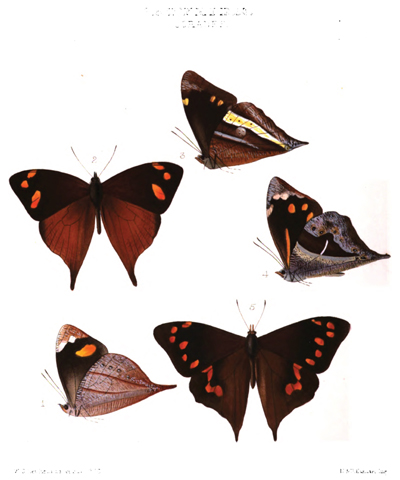
1, 2. CORADES CHELONIS
3. CORADES CHIRONE
4, 5. CORADES CISTENE
SATYRIDÆ.
CORADES.
CORADES CHELONIS. 1, 2.
UPPERSIDE. Male. Anterior wing dark brown, paler at the base, with three rufous spots towards the apex and outer margin. Posterior wing tailed, rufous-brown; the base, inner margin, and tail clouded with darker brown: the apex dark brown.
UNDERSIDE. Anterior wing as above, except that the apex is silvery-grey undulated with brown, and that the two spots near it are white. Posterior wing silver-grey, undulated throughout with rufous-brown; crossed obliquely by two parallel lines of rufous-brown, and nearer the outer margin by a band of indistinct spots.
Expan. 2 8/10 in. Hab. New Granada.
In the Collections of W. W. Saunders and W. C. Hewitson.
If Corades Iduna and C. Enyo are good species, this must be considered as a third. It is not easy to say to which of the two it bears the closest resemblance; the three, be they species or only varieties, are very nearly allied.
CORADES CHIRONE. 3.
UPPERSIDE. Male, uniform dark brown.
UNDERSIDE. Anterior wing dark brown, with three pale-rufous spots; one spot on the costal margin beyond the middle, two nearly together towards the anal angle; the apex rufous-brown, with a large ill-defined spot of silvery-white undulations. Posterior wing rufous-brown, undulated with silvery-white chiefly near the outer margin; crossed before the middle by an indistinct short silvery band, and again beyond the middle by a broad band of silver-white tinted with yellow, marked with two or three minute black spots; between the bands (within the cell) an ill-defined round spot of white and silver undulations; the tail undulated with dark brown.
Expan. 2 9/10 in. Hab. New Granada.
In the Collection of W. C. Hewitson.
CORADES CISTENE. 4, 5.
UPPERSIDE. Male, dark rufous-brown. Anterior wing crossed near the apex and outer margin by an irregular band of six rufous spots. Posterior wing rufous-brown, dark brown at the apex, where it is marked by two or three small rufous spots.
UNDERSIDE. Anterior wing as above, except that there is an oblong spot within the cell, that the apex is rufous-brown undulated with silver, and that the three spots of the band near it are white and indistinct. Posterior wing undulated with brown, its centre silver-white crossed by a broad oblique band (of unusual form) of dark rufous-brown, intersected at the median nervule by a line of white, and followed by a band of six black spots, the anal spot, which is largest, dotted with white: the inner and outer margins broadly brown.
Var. (Figs. 4, 5.) With all the rufous spots larger than usual, the three spots of the posterior wing forming a curved band.
This species varies considerably on the underside of the posterior wing. In some examples the whole of the broad band, except its margins, is like the rest of the wing, of a silver-white.
Females are very scarce in the genus Corades, as far as it is represented in our collections. My own collection is without one, and in a rather large series in the British Museum, there are only two.
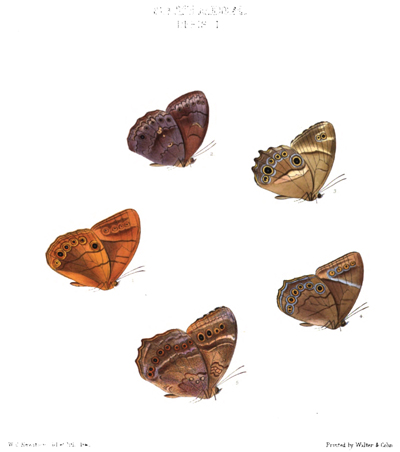
1. DEBIS ANYSIS
2. DEBIS MARPESSA
3. DEBIS SICELIS
4. DEBIS LATIARIS
5. DEBIS SEGONAX
SATYRIDÆ
DEBIS I.
DEBIS ANYSIS. 1.
UPPERSIDE. Male, rufous-brown; anterior wing crossed at the middle by a band of darker brown; posterior wing with a tuft of long hair in the middle, and half-way between it and the outer margin four ocelli, the lower two only, with white pupils, the iris indistinct light brown.
UNDERSIDE rufous; anterior wing crossed by three bands of rufous-brown; one near the base: one a little beyond it crossing the cell only: the third beyond the middle, followed by four nearly blind ocelli, though pupilled with white, with a rufous border above and below; posterior wing crossed by two rufous bands; one near the base: the other near the middle (curved), followed by seven ocelli; the first near the costal margin (largest), the seventh near the anal angle (minute, united to the sixth); all black with white pupils, the iris rufous-orange, bordered with black, and again by rufous-yellow and rufous-brown; the outer margin and a line near it brown.
Expan. 2 6/10 in. Hab. East India.
In the Collection of W. C. Hewitson.
DEBIS MARPESSA. 2.
UPPERSIDE dark brown.
UNDERSIDE rufous and grey-brown, paler near the outer margin; both wings crossed by three transverse undulating bands of brown; the first before the middle; the second at the middle; the third near the outer margin; the outer margins and a submarginal line brown; anterior wing with a pale rufous band at the end of the cell, and five nearly blind ocelli, having white pupils; posterior wing with three pale rufous spots, and five ocelli; the first, second, and fifth, black, the third and fourth rufous; all with white pupils and ill-defined rufous iris.
Expan. 2 7/20 in. Hab. Amazon.
Not being able to find a place for this species in any of the South American genera, I have added it to this genus. It might, perhaps, have been better placed with Taygetis, but does not accord with the characters there given by Mr. Westwood; its eyes are not smooth, and the second branch from the subcostal nervure is not thrown off before the end of the cell. In its colour, in the position of the spots and bands of the underside, it bears considerable resemblance to the species which I have figured on the same plate under the name of D. Segonax. In its hirsute eyes and palpi, and the neuration of the wings (except that the second branch of the subcostal nervure is not thrown off before the end of the cell), it agrees very well with Debis.
DEBIS SICELIS. 3.
UPPERSIDE. Female, yellow-brown. Anterior wing crossed near the middle by an indistinct pale band; posterior wing with indistinct submarginal lines and four ocelli, two of them little more than minute brown spots, one only (the lowest) with a white pupil.
UNDERSIDE yellow-brown, with the outer margins and a line near them dark brown; anterior wing with a band across the cell, and a curved band at the middle, bordered outwardly with white: a band of white near the apex enclosing two ocelli; posterior wing with a broad, transverse white band with rufous border on both sides before the middle, followed by seven ocelli; the first and fifth the largest, the sixth and seventh united; all black, with white pupils, the iris orange-yellow, bordered with light brown, and again with lilac-white.
Expan. 2 4/10 in. Hab. Japan.
In the Collection of W. C. Hewitson.
DEBIS LATIARIS. 4.
UPPERSIDE. Female, yellow-brown; anterior wing with an indistinct transverse band at the middle, and a small rufous spot near the apex; posterior wing with three indistinct blind ocelli; the outer margin and a line near it dark brown, the space between the lines yellow; the cilia grey.
UNDERSIDE light grey or yellow-brown; both wings with the outer margin and a line near it dark brown, with between them a line of yellow; anterior wing crossed before the middle by two short rufous bands: at the middle by a band of white, (its inner border rufous,) forming a triangle with a broad grey band, which runs parallel to the outer margin, and incloses four small indistinct ocelli; posterior wing crossed before the middle by a straight rufous band; at the middle by a curved band of the same colour, followed by seven ocelli: the first apart from the rest, the sixth and seventh (at the anal angle) in one; all black, with white pupils, the iris yellow, margined with dark brown, and again with lilac-white.
Expan. 2½ in. Hab. Sylhet.
In the Collection of W. C. Hewitson.
Very nearly allied, except in colour, to D. Anysis.
DEBIS SEGONAX. 5.
UPPERSIDE. Male, rufous-brown; anterior wing with a white spot near the apex, and below it a black blind ocellus; posterior wing with four oval black blind ocelli.
UNDERSIDE rufous, clouded with grey and brown; both wings crossed beyond the middle by a rufous band bordered on both sides: on its outer side with grey-white; both with a zig-zag band near the outer margin: the outer margin and a parallel line dark brown; anterior wing with two rufous bands across the cell, inclosing a third band divided into four; four oval ocelli, the second obscure; posterior wing with three round spots of yellow near the base, followed by a broken rufous band: eight small ocelli; all black, with white pupils, the iris rufous.
Expan. 2 9/10 in. Hab. China.
In the Collection of W. C. Hewitson.
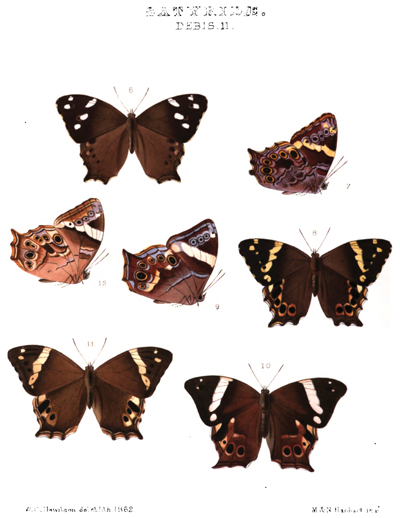
6. DEBIS NEELGHERIENSIS
7, 8. DEBIS DARETIS
9, 10. DEBIS DYNSATE
11 12. DEBIS DRYPETIS
SATYRIDÆ
DEBIS. II.
DEBIS NEELGHERIENSIS. ♂ 6.
♂ Satyrus Neelgheriensis Guérin in Dclessert's Voyage dans l'Inde. Pl. 21, fig. 1.
UPPERSIDE. Female, light brown. Anterior wing with the outer half dark brown, crossed obliquely beyond the middle of the wing by three white spots, and near the apex by two of the same colour. Posterior wing with a band of four spots beyond the middle, the outer margin and two submarginal lines black.
UNDERSIDE grey and rufous-brown. Anterior wing with the white spots as above, and between them a band of three ocelli. Posterior wing with two perfect ocelli only—one, the largest, at the costal margin, the other towards the anal angle; between these ocelli there is a trifid triangular space minutely dotted with black and white, and at the anal angle an eye-like rufous spot enclosing two oval spots of black, dotted with white.
Expan. 2 4/10 in. Hab. Neelgheries.
In the Collections of W. W. Saunders and W. C. Hewitson.
The insect figured by Guerin, though said by him to be a female, is, I have no doubt, of the other sex. No one can see this Butterfly without noticing the great resemblance it has to the females of some of the species of Cybdelis.
DEBIS DARETIS. 7, 8.
UPPERSIDE. Female, rufous-brown. Anterior wing crossed near the middle by a sinuated band of five pale yellow spots, the first four divided by nervures only, the fifth solitary: two pale yellow spots near the apex. Posterior wing with a submarginal band of five large black eye-like spots bordered with rufous-yellow: a spot of yellow at the apex.
UNDERSIDE grey and rufous-brown, with numerous spots and bands of darker
I
brown. Anterior wing with the spots as above, and between them a band of five ocelli, the first and last incomplete. Posterior wing with a band of six perfect ocelli, some with several white dots.
Expan. 2 4/10 in. Hab. Ceylon.
In the Collection of the British Museum. Presented by Mr. Green.
DEBIS DYNSATE. 9, 10.
UPPERSIDE. Female, rufous-brown. Anterior wing dark brown, except near the base; crossed at the middle by a broad equal band of white and a solitary white spot; two indistinct white spots near the apex. Posterior wing with a large bilobed spot near the apex, followed by three black blind ocelli (one minute).
UNDERSIDE rufous and grey-brown. Anterior wing with the white band continuous to the anal angle, with, between it and the apex, a band of three blind ocelli. Posterior wing with a band of six perfect ocelli—the first and fifth large, the other four small and somewhat mis-shapen, each with two or three white dots.
Expan. 2½1/0 in. Hab. Ceylon.
In the Collection of the British Museum.
DEBIS DRYPETIS. 11, 12.
UPPERSIDE. Female, rufous-brown. Anterior wing with the outer half dark brown, crossed by a continuous sinuated band of white, without the anal spot; two white spots near the apex. Posterior wing with a large white sot at the apex, followed by a large oval spot of black, and two smaller spots of the same colour bordered below with white and lilac.
UNDERSIDE rufous-brown, with the band and white spots as above, and between them a band of three blind ocelli and two minute black spots. Posterior wing with two perfect ocelli, and between them three oblong spots, rufous and black dotted with white; near the anal angle two similar black spots dotted with white.
Expan. 2 11/20 in. Hab. Ceylon.
In the Collection of W. C. Hewitson.
I have only attempted in the descriptions to point out the peculiarities of the central white bands and ocelli. I hope that the figures will elucidate (as descriptions only would be inadequate to do) the many minute differences which have compelled me to consider the four closely-approximating species of the plate as distinct; if they were European we should certainly never hesitate to separate them.
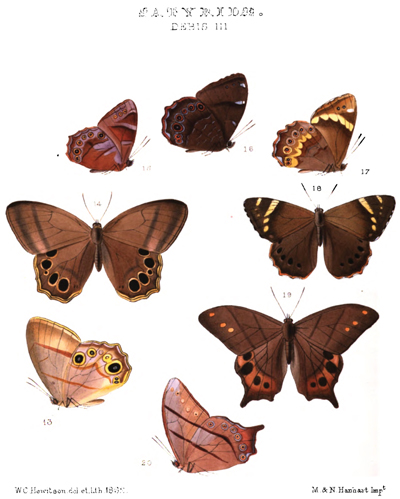
13, 14. DEBIS SYRCIS.
15. DEBIS DINARBAS.
16. DEBIS SIDONIS.
17, 18. DEBIS NICETAS.
19, 20. DEBIS SINORIX.
SATYRIDÆ
DEBIS. III.
DEBIS SYRCIS. 13, 14.
UPPERSIDE. Female, pale rufous-brown. Anterior wing crossed transversely beyond the middle by two bands of brown: the outer margin and a submarginal line brown. Posterior wing with a band of five black blind ocelli, and two minute anal spots, four of the ocelli large, the middle one small, all bordered with yellow: a marginal band of pale yellow traversed by a black line; the margin also black.
UNDERSIDE lilac-yellow: both wings crossed before the middle by a linear rufous band. Anterior wing with the bands as above. Posterior wing crossed at the middle by a curved angular rufous band, followed by a band of five ocelli: two (the first large) near the costal margin, the third small and imperfect, the fourth largest, the fifth at the anal angle bipupillated, each with the white pupil large, the iris yellow with a rufous border; the outer margin as above.
Expan. 2 8/10 in. Hab. North China.
In the Collection of the British Museum.
DEBIS DINARBAS. 15.
UPPERSIDE brown. Anterior wing crossed at the middle by a very indistinct band of brown: a minute bifid white spot and obscure brown spot near the apex. Posterior wing with four obscure brown spots (one minute) near the outer margin, the spot nearest the anal angle dotted with white.
UNDERSIDE brown. Anterior wing paler towards the outer margin, tinted with lilac: the cell crossed by two rufous lines, the transverse band and apical spot as above, but more distinct, with, between them, three minute ocelli (one blind); the outer margin and two submarginal lines rufous-brown. Posterior wing crossed transversely by two rufous-brown bands; one before the middle straight, the other at the middle curved, followed by a band of six ocelli, each with pupil white and rufous iris bordered with brown and lilac.
Expan. 2 1/10 in. Hab. North India.
In the Collection of the British Museum.
DEBIS SIDONIS. 16.
UPPERSIDE. Male, dark-brown. Anterior wing with an indistinct white spot near the apex. Posterior wing with two or three indistinct black spots near the outer margin.
UNDERSIDE brown. Anterior wing with an indistinct band across the cell, a white spot beyond the middle of the costal margin part of a brown band which crosses the wing, a second white spot near the apex, and below it three black spots dotted with white. Posterior wing crossed by several lines of silvery white, followed by a band of seven black ocelli: the first (at the costal margin) and the fifth large, two at the anal angle (touching); each with pupil of white and rufous iris bordered with silvery white; a submarginal line of silvery white, the margin rufous bordered on both sides with black.
Expan 2 2/10 in. Hab. North India.
In the Collection of W. C. Hewitson.
DEBIS NICETAS. 17, 18.
UPPERSIDE. Female, light rufous-brown. Anterior wing with the outer half darker brown, crossed beyond the middle by a macular band of pale yellow, and nearer the apex, by three spots of the same colour. Posterior wing with a band of five black spots with rufous border, the outer margin rufous bordered on both sides with black; some submarginal dark-brown conical spots.
UNDERSIDE rufous-yellow. Anterior wing as above, except that the transverse band is continuous, and that two of the three spots near the apex are small ocelli. Posterior wing from the base to the middle rufous-brown, crossed by several indistinct lilac bands: the outer half rufous-yellow darker towards the outer margin, crossed by a band of seven black ocelli (two at the anal angle touching), each with pupil of white and rufous iris bordered with lilac; a submarginal band of silvery white, the margin rufous, bordered on both sides with black.
Expan. 2 5/20 in. Hab. East India.
In the Collection of W. C. Hewitson.
It seems to me very probable that this may prove to be the female of the last described—D. Sidonis.
DEBIS SINORIX. 19, 20.
UPPERSIDE. Male, rufous-brown. Anterior wing with three pale yellow spots near the apex. Posterior wing with a broad rufous band near the outer margin encircling four round black spots; the second spot large, the fourth small.
UNDERSIDE rufous; both wings crossed by two continuous linear bands of rufous-brown. Anterior wing with the apex lilac-white: the three yellow spots as above, and associated with them two small ocelli. Posterior wing with a band of six small ocelli, the third out of line: each with pupil of white and rufous iris bordered with brown and again with silvery white: a triangular white spot at the anal angle: a submarginal line of lilac-white: the margin rufous, bordered on both sides with black.
Expan. 2 8/10 in. Hab. East India.
In the Collection of W. C. Hewitson.
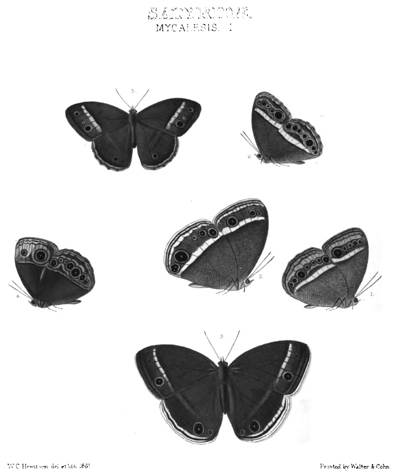
1. MYCALESIS NICOTIA
2 3 MYCALESIS SAFITZA.
4. MYCALESIS MESTRA.
5 6 MYCALESIS MALSARA
SATYEIDÆ.
MYCALESIS. I.
MYCALESIS NICOTIA. 1.
M. Nicotia, Hewitson, Gen. Diur. Lep. Pl 66, f. 4, p. 394 (upperside), var. M. Heri Moore, Cat. Lep. E. I. C. Mus. p. 233.
UPPERSIDE dark brown: the outer margin paler, traversed by two submarginal lines of dark brown. Anterior wing with two ocelli: one near the apex small; the other, below it, large; posterior wing, with one ocellus near the middle of the outer margin; all black with white pupils and rufous borders.
UNDERSIDE rufous, underlated with dark brown; both wings crossed beyond the middle by a band of pale yellow (interrupted where the wings meet) followed by a broad band of purple-brown, marked with numerous ocelli; five on the anterior wing, the fifth much the largest; on the posterior wing seven, the first and fourth largest; all with white pupils and rufous borders: the outer margins of both wings broadly grey and rufous, traversed by three dark-brown undulating lines.
Expan. 2 3/10 in. Hab. East India.
In the Collections of W. W. Saunders and W. C. Hewitson.
MYCALESIS MESTRA. 2, 3.
UPPERSIDE. Female dark brown. Anterior wing crossed beyond the middle by a narrow band of white, followed by two ocelli; one near the apex minute, the other larger; two submarginal black lines, the margin white. Posterior wing crossed beyond the middle by an indistinct band (seen through); followed by two ocelli towards the anal angle, the one nearest the angle minute, oval, and ill-formed: a submarginal line of rufous-white: the margin broadly white, traversed by a very fine black line.
B
UNDERSIDE rufous, the basal half undulated with dark brown; crossed beyond the middle by a continuous band of white, followed by a broad band of purple-brown marked with several ocelli: on the anterior wing by three; the first (which is minute) and second near the apex; the third (larger) beyond the middle: on the posterior wing by five, three of them near the apex (the third indistinct), two near the anal angle, large, all with pupils of white and rufous border; both wings with white and rufous submarginal bands; the margins white.
Expan. 2 8/10 in. Hab. East India, Deccan.
In the Collection of W. C. Hewitson.
MYCALESIS SAFITZA. 4.
M. Safitza, Hewitson, Gen. Diur. Lep. Pl. 66, p. 394 (upperside).
UPPERSIDE dark brown, the outer margins paler: apex of anterior wing rufous, with a minute ocellus.
UNDERSIDE dark brown to the middle, where the wings are crossed by a narrow band of lilac-white, followed by numerous ocelli: two on the anterior wing, the first minute, the other large: seven on the posterior wing, the first, fourth, and fifth largest; all with white pupils and rufous borders: those on the posterior wing inclosed by a tortuous line of lilac: the outer margins rufous, traversed by three black lines.
Expan. 1 9/10 in. Hab. Africa.
In the Collections of W. W. Saunders and W. C. Hewitson.
MYCALESIS MALSARA. 5, 6.
M. Malsara, Moore, Cat. Lep. E. I. C. Mus. p. 231.
UPPERSIDE rufous-brown. Anterior wing crossed beyond the middle by a band of white, followed by three blind ocelli (the middle one minute): posterior wing with one ocellus (indistinct): the outer margins of both wings rufous-white, traversed by two black lines.
UNDERSIDE rufous, undulated; crossed beyond the middle by a band of yellow-white, interrupted where the wings meet, followed by a broad band of dark brown, with numerous ocelli: on the anterior wing five, the second and fifth largest: on the posterior wing seven, the first, second, and fifth largest, most of them with white pupils, and rufous borders, the whole inclosed on each wing by a tortuous line of lilac; the margins broadly white, traversed by two black lines.
Expan. 2 1/10, in. Hab. Darjeeling.
In the Collection of W. C. Hewitson.
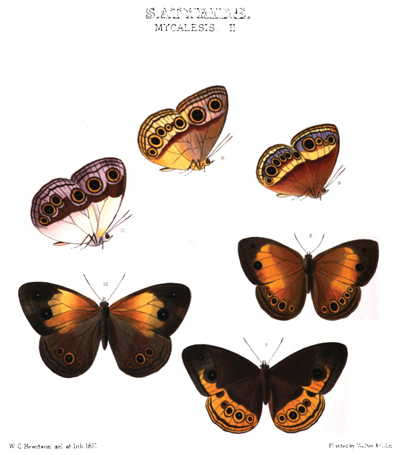
7, 10 MYCALESIS DORICUS
8, 9. MYCALESIS MESSENE
11 12. MYCALESIS MUCIA
SATYRIDÆ.
MYCALESIS. II.
MYCALESIS DORICUS. ♀ 7, 10.
♀ Satyrus Dorycus, Boisd. Voy. Astrolabe, p. 152. S. Duponchelli Guér. Voy Coquil, Pl 17, f. 3. M. Getulia Felder Wien. Ent Monats, Vol. III., p. 404.
UPPERSIDE. Female dark brown. Anterior wing with two ocelli, with white pupils; a band of orange near the outer margin from the middle to the inner margin; two indistinct submarginalblack lines. Posterior wing, with the outer half orange, marked with five ocelli, some only, with white pupils, followed by three submarginal black lines.
UNDERSIDE orange-yellow, clouded on the basal half; both wings crossed near the base by a waved rufous line; crossed at the middle by a band of rufous-brown, followed by several ocelli; two on the anterior wing, large and separate; five on the posterior wing, the second smallest; both wings with two submarginal brown lines.
The Male differs chiefly in having only three much smaller ocelli on the posterior wing: onthe underside the sexes are alike.
Expan. 2 6/10 in. Hab. Dorey.
In the Collections of W. W. Saunders and W. C. Hewitson.
MYCALESIS MESSENE. 8, 9.
UPPERSIDE. Female rufous-orange, clouded from the base nearly to the middle; the outer margin broadly dark brown: anterior wing with two ocelli, one near the apex small and indistinct, the other large, each with light-blue pupils: posterior wing with five, the third and fourth larger than the others; the pupils white, the borders rufous.
UNDERSIDE, with the basal half rufous-brown; both wings crossed at the middle by a broad band of pale yellow, followed by a broader band of lilac, marked with numerous ocelli; four on the anterior wing, the second and third small: six on the posterior wing, crowded together, of nearly equal size, except the fifth, which is largest, all with pupils of blue and rufous margins; both wings with a submarginal band of pale yellow; the margins rufous.
The male does not differ, except that it is smaller; that the upper side has the margins of a darker brown, the base less clouded, and the underside of the posterior wing crossed at the middle by a narrow band of lilac.
Expan. ♀ 2, ♀ 2 2/10 in. Hab. Batchian.
In the Collections of W. W. Saunders and W. C. Hewitson.
MYCALESIS MUCIA. 11, 12.
UPPERSIDE. Female brown. Anterior wing with the base rufous, succeeded by a broad irregular band of orange-yellow; the outer half dark brown, with three ocelli; two near the apex, one of which is very minute; all with pupils of light blue: posterior wing rufous-brown, with three ocelli, the middle one largest and most distinct; both wings with a submarginal band and line of black.
UNDERSIDE, with the basal half white, slightly tinted with yellow; both wings crossed at the middle by a broad irregular band of dark rufous-brown, curved on its outer border, so as to make room for the ocelli, which follow; from this band to the outer margin rufous-grey, with two submarginal waved brown lines: anterior wing with two large ocelli: posterior wing with four, the outer one smallest; all with white pupils and rufous borders.
The male differs only in being smaller, of a much darker brown above, with one ocellus only on the posterior wing: on the underside the sexes are alike.
Expan. ♀ 2 4/10, ♀ 2 6/10 in. Hab. Dorey.
In the Collections of W. W. Saunders and W. C. Hewitson.
The insects of this and the preceding plate differ so much in their general appearance and colour that I have examined them carefully, wishing to find some character by which to separate them, but without success. Dr. Felder has, however, done so, but without sufficient foundation upon which to establish his new genus: first, the somewhat longer and narrower cell; and, secondly, the hirsute eyes. M. Malsara has a cell of the same form, and more than two-thirds of the species of Mycalesis have hairy eyes. It is a character of no value in this genus, except to distinguish species, some of those which are the most nearly allied being with or without hirsute eyes.
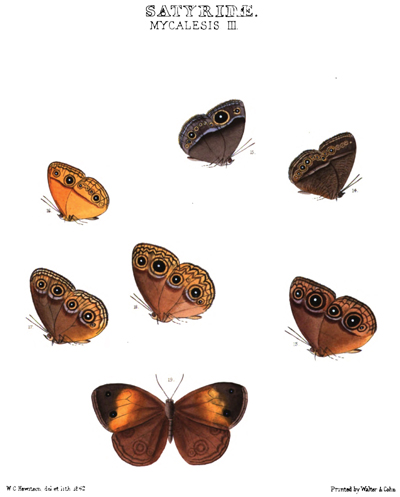
13. MYCALESIS DEIANIRA
14. MYCALESIS MEGAMEDE
15. MYCALESIS PERDICCAS
16. MYCALESIS PHIDON
17, 18, 19. MYCALESIS DEXAMENUS
SATYRIDÆ.
MYCALESIS. III.
MYCALESIS DEIANIRA. 13.
UPPERSIDE. Male rufous-brown, brighter towards the outer margin of the posterior wing. Anterior wing with the apical half dark brown; posterior wing with the outer margin brown.
UNDERSIDE rufous, clouded from the base to the middle, chiefly on the anterior wing: both wings crossed before the middle by an indistinct rufous band; at the middle by a band of rufous-brown, followed on each wing by two large black ocelli, with the pupils white, the iris rufous, bordered with red brown, and again above them (chiefly on the anterior wing) with lilac-white: each followed by an undulating rufous band at a distance from the margin; a submarginal line, and the outer margin dark brown; posterior wing with a third small ocellus near the anal angle.
Expan. 2½ in. Hab. Tondano.
In the Collection of A. R. Wallace.
MYCALESIS DEXAMENUS. 17, 18, 19.
UPPERSIDE. Male (fig. 17) rufous-brown, paler near the outer margin of the posterior wing. Anterior wing, with the costal margin, and more than the outer half brown, with an indistinct ocellus between the first and second median nervules: the outer margin and two indistinct submarginal lines brown. Posterior wing with an indistinct undulating band of light brown near the outer margin, followed by two sub-marginal dark brown lines.
UNDERSIDE rufous, clouded to the middle: both wings crossed at the middle by a curved rufous-brown band, followed on each wing by two large distinct black ocelli, the pupils white, the iris rufous, bordered with dark brown and again above with lilac-white: two slightly-curved submarginal black lines. Posterior wing with a third minute ocellus near the anal angle.
Female (fig. 18) like the male, except that the upperside is paler; that the underside has the submarginal lines zig-zag; that the posterior wing has a minute blind ocellus between the two large ocelli, and is crossed near the base by an indistinct rufous line.
Var. Female (fig. 19). Anterior wing crossed at the middle by a broad band of rufous-yellow; a second ocellus near the apex; posterior wing with the underside rufous-yellow; both wings crossed near the base by a curved rufous line; the ocelli of the anterior wing placed further from the central rufous band.
Expan. 2 4/10 in. Hab. Tondano. Var. Celebes.
In the Collections of W. W. Saunders and W. C. Hewitson.
The male of this species and of Deianira are much alike; their chief distinction consists in the position of the submarginal band on the underside of the anterior wing.
MYCALESIS MEGAMEDE. 14.
UPPERSIDE. Male, light-brown. Anterior wing with its centre dark brown: the outer margin towards the anal angle rufous, traversed by a black line. Posterior wing with the outer margin rufous, traversed by a black line: the margin brown.
UNDERSIDE rufous-brown; both wings undulated with darker brown from the base to the middle; crossed at the middle by a continuous narrow band of lilac-white, followed on the anterior wing by six ocelli (the first four minute); on the posterior wing by a curved band of seven ocelli, the first, fourth, and fifth larger than the others; all black, the pupils white, the iris rufous, bordered with black and again with white: a submarginal pale rufous band, traversed by a black line: the margin rufous.
Expan. 1 9/10 in. Hab. Ternate.
In the Collection of W. C. Hewitson.
MYCALESIS PERDICCAS. 15.
UPPERSIDE. Male, brown. Anterior wing with two ocelli: one near the apex, small; the other below it, large: both black, with white pupils and rufous iris. A tuft of hair near the inner margin. Posterior wing with one indistinct black ocellus, the pupil white; the outer margin of both wings rufous, traversed by two black lines; the cilia white.
UNDERSIDE light brown; both wings crossed at the middle by a narrow band of lilac-white, followed on the anterior wing by the ocelli as above; on the posterior wing by a curved band of seven ocelli; the second, third, and seventh, minute: the first, fourth, and sixth, somewhat larger: the fifth the largest: all black, with pupil white, and iris rufous; the outer margin white, traversed by two black lines.
Expan. 1 9/10 in. Hab. Japan.
In the Collection of W. C. Hewitson.
MYCALESIS PHIDON. 16.
UPPERSIDE. Male rufous-brown: a band of brown and a black line near the outer margins; anterior wing with the costal margin and apex broadly dark brown, marked with two ocelli: one near the apex small, and indistinct: the other below it large, oval, with above it a band of dark brown; posterior wing with two ocelli of different sizes; all the ocelli black, with pupil white and iris rufous, bordered with black.
UNDERSIDE orange-yellow; both wings crossed near the middle by a rufous-brown band, broken where the wings meet, followed on the anterior wing by the ocelli as above: on the posterior wing by six ocelli; the second, third, and sixth minute (the third mis-shapen): the first and fourth larger: the fifth largest; both wings with a zig-zag rufous-brown band near the outer margin, and a submarginal black line: the margin rufous.
Expan. 1 8/10 in. Hab. Aru.
In the Collections of W. W. Saunders and W. C. Hewitson.
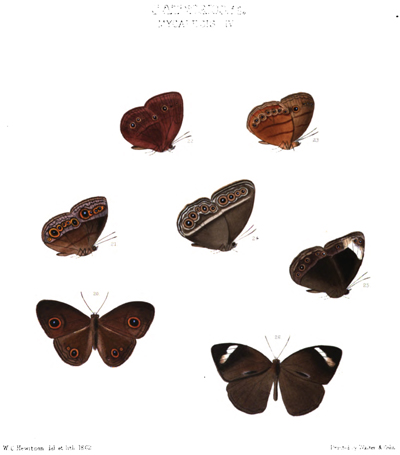
20, 21. MYCALESIS ASOPHIS
22. MYCALESIS DAIDIS
23. MYCALESIS DINICHE
24. MYCALESIS JOPAS
25, 26. MYCALESIS ANAXIAS
SATYEIDÆ.
MYCALESIS. IV.
MYCALESIS ASOPHIS. 20, 21.
UPPERSIDE. Male, rufous-brown with two submarginal lines of darker brown. Anterior wing crossed at the middle by a curved band of brown, followed by two black ocelli, with pupils of white; one near the apex, small, the other large, with rufous iris; posterior wing with two black ocelli: one large, with rufous iris and white pupil, the other very minute.
UNDERSIDE rufous-brown from the base to the middle, crossed by a narrow rufous band; the outer half of both wings grey, with two submarginal zig-zag black lines; anterior wing with four ocelli in pairs, three small, the other (lowest down), large: posterior wing with six ocelli: the first large, the three following small, the fifth larger, the sixth (at the anal angle) minute: all black, with pupils of white, and rufous iris, bordered with brown.
Expan. 1 9/10 in. Hab. Mysol.
In the Collections of W. W. Saunders and W. C. Hewitson.
MYCALESIS DAIDIS. 22.
UPPERSIDE. Male, rufous-brown. Anterior wing with one ocellus; posterior wing with two ocelli, all towards the middle of the outer margin: all black, with iris rufous, and pupil white.
UNDERSIDE rufous-brown; both wings crossed at the middle by a band of darker brown; both with the outer margin and a line near it black; anterior wing with three ocelli, the first two minute, the third large; posterior wing with six ocelli, the first large, the second and third minute, fourth and fifth large, the sixth (near the anal angle) minute: all black, with white pupils, the iris rufous-yellow, margined with dark brown.
Expan. 1 8/10 in. Hab. Ceram.
In the Collections of W. W. Saunders and W. C. Hewitson.
MYCALESIS DINICHE. 23.
UPPERSIDE. Male, brown; both wings crossed beyond the middle, and again near the outer margin by a band of darker brown, and a submarginal black line; anterior wing with one indistinct ocellus towards the middle of the outer margin; posterior wing with five ocelli: the first two indistinct and small, the third (the largest) and the two following with pupils white, the iris rufous, bordered with dark brown.
E
UNDERSIDE rufous, brighter towards the anal angle of the posterior wing; both wings crossed near the base, and again at the middle by a rufous band; both with the outer margin and two parallel lines black, the inner line of the anterior wing zig-zag; anterior wing with four ocelli: three near the apex small, the other large; posterior wing with seven ocelli of nearly equal size; all black, with white pupils, the iris rufous, bordered with black, and again with rufous-yellow.
Expan. l 15/20 in. Hab. Java.
In the Collection of W. C. Hewitson.
MYCALESIS JOPAS. 24.
UPPERSIDE. Male, brown; the outer margin grey, traversed by two dark brown lines: the cilia grey-white.
UNDERSIDE grey-brown; both wings crossed beyond the middle by a narrow band of white and by four submarginal lines of white and black alternately. Anterior wing with four ocelli touching each other: the two apical ocelli smaller than the others; posterior wing with five ocelli touching: the middle ocellus out of line, and less than the others; all black, with large pupils of white, the iris rufous, bordered with brown, and again with white.
Expan. 2 2/10 in. Hab. East India.
In the Collection of W. C. Hewitson.
Nearly allied to M. Hesione of Cramer, of which it is, probably, only variety.
MYCALESIS ANAXIAS. 25, 26.
UPPERSIDE. Male, brown; anterior wing crossed near the apex by an oblique band of white.
UNDERSIDE dark brown from the base to beyond the middle (its border on the anterior wing angular), followed by a broad margin clouded with lilac and grey, and rufous-brown: traversed by three lines of dark brown: the cilia lilac; anterior wing with the white band as above, and three small ocelli, two above, one below the band; posterior wing with five ocelli; all black, with white pupils, the iris rufous, and indistinct.
Expan. 2 1/10 in. Hab. Neilgheries.
In the Collections of W. W. Saunders and W. C. Hewitson.
Believing that all names which are not necessary for its elucidation, serve only to retard the study of natural history, and to disgust those who might, if more simply constructed, make it their pursuit. I have retained this species in the genus Mycalesis, although the first disco-cellular nervure of the posterior wing is very singularly placed, taking its rise from the subcostal nervure near the base of the wing, and, instead of crossing the wing transversely or obliquely, running down longitudinally, until it meets the second disco-cellular nervure at the usual place.
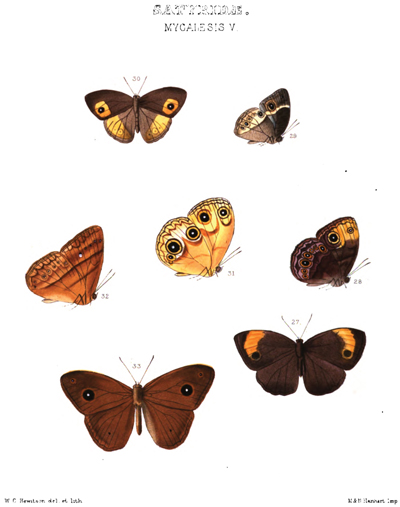
27, 28. MYCALESIS MAIANEAS
29, 30. MYCALESIS MYNOIS
31. MYCALESIS DINON
32, 33. MYCALESIS MNASICLES
SATYRIDÆ.
MYCALESIS. V.
MYCALESIS MAIANEAS. ♀ 27, 28.
UPPERSIDE. Male dark brown; the outer half nearly of the anterior wing, and the outer margin of the posterior wing, rufous brown. Anterior wing with a tuft of hair near the inner margin; the margins of both wings where they meet silvery white.
UNDERSIDE dark brown to the middle, rufous brown beyond: the outer margin and two submarginal lines dark brown. Anterior wing with three ocelli, two near the apex minute and touching, the third below the middle, large; posterior wing with seven, the first (touching the costal margin), the fourth and fifth large, the rest smaller, all black, with pupil white and iris rufous orange.
Female like the male, except that it has an orange band on both sides of the anterior wing, and has but one ocellus, near the apex, on the underside of the anterior wing.
Exp. ♀ 1 9/10, ♀ 2 2/10 inch. Hab. Malacca and Sarawak.
In the Collection of W. C. Hewitson.
MYCALESIS MYNOIS. 29, 30.
UPPERSIDE. Male brown. Anterior wing dark brown, with a large rufous spot beyond the middle, enclosing a black ocellus. Posterior wing with the basal half and outer margin rufous brown: the outer half rufous orange, with some very indistinct ocelli: the outer margin and two submarginal lines dark brown.
UNDERSIDE brown. Both wings crossed at the middle by a common band of white, both with the outer margin and two submarginal lines dark brown. Anterior wing with two ocelli, one near the apex minute, the other large. Posterior wing rufous beyond the band, with seven ocelli, the second and third (though very minute) of perfect form.
Exp. 1 7/10 inch. Hab. Timor.
In the Collection of W. C. Hewitson.
T
MYCALESIS DINON. ♀ 31.
Mycalesis Dexamenus, var. ♀ Hewitson, Ex. But. Vol. III. Fig. 19.
UPPERSIDE. Male rufous brown. Anterior wing crossed at the middle by a broad band of orange yellow: the wing beyond the band dark brown: the ocelli scarcely visible. Posterior wing with the ocelli and submarginal lines seen through.
UNDERSIDE rufous yellow: both wings crossed at the middle by a twice-curved rufous band, both with the outer margin and two submarginal lines (the inner line zigzag) of brown. Anterior wing with two large ocelli, the lower one broadly bordered with yellow. Posterior wing yellow below the middle, with three ocelli, two large and one small.
Female does not differ from the male, except in size, and in the broader band of the anterior wing.
Exp. ♀ 2 1/10 ♀ 2 4/10 inch. Hab. Macassar.
In the Collections of W. W. Saunders and W. C. Hewitson.
When I believed that the female of this species might be a variety of M. Dexamenus, I had not seen the male.
MYCALESIS DORA.
Mycalesis Deianira. Hewitson, Ex. But. Vol. III. Fig. 13.
When I named this species, I considered that it was sufficiently different from Dejanira, and so it is with us, though not so on the Continent. I have therefore re-named it.
MYCALESIS MNASICLES. 32, 33.
UPPERSIDE. Male rufous brown; both wings with a submarginal black line. Anterior wing with two ocelli, one at the apex minute, the other below the middle, very large. Posterior wing with one indistinct ocellus and a submarginal band of indistinct lunular spots.
UNDERSIDE with the basal half rufous; both wings crossed before the middle, and at the middle by common rufous brown narrow bands: both with two black lines near the outer margin and a submarginal zigzag rufous band. Anterior wing with five ocelli, the first four minute, the fifth larger, and marked with a large white pupil. Posterior wing with seven small ocelli, the first and fifth the largest.
Female does not differ, except in size.
Exp. ♀ 2 ½, ♀ 3 inch. Hab. Sumatra.
In the Collections of W. W. Saunders and W. C. Hewitson.
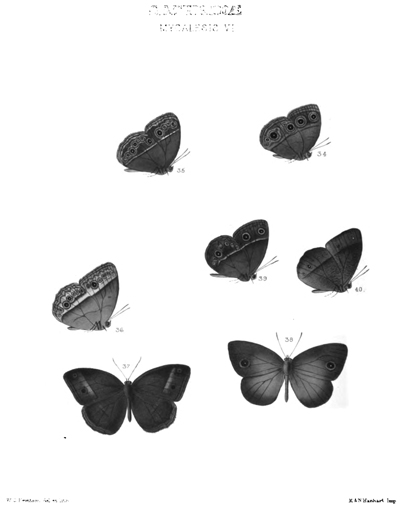
34. MYCALESIS MILYAS
35. MYCALESIS LALASSIS
36, 37. MYCALESIS ORSEIS
38, 39. MYCALESIS OROATIS
40. MYCALESIS ONATAS
SATYRIDÆ
MYCALESIS. VI.
MYCALESIS MILYAS. 34.
UPPERSIDE. Male rufous brown, palest at the apex and outer margin of the anterior wing.
UNDERSIDE rufous brown. Both wings crossed at the middle by a common narrow band of grey, both with two submarginal bands and circles round the ocelli of the same colour. Anterior wing with two large ocelli. Posterior wing with six, the first and fourth large, the rest minute.
Exp. 1 6/10 inch. Hab. White Nile.
In the Collection of W. C. Hewitson.
MYCALESIS LALASSIS. 35.
UPPERSIDE. Male rufous brown, paler at the outer margins, which have near them a line of brown. Anterior wing with a minute white spot opposite the lowest ocellus of the underside.
UNDERSIDE rufous brown. Both wings crossed at the middle by a narrow band of lilac white: both with two submarginal lines, and a very fine line which borders the ocelli (not singly, but all together), lilac white. Anterior wing with four ocelli, the first two touching, the fourth the largest. Posterior wing with seven, the second, third, and sixth minute.
Exp. 1 9/10 inch. Hab. Gilolo.
In the Collections of W. W. Saunders and W. C. Hewitson.
Nearly allied to M. Jopas (Ex. But. fig. 24), from which it differs in the number of ocelli on the posterior wing as well as in being without the line of silvery white which surrounds them, which silvery appearance I have unfortunately omitted to notice both in the drawing and description of M. Jopas.
MYCALESIS ORSEIS. 36, 37.
UPPERSIDE. Male rufous brown, tinted with lilac. Both wings crossed beyond the middle by an indistinct band of lilac (scarcely seen on the posterior wing), both with two submarginal lines of rufous brown. Anterior wing with two or three very indistinct ocelli.
UNDERSIDE. Both wings with the basal half rufous, crossed by a line of darker brown: both crossed at the middle by a broad common band of lilac white: both beyond the band yellow (lilac near the apex), with the outer margin and two submarginal lines (the inner line zigzag) brown. Anterior wing with six ocelli, the first four of equal size, the fifth large, the sixth minute, blind. Posterior wing with seven ocelli, the fourth and sixth largest; the irides bright orange.
Exp. 2 1/10 inch. Hab. Sumatra.
In the Collections of W. W. Saunders and W. C. Hewitson.
MYCALESIS OROATIS. 38, 39.
UPPERSIDE. Male rufous. Anterior wing with the costal margin and the apical half dark brown, with two ocelli, one near the apex, small and indistinct, the other large. Posterior wing with the outer margin broadly brown.
UNDERSIDE dark brown, paler beyond the middle. Both wings crossed at the middle by a narrow common band of lilac: both with the outer margin and two submarginal lines (the inner line much curved) brown. Anterior wing with two large ocelli. Posterior wing with seven, the first four of equal size (the fourth immature), the fifth large.
Exp. 2 inch. Hab. Java.
In the Collection of W. C. Hewitson.
This is nearly allied to M. Tagala, of Felder, but differs from it and the other species in this genus by having the second branch of the subcostal nervure at a distance beyond the end of the cell.
MYCALESIS ONATAS. 40.
UPPERSIDE. Male rufous brown. Anterior wing with the apical half dark brown: one ocellus below the middle, the usual apical ocellus represented on both sides by a minute white spot. Posterior wing with two blind ocelli.
UNDERSIDE rufous brown, undulated with darker colour. Both wings crossed beyond the middle by a straight rufous brown line. Anterior wing with the ocellus as above, but smaller. Posterior wing with six ocelli, five minute, the sixth the largest.
Exp. 2 inch. Hab. Neelgherries.
In the Collection of W. C. Hewitson.
This species is very near to Satyrus Adolphei, of Guérin (Voyage Dellessert, p.76), of which it is probably only a variety, but since his descriptions are always so full and accurate, and he does not mention the undulations of the underside, I have come to the conclusion that it is distinct.
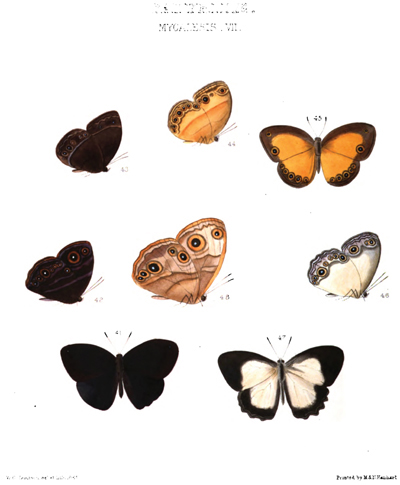
41, 42. MYCALESIS ELIONAS
43. MYCALESIS ARAMIS
44, 45. MYCALESIS ELIASIS
46, 47. MYCALESIS ASOCHIS
48. MYCALESIS XENEAS
SATYRIDÆ.
MYCALESIS. VII.
MYCALESIS ELIONAS. 41, 42.
UPPERSIDE. Male, purple-brown. Anterior wing with a minute white spot near the apex.
UNDERSIDE dark brown, with indistinct transverse bands of lilac. Anterior wing with two ocelli: posterior wing with seven ocelli, the first near the middle of the costal margin, the fifth of large size, the other six small, all black, the irides rufous, the pupils white.
Expan. 1 9/10. Hab. Old Calabar.
In the Collection of W. C. Hewitson.
MYCALESIS ARAMIS. 43.
UPPERSIDE. Male, dark rufous-brown. Anterior wing with one rather large ocellus pupilled with white; posterior wing with one, small and obscure; both wings with a submarginal black line.
UNDERSIDE rufous-brown, crossed near the base of each wing by an obscure band of darker colour; both wings crossed beyond the middle by a common band of lilac, by a zig-zagband of the same colour, and by a submarginal band of black; anterior wing with two small ocelli; posterior wing with six, the fourth larger than the others, all (except the third on the posterior wing, which is rufous) black, the irides obscurely rufous, the pupils minute, white.
Expan. 1 17/20; inch. Hab. Philippine Islands.
In the Collection of W. C Hewitson.
MYCALESIS ELIASIS. 44, 45.
UPPERSIDE. Male, orange. Both wings broadly bordered with rufous-brown, both with a submarginal brown line; anterior wing with two ocelli: posterior wing with six, the third and fourth largest, all black; the irides orange, the pupils white.
UNDERSIDE orange yellow; both wings crossed by two linear rufous bands; both with a broad outer margin of rufous brown; anterior wing with four ocelli (the third blind); posterior wing with seven, all black; the irides orange, the pupils white, all bordered with brown and again with white; both wings with four sub-marginal lines alternately brown and white.
Expan. 1 9/10 inch. Hab. Congo.
In the Collection of the British Museum.
MYCALESIS ASOCHIS. 46, 47.
UPPERSIDE. Male, dark brown, the basal half of both wings white.
UNDERSIDE white, the margins pale brown: each wing crossed beyond the middle by a curved band of pale brown, each with two submarginal curved black lines; anterior wing with three ocelli, two near the apex small, one below larger; posterior wing with seven ocelli, the first large, the second, third, and fourth small, the fifth largest.
Expan, 2 inch. Hab. Old Calabar.
In the Collection of W. C. Hewitson.
MYCALESIS XENEAS. 48.
UPPERSIDE. Female, pale rufous-brown with two submarginal lines of darker brown. Anterior wing crossed beyond the middle by a broad band of white with two obscure ocelli.
UNDERSIDE rufous-brown. Anterior wing crossed near the base by a band of paler colour; the outer half white, with two large ocelli; posterior wing crossed near the base by an indistinct band of paler colour: at the middle by a band of white: beyond the middle by two bands of white surrounding the ocelli, which are five in number, and near the outer margin by a dentate band of the same colour; the ocelli of both wings black, the pupils white, the irides orange-yellow margined with brown.
Expan. 2½ inch. Hab. Old Calabar.
In the Collection of W. C. Hewitson.
The only example of this butterfly which I have seen is much worn and most probably much paler than if it was fresh.
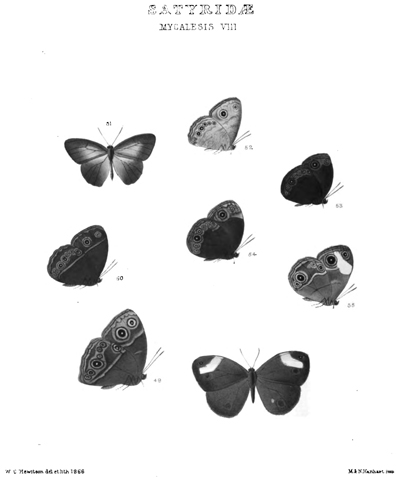
49 MYCALESIS XENEAS.
50. MYCALESIS RHACOTIS.
51, 52. MYCALESIS RÆSACES.
53, 54. MYCALESIS SANAOS
55. MYCALESIS SCIATHIS
SATYRIDÆ.
MYCALESIS VIII.
MYCALESIS XENEAS. 49.
♀ Hewitson's Exotic Butterflies, Vol. III. fig.. 48
UPPERSIDE. Male, dark brown. Anterior wing with one indistinct ocellus.
UNDERSIDE rufous-brown. Both wings crossed at the middle of a narrow lilac band; both with a submarginal line and the margin black. Anterior wing with a short band of lilac within the cell, with two large ocelli, and below them a zigzag band of brown; posterior wing with six ocelli placed in an unusual position, one near the middle of the costal margin, two together considerably below it, and three (the first of which is larger than all the others) near the anal angle; all the ocelli black, pupilled with white, the irides rufous, bordered with brown, and again by lilac.
Expan. 2 2/10 inch. Hab. Old Calabar.
In the Collection of W. C. Hewitson.
MYCALESIS RHACOTIS. 50.
UPPERSIDE. Male, rufous-brown. Posterior wing with a submarginal line of dark brown.
UNDERSIDE rufous-brown. Both wings crossed at the middle by a band of lilac bordered inwardly with brown, both with a marginal band of lilac, its inner border sinuated and traversed by a line of dark brown; the outer margin also brown. Anterior wing with two ocelli (the lower one much the largest); posterior wing with seven ocelli; the first, fourth, and fifth large, the other four much smaller; all black with pupils of white and rufous irides bordered with brown, and again by lilac.
Expan. 1 8/10 inch. Hab. Old Calabar.
In the Collection of W. C. Hewitson.
In its general appearance this species most nearly resembles M. Manipa.
MYCALESIS RÆSACES. 51, 52.
UPPERSIDE. Male, rufous-brown: the middle of the anterior wing, and the costal margin of the posterior wing, paler.
UNDERSIDE white, striated and clouded with rufous-brown. Both wings crossed at the middle by a zigzag rufous-brown line. Anterior wing with two ocelli (the apical one minute and indistinct); posterior wing with seven; the fourth and
G G
fifth largest; all black with white pupils and rufous irides bordered with white. Posterior wing with a marginal band of white traversed by a line of brown; the outer margin brown.
Female (fig. 52) like the male, except that the anterior wings are much broader, and of a uniform rufous-brown; that the underside is more clouded with brown; and that the anterior wing has a zigzag line outside of the ocelli.
Expan. 1 6/10 inch. Hab. Old Calabar.
In the Collection of W. C. Hewitson.
The male of this species has more resemblance in form to the genus Hypocista than it has to Mycalesis.
MYCALESIS SANAOS. 53, 54.
UPPERSIDE. Male, uniform dark lilac brown.
UNDERSIDE dark lilac brown, paler towards the outer margins. Both wings with the margin and two submarginal lines of dark brown. Anterior wing with two ocelli; posterior wing with seven, the fifth larger than the rest; all black with white pupils and rufous irides bordered with dark brown, and again with lilac.
Female like the male, except that it is rufous-brown on both sides; that the anterior wing has on the upperside a space of paler colour beyond the middle on which are two blind ocelli; that the inner submarginal band on the underside of the anterior wing is zigzag; and that there are three or four imperfect minute ocelli on the same wing.
Expan. ♂ 1½, ♀ 1 7/10 inch. Hab. Old Calabar.
In the Collection of W. C. Hewitson.
MYCALESIS SCIATHIS. 55, 56.
UPPERSIDE. Male, rufous-brown slightly tinted with lilac. Anterior wing with one apical ocellus.
UNDERSIDE rufous. Both wings crossed by a narrow brown band before the middle, by a second tortuous band at the middle bordered outwardly with lilac; both with the outer margin and two submarginal lines of brown. Anterior wing with two ocelli; posterior wing with four, two of which are small, one of them indistinct.
Female like the male, except that the anterior wing on the upperside is crossed beyond the middle by a short oblique band of white, and that the central band on the underside is margined outwardly with white.
Expan. ♂ 1 13/20, ♀ 1 19/20 inch. Old Calabar.
In the Collection of W. C. Hewitson.
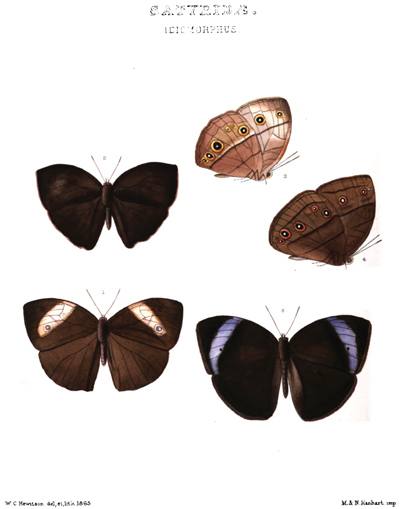
1, 2, 3. IDIOMORPHUS ITALUS
4, 5. IDIOMORPHUS ICCIUS
SATYRIDÆ.
IDIOMORPHUS.
IDIOMORPHUS ITALUS. 1, 2, 3.
UPPERSIDE. Male brown, tinted with lilac towards the apex of the anterior wing; a patch of hair before the middle between the median and submedian nervules. Posterior wing with the anal angle produced, a tuft of hair covering a remarkable spot of peculiar pale brown scales at the end of the discoidal cell.
UNDERSIDE. Rufous, paler towards the margin. Both wings crossed before and at the middle by a transverse common band of brown, both with an indistinct undulated rufous line near the outer margin; the outer margin and fringe brown. Anterior wing with three rufous bands within the cell, with two ocelli, posterior wing with six, the second and third minute: all with a white pupil and orange iris.
Female like the male, except that it is paler and that the anterior wing is crossed beyond the middle by an oblique broad band of white marked by an obscure ocellus.
Exp. ♀ 2 3/10 ♀ 2 6/10. Hab. Old Calabar.
In the Collection of W. C. Hewitson.
IDIOMORPHUS ICCIUS. 4, 5.
UPPERSIDE. Male purple brown. Anterior wing crossed beyond the middle by a lilac band (less oblique than in the last species) marked on its inner border by a small black spot; a patch of long hair before the middle between the median and sub-median nervures. Posterior wing with a tuft of hair (as in the species just described) in the discoidal cell.
UNDERSIDE. Grey brown. Both wings crossed before and at the middle by common bands of dark brown; each with a band of brown (not continuous) beyond the middle: both with the margin and a submarginal line brown. Anterior wing, with three transverse bands within the cell, with two ocelli: posterior wing with six, the second and third scarcely formed, each with a large white pupil and narrow rufous iris.
Exp. 2 8/10 inch. Hab. Old Calabar.
In the Collection of W. C. Hewitson.
The genus Idiomorphus was constructed by M. Doumet to contain an insect of somewhat different contour to tnose now figured, but since they agree in the form of the palpi and the neuration of the wings, I do not hesitate to place them here. The two species now figured are very similar except in colour, the male of I. Iccius having a transverse band as in the female of Italus; the first transverse band of the underside is curved in one, in the other straight.
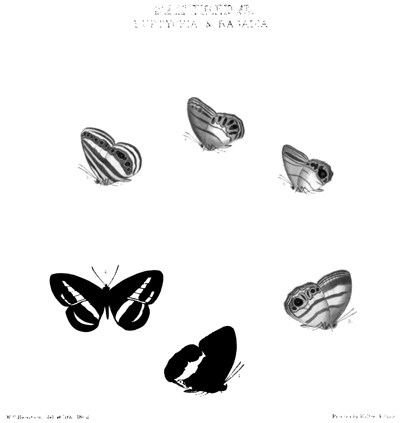
1. EUPTYCHIA NOSSIS
2. EUPTYCHIA NORTIA
3. EUPTYCHIA ITONIS
4. EUPTYCHIA FURINA
5, 6. RAGADIA CRISILDA
SATYRIDÆ.
EUPTYCHIA AND RAGADIA.
EUPTYCHIA NOSSIS. 1.
UPPERSIDE. Male, dark brown, with indistinct submarginal bands of brown; posterior wing with one black ocellus towards the anal angle, with two white pupils, the iris rufous.
UNDERSIDE brown; both wings crossed by two transverse bands of brown; one before, the other at, the middle; both with the outer margin and two parallel lines near it dark brown. Anterior wing with the outer half grey, marked near the apex by one black ocellus, with two pupils and orange iris, and traversed by a band of brown; posterior wing with the inner margin and a broad transverse band of white, followed by four ocelli: two small and imperfect: two large, each with two pupils of silvery white and iris of orange.
Expan. 1 9/10 in. Hab. Quito.
In the Collections of W. W. Saunders and W. C. Hewiteon.
EUPTYCHIA NORTIA. 2.
UPPERSIDE yellow-white, the bands and spots of the underside seen through; both wings, with the outer margin and cilia and two parallel lines near it, dark brown; anterior wing with the base and costal margin brown.
UNDERSDE rufous-white; both wings crossed by three bands of brown; the third (beyond the middle) broad; both with the outer margin, the cilia, and two parallel lines, dark brown; anterior wing with the costal margin grey-brown; posterior wing with four black ocelli (the third largest), all with pupils of light blue, and iris rufous; between the ocelli, which are in pairs, are two orange-yellow spots, each with an oblong silver spot.
Expan. 1 8/10 in. Hab. Amazon.
In the Collections of W. W. Saunders and W. C. Hewitson.
EUPTYCHIA ITONIS. 3.
UPPERSIDE. Male, brown; anterior wing rufous-brown; posterior wing with the basal half white, the outer half dark brown, the outer margin and two parallel lines black, the space between them rufous or white towards the anal angle.
UNDERSIDE. Anterior wing and the base of the posterior grey-brown; both wings crossed before the middle by a rufous-brown line; both with the outer margin and two parallel lines black, the space between the lines white; anterior wing crossed near the middle by a brown line, followed by a broad band of white, bordered with brown
and inclosing a band of brown; traversed by spots and lines of silver; posterior wing, from the base to the middle, yellow-white, with a short rufous line projecting from the costal and inner margins as if part of an imperfect band: outer half orange-yellow, with several black spots nearly covered with silver: one of them large and round with a silver centre.
Expan. 1 9/10 in. Hab. Amazon.
In the Collections of W. W. Saunders and W. C. Hewitson.
EUPTYCHIA FURINA. 4.
UPPERSIDE. Male, brown; both wings with the outer margin and two parallel lines of dark brown; posterior wing with a large white spot (crossed by a brown line) at the middle of the costal margin, followed by four or five oblong black spots.
UNDERSIDE. Anterior wing and base of the posterior grey-brown; both wings crossed by two rufous-brown bands; both with the outer margin, cilia and two parallel lines of brown; anterior wing with an ill-defined band of grey-brown beyond the middle, its centre rufous with a silver spot; posterior wing white, with a broad rufous band beyond the middle, having six oblong conical silver spots with their bases black.
Expan. 1 6/10 in. Hab. Amazon.
In the Collections of W. W. Saunders and W. C. Hewitson.
This and the beautiful species which precedes it are closely allied to E. Pagyris of Godart, and E. Cosmophila of Hubner's Zutrage. Mr. Westwood has put one of these with Euptychia, the other in the genus Neonympha; they must not, however, be parted, and are, very likely, sexes of the same species.
RAGADIA CRISILDA. 5, 6.
UPPERSIDE brown; both wings crossed at the middle by a broad oblique band of white; both with a narrow band of white parallel to the outer margin, obscured towards the apex of the anterior wing.
UNDERSIDE white, both wings with the outer margin and five transverse bands brown: three parallel bands before the middle, (crossing the anterior wing obliquely:) the fifth band near the outer margin narrow: the fourth beyond the middle marked with numerous ocelli; on the anterior wing by six, of equal size; on the posterior wing by seven, the third and fifth the largest: the seventh (near the anal angle) minute; all black, with silver pupils, the iris orange: the second, third, and fourth ocelli of the posterior wing inclosed in one iris.
Expan. 1 17/20 in. Hab. Sylhet.
In the Collection of W. C. Hewitson.
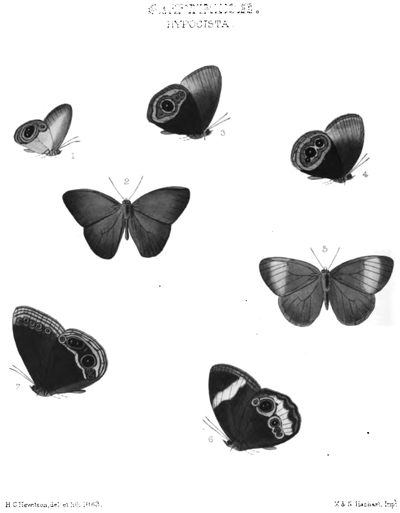
1. HYPOCISTA HÆMONIA
2, 3. HYPOCISTA HYGEA
4, 5. HYPOCISTA HECAERGE
6. ZIPÆTIS SAITIS
7. ZIPÆTIS SCYLAX
SATYRIDÆ
HYPOCISTA AND ZIPÆTIS.
HYPOCISTA HÆMONIA. 1.
UPPERSIDE. Male yellow-brown. Anterior wing with a large central oblong spot of dullyellow. Posterior wing with a large oval trifid black ocellus, with three pupils of white, and one orange-yellow iris.
UNDERSIDE as above, except that the basal half of the posterior wing is pale yellow, that the large ocellus is surrounded by a band of silver, that there is a small black ocellus near the apex with pupil of white and rufous iris, also surrounded with silver, and that there is a submarginal band of silver.
Expan. 1½ in. Hab. New Guinea.
In the Collections of W. W. Saunders and W. C. Hewitson.
Nearly allied to H. Osyris of Boisduval, figured by Dr. Felder in the Wiener Entomologische Monatschrift, Vol. IV. Pl. iii.
HYPOCISTA HYGEA. 2, 3.
UPPERSIDE. Male lilac-brown: the margins dark brown.
UNDERSIDE dark brown from the base to the middle, the outer margins and a line near them dark brown. Anterior wing rufous-brown beyond the middle. Posterior wing with one large ocellus, with the pupil white, the iris rufous, bordered by a band of rufous-brown, which is marked with four minute silvery spots, and surrounded by a broad common band of silver.
Female larger, with broader wings: rufous-brown on the upperside, the anterior wing crossed beyond the middle by a broad pale rufous band. On the underside it does not differ from the male.
Expan. ♀ 1 17/20;; ♀ 2 in. Hab. New Guinea.
In the Collections of W. W. Saunders and W. C. Hewitson.
HYPOCISTA HECAERGE. 4, 5.
UPPERSIDE. Female rufous-brown. Anterior wing crossed beyond the middle by a broad band of pale yellow.
UNDERSIDE. Anterior wing as above, except that the basal half is darker brown, and that the outer margin and a line near it are dark brown. Posterior wing with the basal half dark brown, three large black ocelli beyond the middle, the pupils white, the iris rufous, the whole bordered with rufous-brown, and again with a broad band of silver.
Expan. 1 9/10 in. Hab. New Guinea.
In the Collections of W. W. Saunders and W. C. Hewitson.
ZIPÆTIS. Hewitson.
Body small, hairy. Eyes smooth, small. Palpi long, compressed, thickly clothed with long hair; the last joint scarcely seen. Antennæ slender, short, slightly thicker from the middle to the tip; the articulations short, easily seen.
Anterior wing with the costal margin arched, the apex rounded, the inner margin nearly straight: the costal nervure alone swollen at the base, reaching the middle of the wing: subcostal nervure with four branches, equidistant; two before the end of the discoidal cell: discoidal cell half the length of the wing, closed: upper discocellular nervure very short, the second half as long as the third, slightly curved inwards, the third curved outwards, united to the third branch of the median nervure (which joins at an angle) at a distance from its base.
Posterior wing with the costal nervure joining the margin at the middle of the wing: subcostal nervure with its first branch arising at its middle: the discoidal cell closed obliquely: the upper disco-cellular nervure arising at a short distance below the first branch of the subcostal nervure, the second twice its length, joining the third median nervure at a short distance from its base.
ZIPÆTIS SAITIS. 6.
UPPERSIDE. Male dark brown; both wings crossed beyond the middle by a band of white.
UNDERSIDE as above, except that the posterior wing is crossed by a band of five ocelli, with white pupils and rufous iris, bordered with silver; the first, fourth, and fifth small, the second large and with two pupils, the third half its size.
Expan. 2 3/10 in. Hab. Neilgherries.
In the Collections of W. W. Saunders and W. C. Hewitson.
ZIPÆTIS SCYLAX. 7.
UPPERSIDE. Dark brown, paler towards the margins: the outer margins rufous, traversed by a submarginal black line.
UNDERSIDE as above, except that there are two submarginal lines of black, that the anterior wing has a band of five small ocelli, the pupils blue, the iris rufous, and that the posterior wing has a band of five ocelli, the pupils blue, the iris rufous; the first, fourth, and fifth small, the fourth oval, with two pupils, the third large; all surrounded by a common band of silver.
Expan. 2 4/10 in. Hab. Sylhet.
In the Collection of W. C. Hewitson.
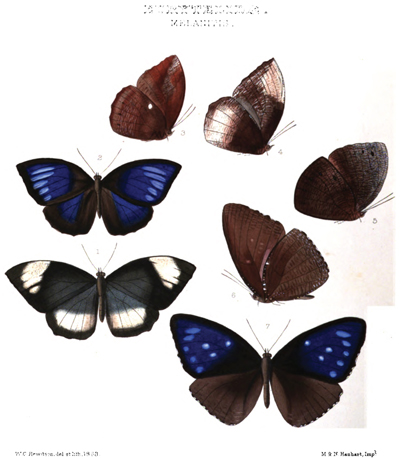
1, 4. MELANITIS PENANGA
2, 3. MELANITIS MEHIDA
5. MELANITIS ESACA
6, 7. MELANITIS MALELAS
EURYTELIDÆ.
MELANITIS.
MELANITIS PENANGA. 1, 4.
Melanitis Penanga, Westwood in Doubleday and Hewitson's Gen. Diur. Lep., p. 405.
UPPERSIDE. Female dark brown; both wings blue-green from the base to the middle. Anterior wing crossed near the apex by a broad band of white. Posterior wing with a large white spot beyond the middle.
UNDERSIDE with the basal half red-brown; the outer half grey, undulated throughout with brown. Anterior wing with a large white triangular spot on the costal margin from its middle to the apex. Posterior wing with an indistinct pale spot near the base.
Expan. 3 1/10 in. Hab. Sumatra.
In the Collections of the British Museum and A. R. Wallace.
The example of this species in the collection of the British Museum, from which Mr. Westwood wrote his description, differs from that now figured. It is without the large white spot on the upperside of the posterior wing, although there is an indication of it; it has, besides, a pale-yellow spot near the middle of the costal margin on the underside of the same wing; this spot, however, is not worth notice as a specific distinction, since some examples of M. Undularis are without it.
MELANITIS MEHIDA. 2, 3.
UPPERSIDE. Male dark brown. Anterior wing glossed with brilliant blue, crossed beyond the middle by a band of five light-blue spots.
UNDERSIDE rufous-brown; darker near the base; undulated throughout with grey. Anteriorwing with a triangular white spot near the apex. Posterior wing with a white spot nearthe middle of the costal margin and a minute submarginal black spot dotted with white.
Expan. 2 7/10 in. Hab. Singapore.
In the Collection of A. R. Wallace.
This and M. Penanga are very probably the sexes of one species.
MELANITIS ESACA. 5.
Melanitis Esaca, Westwood in Doubleday and Hewitson's Gen. Diur. Lep., p. 405.
UPPERSIDE dark brown; crossed near the outer margin by a curved band of six large ill-defined lilac spots. Posterior wing with a marginal band of five indistinct grey spots.
UNDERSIDE red-brown, closely undulated throughout with grey. Anterior wing with the apex nearly white, marked with two black spots. Posterior wing with a black spot dotted with white near the costal margin before the middle, and a sub-marginal band of five black spots, indistinctly dotted with white.
Expan. 2½ in. Hab. East India.
In the Collection of the British Museum.
MELANITIS MALELAS. 6, 7.
UPPERSIDE. Male dark brown. Anterior wing glossed with brilliant blue; marked with eight spots of light blue, three in the form of a triangle near the centre, five forming a curved submarginal band.
UNDERSIDE rufous-brown, undulated with grey towards the outer margins of both wings. Anterior wing with a pale spot at the end of the cell. Posterior wing with several spots of white near the base; the inner margin undulated with grey.
Expan. 3 2/10 in. Hab. East India.
In the Collections of W. W. Saunders and W. C. Hewitson.
This species is nearly allied to M. Casiphone of Hubner and to M. Patua of Westwood
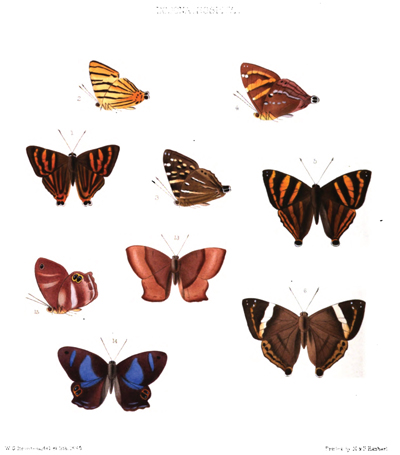
1, 2. DODONA ADONIRA
3. DODONA DIPOEA
4, 5, 6. DODONA OUIDA
13. SOSPITA LYDDA
14, 15. SOSPITA TANTALUS
ERYCNIDÆ.
DODONA AND SOSPITA.
DODONA ADONIRA. 1, 2.
UPPERSIDE. Male, dark brown, paler near the base. Anterior wing crossed transversely by three parallel equidistant rufous bands; posterior wing lobed at the anal angle: crossed obliquely by four narrower bands of the same colour; the anal lobe marked by two spots of black: rufous above the lobe and spotted with black.
UNDERSIDE orange-yellow with the outer margins dark brown; both wings crossed by five narrow dark brown bands, broken where the wings meet; anterior wing with a sixth short band beyond the third: posterior wing with a sixth and seventh band near the inner margin: orange near the anal lobe and marked with several black spots.
Expan. 1½ inch. Hab. East India (Darjeeling).
In the Collection of W. C. Hewitson.
DODONA DIPOEA. 3.
UPPERSIDE. Male, dark brown; anterior wing with macular bands and spots rufous and white; posterior wing with a short rufous band near the middle and two submarginal bands of the same colour.
UNDERSIDE rufous-brown; anterior wing as above; posterior wing crossed near the base and inner margin by three bands of paler colour, the third silvery near its base: a silver spot on the middle of the costal margin, a band of pale brown below it which curves upwards towards the inner margin and bordered inwardly with black: beyond the middle a short band of white also bordered inwardly with black, and below it a band of black which bends upwards to the inner margin when it reaches the anal lobe: two black spots bordered above and below with white and a submarginal band of brown bordered on each side with white: the lobe black bordered with white.
Expan. 1 8/10 inch. Hab. East India (Darjeeling)
In the Collection of Mr. Atkinson of Calcutta.
I have hesitated before describing this as a species distinct from D. Egeon; they are alike on the upperside, but whilst the underside of the posterior wing of D. Egeon is crossed by broad bands of silvery white without any margin, this species has narrow bands of white margined by black.
D D
DODONA OUIDA. 4, 5, 6.
UPPSIDE. Male, dark brown; both wings crossed by three rufous bands; anterior wing with two minute white spots near the apex; posterior wing with a fourth rufous band near the outer margin.
UNDERSIDE rufous; as above except that the transverse bands of the anterior wing are spotted with white at the costal margin, that the inner band of the posterior wing is spotted with white near the base, and that there are three black spots bordered below with white, one near the middle of the costal margin and two near the apex, and also a small black and white spot near the anal lobe.
Female like the male, except that the wings are paler, that both wings are without the band nearest the base, that the central band of the anterior wing is broader and nearly white, that of the posterior wing scarcely seen.
Expan. ♂ 1 8/10 ♀ 2 inches. Hab. East India (Darjeeling).
In the Collection of W. C Hewitson.
SOSPITA LYDDA. 13.
UPPERSIDE. Male, lilac-brown: a transverse band at the middle and the outer margins dark rufous-brown; anterior wing with a black line at the end of the cell.
UNDERSIDE as above, except that there are three indistinct black spots on the posterior wing, two near the apex, one near the anal angle.
Female (fig. 13) like the male, except that it is of much paler colour.
Expan. 1 13/20 inch. Hab. Hong Kong.
In the Collections of the British Museum and W. C. Hewitson.
SOSPITA TANTALUS. 14, 15.
UPPERSIDE. Male, carmine-brown; anterior wing crossed by a broad and narrow band of lilac: a blue-black spot near the apex; posterior wing with a lilac spot near the costal margin; a bifid blue-black binocular spot near the apex dotted with blue; two indistinct submarginal lilac bands.
UNDERSIDE paler; anterior wing crossed by two bands of white; posterior wing with three bands and a spot at the base, white.
Female like the male, except that it is without the lilac bands and spot and has two large spots of white towards the apex of the anterior wing.
Expan. 1 8/10 inch. Hab. Old Calabar.
In the Collection of W. C. Hewitson.
The female of this species is figured in the second volume of this work. Plate XLVI.

7, 8. SOSPITA WALLACEI
9, 10, 11, 12. SOSPITA STATIRA
ERYCINIDÆ.
SOSPITA. II.
SOSPITA WALLACEI 7, 8.
UPPERSIDE. Male black. Anterior wing crossed towards the apex by a band of three grey-white spots; the apex with a minute white spot; posterior wing with a large grey-white spot, divided into three by the nervures: the outer margin spotted with white.
UNDERSIDE dark brown; anterior wing with three transverse bands of dirty white; the first, within the cell, short: the second at the middle: the third halfway between it and the apex, curved; two minute white spots at the apex; posterior wing darker brown: three white spots within the cell and a semicircular band of indistinct dirty white spots near the middle; a submarginal band of orange marked with five black spots, bordered above and below with white; outer margin black spotted with white.
Expan. 2 4/10 in. Hab. Mysol.
In the Collection of A. R. Wallace.
C
SOSPITA STATIRA. 9, 10, 11, 12.
UPPERSIDE. Male dark brown; the posterior wing with a submarginal band of orange spots.
UNDERSIDE brown; anterior wing with a small spot near the base, three transverse bands, two spots near the apex and a minute spot at the apex all white; posterior wing with three white spots within the cell: a curved band of oblong black spots at the middle, the two spots nearest the inner margin bordered above and below with grey-white: a second submarginal band of oblong black spots bordered above and below with white: followed by a band of orange marked on the outer margin with black spots: a spot of white at the anal angle.
Female rufous-brown; anterior wing with the outer half black: crossed beyond the middle by a broad orange-yellow band followed by a minute white spot; the apex with two minute white spots; posterior wing crossed at the middle and again near the outer margin by short curved bands each of three black spots: the outer margin also marked with black spots with rufous lunular spots between them. Underside with the base of the anterior wing and the whole of the posterior wing rufous; anterior wing black with the central transverse band as above, a round black spot near the base, a curved band of white spots towards the apex as in the male, two spots of white nearer the apex and two at the apex also white; posterior wing as in the male, except that the three spots near the base are black, and that the central curved band of black spots is broken in the middle.
Expan. 2 2/10 in. Hab. Mysol.
In the Collections of W. W. Saunders and W. C. Hewitson.
I have named one of these very beautiful new butterflies after its discoverer Mr. Wallace. No naturalists who have ever yet left the shores of Europe to explore the unknown glories of the tropics have so well deserved the gratitude of entomologists as Mr. Wallace and Mr. Bates have done, and if they had taken their collections to the Continent they might have had their names repeated ad nauseam, but I do not believe that this would have been to the taste of my countrymen. Such a mark of the approbation of his brother naturalists might have been considered an honour worth winning, if bestowed upon those only who have earned it by years of devotion to the cause, but when given indiscriminately, and to those who have never done anything to deserve it, it becomes of little value.
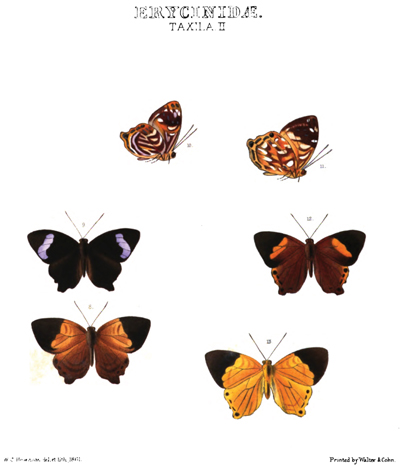
8, 9, 10. TAXILA PULCHRA.
11, 12, 13. TAXILA DECORATA.
ERYCINIDÆ.
TAXILA. II.
TAXILA PULCHRA. 8, 9, 10.
♀ Argynnis Pulchra Gúer. Voy. Coquil., pl. 16, fig. 2, 3.
UPPERSIDE. Male dark brown; anterior wing crossed, from the first discoidal nervule to the outer margin near the anal angle, by a band of silvery white.
UNDERSIDE rufous with numerous bands of white; anterior wing with the outer half dark rufous-brown; a band and two spots within the cell, a lunular spot at the end of the cell, two curved transverse bands of white spots beyond the middle: the first band of five detached spots (four small and silvery, the fifth larger), the second band nearly continuous; two silvery white spots near the apex (one partly black); posterior wing with a short tail: crossed from its costal margin to the median nervule by four curved bands of white followed by two silvery white spots, the median nervules broadly white followed by two curved bands of white parallel to the outer margin: a submarginal band of silvery white spots, the middle spot at the base of the tail with its centre black: a black spot near the apex.
Female rufous; anterior wing with a large central space of orange-yellow, the outer half black; the posterior wing with the outer margin and some spots near it dark brown. On the underside the sexes are exactly alike.
Expan. 1 8/10 in. Hab. Waigiou.
In the Collections of W. W. Saunders and W. C. Hewitson.
TAXILA DECORATA. 11, 12, 13.
UPPERSIDE. Male brick-red; anterior wing crossed obliquely at the middle by a band of rufous-orange: the outer half dark brown; posterior wing with its outer margin from the apex to the tail paler, marked with four black spots.
UNDERSIDE rufous with numerous spots and bands of white; anterior wing with the outer half dark rufous-brown; a lunutar spot within the cell, a second beyond the cell, a silvery-white spot and larger pale-yellow spot towards the anal angle; two transverse curved bands beyond the middle: the first of detached silvery white spots, the second continuous: two silvery-white spots near the apex; posterior wing crowded with round and oblong white spots; a submarginal band of silver spots, the middle spot at the base of the tail with its centre black; a black spot also near the apex.
Female orange-yellow; anterior wing with the outer half dark brown; posterior wing with submarginal black spots from the apex to the tail. On the underside the sexes are alike, except that some of the spots which are white in the male, are indistinct and rufous in the female.
Expan. 1 8/10 in. Hab. Aru.
In the Collections of W. W. Saunders and W. C. Hewitson.
Although the female of Taxila Pulchra has been figured in the voyage of the Coquille, I have thought it well to repeat it here together with its male, to show the difference and at the same time the great similarity of these two species.
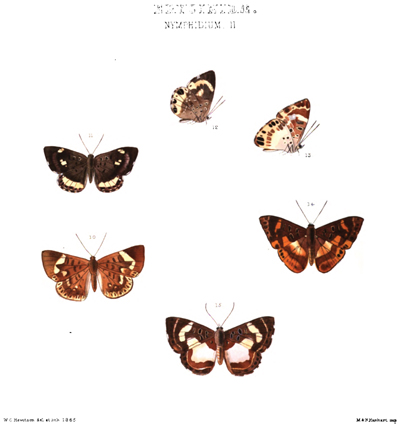
10. NYMPHIDIUM ARCHE
11, 12. NYMPHIDIUM EROE
13, 14, 15. NYMPHIDIUM APAME
ERYCINIDÆ.
NYMPHIDIUM. II.
NYMPHIDIUM ARCHE. 10.
UPPERSIDE. Female rufous-brown. Anterior wing with five brown spots near the base: a transverse band beyond the middle, a spot near the middle of the inner margin, and a spot near the anal angle, all pale yellow. Posterior wing with two linear spots in the cell, a band of five spots at the middle and a submarginal band of eight oblong white spots, each marked with a brown spot.
UNDERSIDE as above, except that it is much paler, and that there are two small rufous spots on the costal margin of the posterior wing before its middle.
Exp. 1 9/10 inch. Hab. Amazon.
In the Collections of W. W. Saunders and W. C. Hewitson.
This may be a variety of N. Soranus, but differs from it too much to be considered as such.
NYMPHIDIUM EROE. 11, 12.
UPPERSIDE. Female purple brown. Anterior wing with the usual black spots in and below the cell: a spot on the costal margin and a cruciform spot below it at the middle of the wing pale yellow. Posterior wing with a brown spot at the end of the cell, a transverse broad band of pale yellow beyond the middle, followed by a band of dark brown spots, a band of linear obscure spots of white: the margin dark brown, the fringe alternately grey and brown.
UNDERSIDE as above, except that it is paler; that the anterior wing is crossed by a continuous band of white and has two dark brown spots near its anal angle; that the band of the posterior wing is preceded by some pale spots, is continued to the outer margin, and is marked by conical black spots, large and in pairs, near the angles.
Exp. 1 7/10 inch. Hab. Cayenne.
In the Collection of W. C. Hewitson.
On the underside this species scarcely differs from N. Arctos, of which it may be probably only a variety.
NYMPHIDIUM APAME. 13, 14, 15.
UPPERSIDE. Male rufous-brown, with four dark brown spots near the base, with rufous border, a transverse band broken in the middle, a submarginal obscure linear band, and a spot near the anal angle, all rufous-orange. Posterior wing crossed near the middle by a pale broad rufous band: the outer margin broadly rufous-orange, with three dark brown spots near the apex.
UNDERSIDE. Anterior wing grey-brown; the central band, which is continuous, the submarginal band, and the spot near the anal angle, all white. Posterior wing white, with three dark brown spots near the base, a broken band of brown spots beyond the middle, and a submarginal band of dark brown spots, three at each angle, and one between them.
Female with the upperside rufous-brown; five brown spots near the base, bordered with white. Both wings crossed by a common white band broken and deeply sinuated on its inner side on the anterior wing, very broad on the posterior wing: both with a submarginal pale rufous white band, followed nearer the margin by dark brown spots. On the underside it does not differ from the male.
Exp. 2 inches. Hab. Amazon.
In the Collections of W. W. Saunders and W. C. Hewitson.
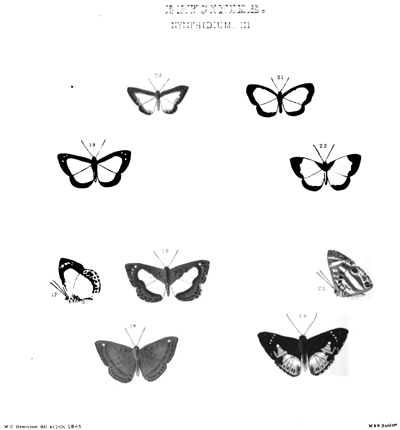
16, 17, 18. NYMPHIDIUM MYCONE
19. NYMPHIDIUM MYCEA
20. NYMPHIDIUM OMOIS
21. NYMPHIDIUM ONOBA
22. NYMPHIDIUM NINIAS
23, 24. NYMPHIDIUM MOLELA
ERYCINIDÆ.
NYMPHIDIUM III.
NYMPHIDIUM MYCONE. 16, 17, 18.
UPPERSIDE. Male rufous-brown. Both wings with some rufous-brown spots, both crossed beyond the middle by a band of rufous-brown. Anterior wing with a white spot near the apex; posterior wing with a submarginal band of brown spots, bordered above and below with white.
UNDERSIDE white. Anterior wing with the spots and bands as above, but very pale. Posterior wing white, with some spots at the base, a transverse rufous band beyond the middle, and a submarginal band of black spots.
Female rufous-brown with some spots at the base, and a central common broad band. Anterior wing with an apical band of white spots. Posterior wing with a sub-marginal band of lunular brown spots bordered above and below with white, the fringe spotted with white.
Exp. 1 ½ inch. Hab. Nicaragua.
In the Collection of W. C. Hewitson.
The female of this species scarcely differs from N. Calyce of Felder.
NYMPHIDIUM MYCEA. 19.
UPPERSIDE. Pale yellow, with the margins broadly dark brown; the outer margin of both wings traversed by a rufous band. Anterior wing with three white spots near the apex.
UNDERSIDE as above.
Exp. 1 3/10 inch. Hab. New Granada.
In the Collection of W. C. Hewitson.
A A
NYMPHIDIUM OMOIS. 20.
UPPERSIDE white. Both wings with a marginal band of conical dark brown spots, bordered with white: both with an orange spot near the anal angle. Anterior wing with the costal margin and apex broadly rufous-brown.
UNDERSIDE as above.
Female does not differ from the male except in form.
Exp. 1 1/10 inch. Hab. Amazon.
In the Collections of W. W. Saunders and W. C. Hewitson.
NYMPHIDIUM ONOBA. 21.
UPPERSIDE pale yellow; the margins dark brown. Both wings with a marginal band of lunular spots bordered with grey blue.
UNDERSIDE as above, except that there are some white spots at the outer margin of both wings.
Exp. 1 2/10 inch. Hab. Cayenne.
In the Collection of W. C. Hewitson.
NYMPHIDIUM NINIAS. 22.
UPPERSIDE. Male white. Both wings with the base brown, and a marginal row of conical spots bordered with white: both with an orange spot at the anal angle. Anterior wing with the apex broadly brown.
UNDERSIDE as above, except that there are some white spots on the outer margin of both wings.
Exp. l 5/20 inch. Hab. Amazon.
In the Collection of W. C. Hewitson.
NYMPHIDIUM MOLELA. 23, 24.
UPPERSIDE. Male dark brown. Anterior wing crossed obliquely from the costal margin beyond its middle by a band of four minute white spots; crossed from the median nervure to the inner margin by a band of blue commencing with a spot of white; an obscure band near the outer margin and a lunular spot of blue near the anal angle. Posterior wing crossed at the middle by a band of white; the outer half blue, marked at the apex by a spot of dark brown, and a submarginal band of black spots: the margin black, the fringe spotted with white.
UNDERSIDE rufous-brown. Both wings crossed by a central common band of white, both with a submarginal band and some marginal spots of lilac-white. Anterior wing with three black spots near the base, three bands across the cell, a small spot at the end of the cell, and an oblique band beyond the middle, all lilac-white. Posterior wing with two bands of lilac-white near the base.
Exp. 1 6/10 inch. Hab. Amazon.
In the Collections of W. W. Saunders and W. C. Hewitson.
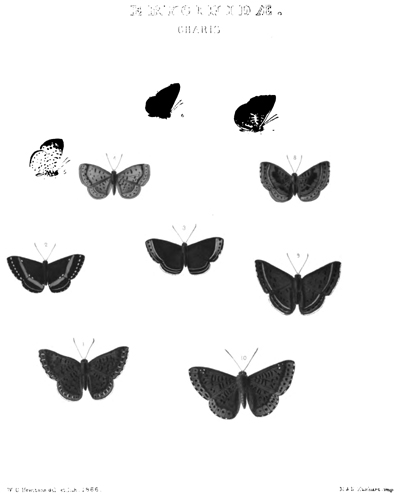
1. CHARIS CADMEIS.
2. CHARIS CœCIAS.
3. CHARIS CADYTIS.
4, 5. CHARIS CALICENE.
6. CHARIS CARYATIS
7, 8. CHARIS CHAONITIS
9. CHARIS CHELONIS
10. CHARIS CLEADAS
ERYCINIDÆ.
CHARIS.
CHARIS CADMEIS. 1.
UPPERSIDE. Male, brown. Both wings crossed by several bands of black; the outer margins paler and traversed by a band of black spots, the nervures between the spots marked with silver; the fringe white.
UNDERSIDE as above, except that it is glossed with blue, and is without the silver lines.
Expan. 1 4/10 inch. Hab. Amazon.
In the Collections of W. W. Saunders and W. C. Hewitson.
CHARIS CœCIAS. 2.
UPPERSIDE. Male, dark brown. Both wings crossed beyond the middle by a band of scarlet, and marked above each end of both wings by irrorations of silver (very slight on the anterior wing). Anterior wing with a submarginal band of silver spots; posterior wing with a continuous band of the same colour; the margins spotted with white.
UNDERSIDE as above, except that the scarlet band is much broader, and that the silver band of the posterior wing is in spots.
Expan. 1 2/10 inch. Hab. Upper Amazon.
In the Collection of W. C. Hewitson.
CHARIS CADYTIS. 3.
UPPERSIDE. Male, dark brown. Both wings with two submarginal lines of silver; the fringe white. Anterior wing orange spotted with black between the bands of silver from the apex to the middle.
UNDERSIDE as above, except that there is only one band of silver, and that there is a broad band of white on the outer margin.
Expan. 1 2/10 inch. Hab. Rio Grande.
In the Collection of W. C. Hewitson.
CHARIS CALICENE. 4, 5.
UPPERSIDE. Female, rufous-orange. Both wings with numerous spots and bands of black; both crossed by a band of brown beyond the middle, by two bands of silver, the space between them traversed by a band of black spots.
UNDERSIDE as above, except that it is orange-yellow, nearly white at the costal margin of the posterior wing; that there are no bands of silver, and that there is no brown band except from the costal margin to the middle of the anterior wing.
Expan. 1 1/10 inch.
In the Collection of W. C. Hewitson.
CHARIS CARYATIS.
C. Cleonus Godart Encl. Method., p. 573.
UPPERSIDE. Male, dark brown. Both wings with two submarginal lines of silver; the space between them rufous-brown, traversed by a band of black spots; the fringe white, intersected with black near the apex of the anterior wing.
UNDERSIDE dark brown. Each wing with a single line of silver, very broad on the anterior wing.
Expan. 9/10 inch. Hab. Amazon.
In the Collections of W. C. Hewitson and W. W. Saunders.
This is the butterfly described by Godart, but not the P. Cleonus of Cramer, who figures an insect with two submarginal lines of silver on both sides of the wings.
CHARIS CHAONITIS. 7, 8.
UPPERSIDE. Female, brown spotted with black near the base, crossed at the middle by a broad band of dark brown; the outer margin broadly rufous; two submarginal lines of silvery blue with between them a band of black spots.
UNDERSIDE dull yellow with numerous spots and bands of black; crossed beyond the middle by a band of brown; the submarginal spots as above.
Expan. 1 1/10 inch. Hab. Amazon.
In the Collections of W. W. Saunders and W. C. Hewitson.
CHARIS CHELONIS. 9.
UPPERSIDE. Male, brown marked indistinctly with black spots. Both wings crossed by a band of silver; both with a submarginal band of black spots. Posterior wing with a second line of silver very slightly indicated near the anal angle of the anterior wing.
UNDERSIDE dull grey-blue. Posterior wing crossed at the middle by a band of black spots; the outer margin paler than the rest of the wing, traversed by indistinctly markedblack spots.
Expan. l 7/20 inch. Hab. Rio Janeiro.
In the Collection of W. C. Hewitson.
CHARIS CLEADAS. 10.
UPPERSIDE. Male, rufous-brown, paler at the outer margins. Both wings with numerous bands and spots of black; both with a submarginal band of black spots and white spots onthe margin. Anterior wing with two white spots near the costal margin.
UNDERSIDE as above, except that it is paler, that the black spots are bordered outwardly with paler colour (those of the submarginal band on both sides). Posterior wing with two of the submarginal spots larger than the others.
Expan. 1 13/20 inches. Hab. Amazon.
In the Collections of W. W. Saunders and W. C. Hewitson.
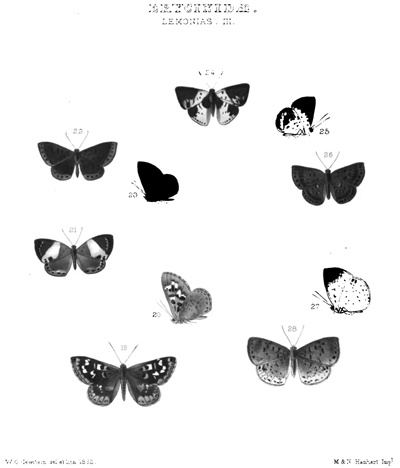
19, 20. LEMONIAS AURINIA
21. LEMONIAS AUSERIS
22, 23. LEMONIAS BALISTA
24, 25, 26. LEMONIAS CICUTA
27, 28. LEMONIAS FELSINA
ERYCINIDÆ.
LEMONIAS. III.
LEMONIAS AURINIA. 19, 20.
UPPERSIDE. Male brown: anterior wing with the base of the costal margin, a spot at themiddle of the cell, a spot below it, a spot at the end of the cell, and a band near the outer margin, all rufous; a spot in the cell, and a curved irregular band, divided into six by the nervures (one apart from the rest), all white. Posterior wing with somesmall, indistinct spots in the middle, and a broad submarginal band, rufous: the outermargin and a submarginal band of spots dark brown.
UNDERSIDE. Anterior wing nearly as above, but without the submarginal rufous band: posterior wing pale rufous-brown, with numerous lines and spots, and a sub-marginal band of spots, all rufous-brown.
Expan. 1 6/10 in. Hab. Amazon.
In the Collections of W. W. Saunders and W. C. Hewitson.
LEMONIAS AUSERIS. 21.
UPPERSIDE. Female brown: anterior wing with the base rufous-brown: crossed at the middle by a broad band of pale yellow, marked at its lower extremity by two dark-brown spots: beyond the band dark brown, traversed by a line of grey: posterior wing rufous-brown; the outer margin broadly rufous, traversed by a band of black spots.
UNDERSIDE white. Anterior wing with the apex broadly brown, marked by a line and spot of white: a spot on the outer margin below the middle, and three spots near the anal angle, dark brown: posterior wing with a band of indistinct pale-brown spots beyond themiddle: the outer margin, two spots at the apex, two at the anal angle, and one or twominute spots between them, dark brown.
Expan. 1 3/20 in. Hab. Amazon.
In the Collections of W. W. Saunders and W. C. Hewitson.
M
LEMONIAS BALISTA. 22, 23.
UPPERSIDE. Male dark brown, with indistinct black spots, paler near the margins, which are marked by a band of black spots.
UNDERSIDE pale rufous, with numerous rufous-brown spots. Both wings with two spots in the cell, two below them, one at the end of the cell: both crossed at the middle by an irregular band of spots: both with a submarginal band of black spots all bordered with white.
Expan. l 3/10 in. Hab. Amazon.
In the Collections of W. W. Saunders and W. C. Hewitson.
LEMONIAS CICUTA. 24, 25, 26.
UPPERSIDE. Male dark brown. Anterior wing with an oblique band of cerulean blue from the base of the costal margin to the middle of the inner margin, spotted with black, and followed by some lunular blue spots. Posterior wing blue spotted with black; the base and the apex dark brown; the outer margin and a band of spots near it black.
UNDERSIDE white, with numerous dark-brown spots. Anterior wing brown beyond the middle, crossed by a band of white. Posterior wing with the apex and two macular transverse bands brown.
Female brown, clouded and spotted with darker brown, and indistinct pale blue; a submarginal band of black spots. On the underside rufous and grey: both wings with numerous spots, and a transverse central macular band, rufous-brown; both crossed beyond the middle by a pale-rufous band and a submarginal band of dark-brown spots, largest at the angles, and bordered on the posterior wing with white.
Expan. 1 2/10 in. Hab. Amazon.
In the Collection of W. C. Hewitson.
LEMONIAS FELSINA. 27, 28.
UPPERSIDE. Female rufous-brown. Both wings with several black spots, and a submarginal band of spots also black. Anterior wing with the anal angle grey, with some small white spots. Posterior wing with the outer margin broadly white.
UNDERSIDE white, with numerous indistinct rufous-brown spots. Anterior wing with the costal margin and apex rufous. Posterior wing with two larger dark-brown spots at the apex.
Expan. 1 4/10 in. Hab. Rio de Janeiro.
In the Collection of W. C. Hewitson.
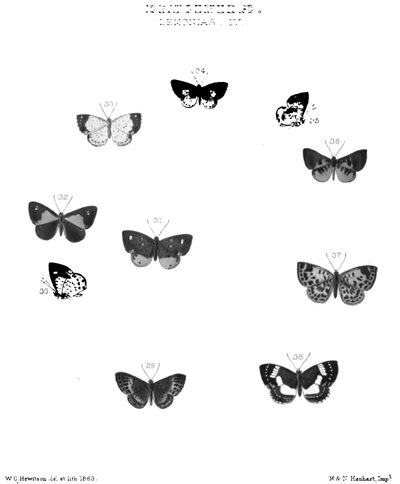
29. LEMONIAS AMINIAS.
30, 31, 32. LEMONIAS ANCILE.
33, 34. LEMONIAS CILISSA.
35, 36. LEMONIAS BORSIPPA.
37. LEMONIAS CEREALIS.
38. LEMONIAS CHEA.
ERYCINIDÆ.
LEMONIAS. IV.
LEMONIAS AMINIAS. 29.
UPPERSIDE. Male dark brown; both wings crossed beyond the middle by a broad ill-defined band of lilac, with some black spots: both with a broad submarginal band of lilac spotted with black: the nervures between the two bands also lilac.
UNDERSIDE grey-brown, with numerous small spots, and a submarginal band of larger spots, all dark brown bordered with white.
Expan. 1 1/20 in. Hab. Amazon.
In the Collection of W. C. Hewitson.
I think it very likely that this is the male of Hubner's Leucophæa, although he considers that he has figured both sexes.
LEMONIAS ANCILE. 30, 31, 32.
UPPERSIDE. Male dark brown. Anterior wing orange from the inner margin to beyond the middle; a bifid white spot towards the apex. Posterior wing with a line of white near the apex.
UNDERSIDE. Anterior wing nearly as above but much paler. Posterior wing grey. Both wings with some brown spots before the middle; both crossed beyond the middle by a band of white spots; both with submarginal spots of dark brown.
Female dark brown. Anterior wing with two spots near the base, and one at the anal angle, rufous; a white spot towards the apex. Posterior wing with the outer half orange, with two submarginal spots of dark brown.
Expan. 1 in. Hab. Amazon.
In the Collections of W. W. Saunders and W. C. Hewitson.
LEMONIAS CILISSA. 33, 34.
UPPERSIDE. Male orange, spotted with brown. Anterior wing with the costal margin and outer half red-brown, with a band of minute white spots near the apex. Posterior wing with a submarginal band of brown spots.
UNDERSIDE. Anterior wing pale yellow, the outer margin broadly grey-brown. Posterior wing white. Both wings with numerous brown spots; both with a sub-marginal band of dark-brown spots, bordered with white on the anterior wing, bordered with brown on the posterior wing.
Female yellow, with numerous brown spots. Anterior wing with the outer margin broadly red-brown, traversed by a band of white spots. Posterior wing with the apex red-brown, a submarginal band of white spots, bordered with brown.
UNDERSIDE as above.
Expan. ♀ 8/10 in.; ♀ 1 in. Hab. Nicaragua.
In the Collection of W. C. Hewitson.
LEMONIAS BORSIPPA. 35, 36.
UPPERSIDE. Male grey-brown, with bands of orange in and below the cell. Posterior wingorange, with the costal margin and several short bands from it brown.
UNDERSIDE white, clouded with brown. Both wings with some orange spots before the middle, both with a band beyond the middle; the outer margin and several submarginal spotsbrown.
Expan. 1 in. Hab. Amazon.
In the Collection of W. C. Hewitson.
LEMONIAS CEREALIS. 37.
UPPERSIDE. Male orange-yellow. Both wings with numerous spots, a transverse band of spots beyond the middle broad near the apex of the anterior wing, and a submarginal bandof spots, all dark brown.
UNDERSIDE as above.
Female larger and brighter in colour.
Expan. ♀ 17/20 in.; ♀ 1 2/10 in. Hab. Amazon.
In the Collections of W. W. Saunders and W. C. Hewitson.
LEMONIAS CHEA. 38.
UPPERSIDE. Female dark brown. Both wings crossed at the middle by a broad common band of white, broken on the anterior wing, broader on the posterior wing; both wings crossed beyond the middle by a band of white spots, both with an orange spot near the anal angle. Posterior wing with a submarginal band of black spots, bordered below with white.
UNDERSIDE as above, except that it is rufous where brown above, that the base is marked alternately with orange and white.
Expan. 1 2/10 in. Hab. Amazon.
In the Collections of W. W. Saunders and W. C. Hewitson.
This species much resembles the female of L. Zygia of Hubner.
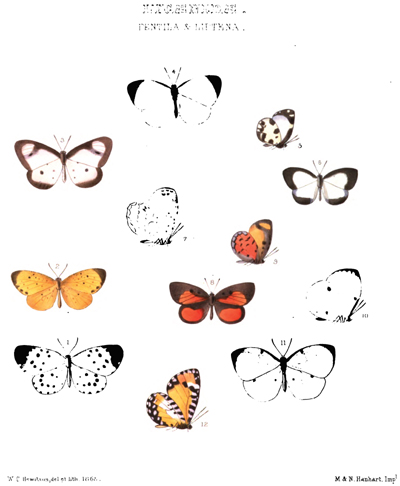
1, 2. PENTILA TROPICALIS.
3. PENTILA PEUCETIA.
4. LIPTENA LAGYRA.
5, 6. LIPTENA LIBYSSA.
7. LIPTENA UNDULARIS.
8, 9. LIPTENA LIBENTINA.
10, 11. LIPTENA LIRCÆA.
12. LIPTENA ACRÆA.
LYCÆNIDÆ.
PENTILA AND LIPTENA.
PENTILA TROPICALIS. 1, 2.
Tingra tropicalis Boisduval. Voy. Delagorgue, page 589. Liptena Abraxas, Westwood in Doubleday and Hewitson's Gen. Diurnal Lep., Plate 77, fig. 5. Pentila Abraxas, page 504.
UPPERSIDE. Male, rufous-orange. Anterior wing with several minute spots, the apex and spots on the upper margin brown; posterior wing with one spot.
UNDERSIDE uniform orange-yellow. Both wings with numerous spots (thirty or forty) and undulations of brown.
Variety. Male with the apex and outer margin of the anterior wing broadly brown: the posterior wing also margined with brown.
Female like the male, except that it has (instead of the brown at the apex) a submarginal band of brown spots.
Variety. Female white, with the apex of the anterior wing broadly brown, the spots larger and alike on both sides, as in figure 1; or with the spots less numerous as in P. Abraxas of Westwood.
Expan. ♂ 1½, ♀ 1 15/20 inch. Hab. Natal and Old Calabar.
In the Collections of W. W. Saunders and W. C. Hewitson,
Mr. Westwood, after having, in error, used the name of Liptena for this groupe on plate 77 of the "Diurnal Lepidoptera," adopted the name Pentila (which Boisduval had given to a part of it only), not being then aware that Boisduval's genus Tingra was synonymous. I would gladly have adopted the earlier name of Tingra, but since it has never been characterized by its author the genus Pentila of the "Genera" must stand. Westwood's first species, L. Undularis, it is true, was Boisduval's type of Pentila, but since the dissections for Westwood's genus Pentila have been made from P. Tropicalis, it must be considered his typical species. In Pentila the palpi are very minute, the discordal cell long. In Liptena the palpi are long, the cell short.
PENTILA PEUCETIA. 3.
UPPERSIDE. Male, transparent white. The wings broadly margined with brown; anterior wing crossed beyond the middle by a band of brown marked by a black spot; posterior wing with a central black spot.
UNDERSIDE as above except that the posterior wing has three black spots.
Expan. 1 6/10 inch. Hab. Zambezi.
In the Collection of W. C. Hewitson.
LIPTENA. HEWITSON.
Eyes small, smooth. Palpi smooth, long; the second joint compressed, reaching above the head; the terminal joint widest near its point. Anterior wing with the costal nervure short, not reaching the middle of the wing; the subcostal nervure four-branched; two branches near together before the end of the cell, two beyond and at a distance from it; the cell broad, short, not much more than a third of the wing in length, closed at a right angle nearly, by the disco-cellular nervules, the first of which is very short, the third twice the length of the second and curved inwardly. Posterior wing with the cell short, closed in some species much more obliquely than in others. All the feet with the tarsi very long and slender (longer than in Pentila).
LIPTENA LAGYRA. 4.
UPPERSIDE. Male, white. Anterior wing with the base of the costal margin and apex pale brown.
UNDERSIDE as above, except that it is spotless white throughout.
Expan. 1½ inch. Hab. Old Calabar.
In the Collection of W. C. Hewitson.
Figured from a very worn example.
LIPTENA LIBYSSA.
UPPERSIDE. Male, white, with the margins very broadly brown.
UNDERSIDE white; anterior wing with the costal margin from the base to near the middle broadly brown: the costal margin from the middle, the apex and outer margin, brown marked by four spots of white; posterior wing pale yellow, with four large spots of brown: part of the outer margin broadly brown, with three white spots.
Expan. 1 2/10 inch. Hab. Old Calabar.
In the Collection of W. C. Hewitsou.
LIPTENA UNDULARIS.
Pentila Undularis, Boisduval Ms.
UPPERSIDE. Female, white; anterior wing with the base of the costal margin slightly brown; the costal margin from the middle and the apex broadly brown.
UNDERSIDE white; anterior wing with some spots and oblique linear bands of brown near the costal margin and apex; posterior wing pale yellow, crossed near the base by several lines; crossed at the middle and beyond it by three zigzag bands of rufous-brown and by a submarginal line of the same colour.
Expan. 1 7/10 inch. Hab. Congo.
In the Collection of the British Museum.
LIPTENA LIBENTINA. 8, 9.
UPPERSIDE. Female, scarlet with the margins broadly brown; anterior wing with two spots of dark brown near the base.
UNDERSIDE as above, except that the anterior wing has a rufous band near the apex, that the posterior wing is marked by several black spots, and that the outer margin only is brown traversed by a band of lunular white spots.
Expan. 1 7/20 inch. Hab. Old Calabar.
In the Collection of W. C. Hewitson.
LIPTENA LIRCÆA. 10, 11.
UPPERSIDE. Male, white; the base of the costal margin and apex brown.
UNDERSIDE as above, except that the anterior wing has a brown spot on the costal margin and two brown spots on the posterior wing.
Expan. 1 13/20 inch. Hab. Old Calabar.
In the Collection of W. C. Hewitson.
LIPTENA ACRÆA. 12.
Liptena Acrœa, Westwood Gen. Diur. Lep., Plate 77,f. 6.
In the Collection of W. C. Hewitson.
The example in my collection differs considerably from my figure in the "Genera." The space near the apex, which in that figure forms part of the orange of the wing, is in the butterfly now figured separated from it, and white.
SYSTEMATIC INDEX.
| Heading of Plates. | Numerical Order of Plates. | |
| PAPILIONIDÆ. | ||
| Papilio | VI. | 1 |
| Papilio | VII. | 2 |
| Papilio. | VIII. | 3 |
| PIERIDÆ | ||
| Pieris. | VII. | 4 |
| Pieris. | VIII. | 5 |
| DANAIDÆ. | ||
| Euplœa | II. | 6 |
| HELICONIDÆ. | ||
| Ithomia. | XXIV. | 7 |
| ACRÆIDÆ. | ||
| Acræa. | III. | 8 |
| NYMPHALIDÆ. | ||
| Eresia. | III. | 9 |
| Eresia. | IV. | 10 |
| Eresia | V. | 11 |
| Eresia | VI. | 12 |
| Junonia. | I. | 13 |
| Catagramma. | X. | 14 |
| Diadema. | I. | 15 |
| Diadema. | II. | 16 |
| Romalæosoma. | I. | 17 |
| Romalæosoma. | II. | 18 |
| Romalæosoma | III. | 19 |
| Romalæosoma. | IV. | 20 |
| Euryphene. | I. | 21 |
| Euryphene. | II. | 22 |
| Euryphene. | IV. | 23 |
| Euryphene and Aterica | III. | 24 |
| Aterica and Euryphene | V. | 25 |
| Aterica and Euryphene | VI. | 26 |
| Aterica and Harma | 27 | |
| Harma. | I. | 28 |
| Harma. | II. | 29 |
| Adolias | II. | 30 |
| Adolias | III. | 31 |
| Charaxes | III. | 32 |
| MORPHIDÆ. | ||
| Clerome | 33 | |
| Drusilla and Hyantis | 34 | |
| Dasyophthalma and Thaumantis. | 35 | |
| SATYRIDÆ. | ||
| Corades | 36 | |
| Debis | I. | 37 |
| Debis | II. | 38 |
| Debis | III. | 39 |
| Mycalesis | I. | 40 |
| Mycalesis | II. | 41 |
| Mycalesis | III. | 42 |
| Mycalesis | IV. | 43 |
| Mycalesis | V. | 44 |
| Mycalesis | VI. | 45 |
| Mycalesis | VII. | 46 |
| Mycalesis | VIII. | 47 |
| Idiomorphus | 48 | |
| Euptychia and Ragadia | 49 | |
| Hypocista | 50 | |
| EURYTELIDÆ. | ||
| Melanitis | 51 | |
| ERYCINIDÆ | ||
| Dodona and Sospita | 52 | |
| Sospita | II. | 53 |
| Taxila | II. | 54 |
| Nymphidium | II. | 55 |
| Nymphidium | III. | 56 |
| Charis | 57 | |
| Lemonias | III. | 58 |
| Lemonias | IV. | 59 |
| LYCENIDÆ. | ||
| Pentila and Liptena | 60 |
ALPHABETICAL INDEX.
| Acræidæ | 15 | |
| Acræa Acara | VIII. | 16 |
| „ Acrita | VIII. | 16 |
| „ Admatha | VIII. | 15 |
| „ Anemosa | VIII. | 15 |
| Adolias Aetion | XXX. | 59 |
| „ Anyte | XXX. | 59 |
| „ Aphidas | XXX. | 60 |
| „ Calliphorus | XXXI. | 61 |
| „ Imperialis | XXXI. | 62 |
| Anthocharis Amina | V. | 10 |
| Aterica Abasa | 50 | |
| „ Amaxia | XXVI. | 51 |
| „ Ampedusa | XXV. | 49 |
| „ Aridatha | XXV. | 49 |
| „ Atossa | XXIV. | 48 |
| „ Tadema | XXVII. | 53 |
| Catagramma Bonplandii | XIV. | 28 |
| „ Ceryx | XIV. | 27 |
| „ Felderi | XIV. | 27 |
| „ Pasithea | XIV. | 27 |
| Charaxes Caphontis | XXXII. | 64 |
| „ Cacuthis | XXXII. | 63 |
| Charis Cadmeis | XLVII. | 113 |
| „ Cadytis | XLVII. | 113 |
| „ Calicene | XLVII. | 113 |
| „ Caryatis | XLVII. | 114 |
| „ Chaonitis | XLVII. | 114 |
| „ Chelonis | XLVII. | 114 |
| „ Cleadas | XLVII. | 114 |
| „ Coecias | XLVII. | 113 |
| Clerome Besa | XXXIII. | 65 |
| „ Chitone | XXXIII. | 65 |
| „ Menado | XXXIII. | 66 |
| Corades Chelonis | XXXVI. | 71 |
| „ Chirone | XXXVI. | 71 |
| „ Cistene | XXXVI. | 72 |
| Danaidæ | 11 | |
| Dasyophthalma Delanira | XXXV. | 69 |
| Debis Anysis | XXXVII. | 73 |
| „ Daretis | XXXVIII. | 75 |
| „ Dinarbas | XXXIX. | 77 |
| „ Drypetis | XXXVII. | 76 |
| „ Dynsate | XXXVIII. | 76 |
| Debis Latiaris | XXXVII. | 74 |
| „ Marpessa | XXXVII. | 73 |
| „ Neelgheriensis | XXXVIII. | 75 |
| „ Nicetas | XXXIX. | 78 |
| „ Segonax | XXXVII. | 74 |
| „ Sicelis | XXXVII. | 73 |
| „ Sidonis | XXXIX. | 77 |
| „ Sinorix | XXXIX. | 78 |
| „ Syrcis | XXXIX. | 77 |
| Diadema Charonda | XV. | 30 |
| „ Diagoras | XV. | 29 |
| „ Dinarcha | XVI. | 32 |
| „ Dolomena | XVI. | 31 |
| „ Imerina | XVI. | 31 |
| Dodona Adonira | LII. | 103 |
| „ Dipœa | LII. | 103 |
| „ Ouida | LII. | 104 |
| Drusilla Bioculatus | XXXIV. | 67 |
| „ Dimona | XXXIV. | 67 |
| Eresia Abas | XI. | 22 |
| „ Acesas | XII. | 24 |
| „ Aceta | XII. | 23 |
| „ Acræina | IX. | 17 |
| „ Anieta | XII. | 23 |
| „ Ardys | XI. | 22 |
| „ Datis | IX. | 17 |
| „ Dicoma | XII. | 23 |
| „ Ezra | X. | 20 |
| „ Gyges | XII. | 24 |
| „ Hermas | XI. | 21 |
| „ Ithomioides | IX. | 18 |
| „ Myia | IX. | 17 |
| „ Ofella | IX. | 18 |
| „ Orobia | X. | 19 |
| „ Orthia | X. | 19 |
| „ Otanes | XII. | 24 |
| „ Simois | XI. | 21 |
| „ Smerdis | XI. | 21 |
| „ Velica | X. | 20 |
| „ Verena | X. | 20 |
| Erycinidæ | 103 | |
| Euploea Euctemon | VI. | 12 |
| „ Eupator | VI. | 11 |
| Euptychia Furina | XLIX. | 98 |
| Euptychia Itonis | XLIX. | 97 |
| „ Nortia | XLIX. | 97 |
| „ Nossis | XLIX. | 97 |
| Euryphene Aramis | XXIII. | 45 |
| „ Doralice | XXIII. | 46 |
| „ Eliensis | XXVI, | 52 |
| „ Lesbonax | XXI. | 42 |
| „ Milnei | XXIV. | 47 |
| „ Oxione | 50 | |
| „ Phantasia | XXII. | 44 |
| „ Phranza | XXII. | 43 |
| „ Plantilla | XXIV. | 47 |
| „ Soemis | XXI. | 41 |
| „ Tentyris | XXV. | 50 |
| „ Theognis | XXI. | 41 |
| Eurytelidæ | 101 | |
| Harma Hemeresia | XXVIII. | 55 |
| „ Hyarbita | XXIX. | 57 |
| „ Hypatba | XXIX. | 58 |
| „ Indamora | XXVII. | 54 |
| „ Sangaris | XXVII. | 54 |
| „ Theodota | XXVIII. | 56 |
| Heliconidæ | 13 | |
| Hyantis Hodeva | XXXIV. | 68 |
| Hypocista Hecaerge | L. | 99 |
| „ Hæmonia | L. | 99 |
| „ Hygea | L. | 99 |
| Idiomorphus Iccius | XLVIII. | 96 |
| „ Italus | XLVIII. | 95 |
| Ithomia Agrippina | VII. | 14 |
| „ Janarilla | VII. | 14 |
| „ Padilla | VII. | 13 |
| „ Polissena | VII. | 14 |
| „ Telesilla | VII. | 13 |
| „ Teresita | VII. | 13 |
| Junonia Artaxia | XIII. | 26 |
| „ Chapunga | XIII. | 25 |
| „ Cuama | XIII. | 26 |
| „ Elgiva | XIII. | 25 |
| Lemonias Aminias | LIX. | 117 |
| „ Ancile | LIX. | 117 |
| „ Aurinia | LVIII. | 115 |
| „ Auseris | LVIII. | 115 |
| „ Balista | LVIII. | 116 |
| „ Borsippa | LIX. | 118 |
| „ Cerealis | LIX. | 118 |
| „ Chea | LIX. | 118 |
| „ Cicuta | LVIII. | 116 |
| „ Cilissa | LIX. | 117 |
| „ Falcina | LVIII. | 116 |
| Liptena Acræa | LX. | 120 |
| „ Lagyra | LX. | 120 |
| „ Libentina | LX. | 120 |
| „ Libyssa | LX. | 120 |
| „ Lircæa | LX. | 120 |
| „ Undularis | LX. | 120 |
| Lycæniæ | 119 | |
| Melanitis Malelas | LI. | 102 |
| „ Mehida | LI. | 101 |
| „ Penanga | LI. | 101 |
| „ Esaca | LI. | 102 |
| Morphidæ | 65 | |
| Mycalesis Anaxias | XLIII. | 86 |
| „ Aramis | XLVI. | 91 |
| „ Asochis | XLVI. | 92 |
| „ Asophis | XLIII. | 85 |
| „ Daidis | XLIII. | 85 |
| „ Deianira | XLII. | 83 |
| „ Dexamenus | XLII. | 83 |
| „ Diniche | XLIII. | 85 |
| „ Dinon | XLIV. | 88 |
| „ Dora | 88 | |
| „ Doricus | XLI. | 81 |
| „ Eliasis | XLVI. | 91 |
| „ Elionas | XLVI. | 91 |
| „ Iopas | XLIII. | 86 |
| „ Lalassis | XLV. | 89 |
| „ Maianeas | XLIV. | 87 |
| „ Malsara | XL. | 80 |
| „ Megamede | XLII. | 84 |
| „ Messene | XLI. | 81 |
| „ Mestra | XL. | 79 |
| „ Milyas | XLV. | 89 |
| „ Mnasicles | XLIV. | 88 |
| „ Mucia | XLI. | 82 |
| „ Mynois | XLIV. | 87 |
| „ Nicotia | XL. | 79 |
| „ Onatas | XLV. | 90 |
| „ Oroatas | XLV. | 90 |
| „ Orseis | XLV. | 89 |
| „ Perdiccas | XLII. | 84 |
| „ Phidon | XLII. | 84 |
| „ Ræsaces | XLVII. | 93 |
| „ Rhacotis | XLVII. | 93 |
| „ Safitza | XL. | 80 |
| „ Sanaos | XLVII. | 94 |
| „ Sciathis | XLVII. | 94 |
| „ Xeneas | XLVI, XLVII. | 92, 93 |
| Nymphalidæ | 17 | |
| Nymphidium Apame | LV. | 110 |
| Nymphidium Arche | LV. | 109 |
| „ Eroe | LV. | 109 |
| „ Molela | LVI. | 112 |
| „ Mycea | LVI. | 111 |
| „ Mycone | LVI. | 111 |
| „ Ninias | LVI. | 112 |
| „ Omois | LVI. | 112 |
| „ Onoba | LVI. | 112 |
| Papilionidæ | 1 | |
| Papilio Epicides | I. | 1 |
| „ Numicus | I. | 1 |
| „ Porthaon | II. | 4 |
| „ Salvini | III. | 5 |
| „ Ucalegon | II. | 3 |
| „ Veiovis | II. | 8 |
| „ Zaleucus | III. | 5 |
| „ Zalmoxis | I. | 2 |
| Pentila Peucetia | LX. | 119 |
| „ Tropicalis | LX. | 119 |
| Pieridæ | LX. | 7 |
| Pieris Bernice | V. | 9 |
| „ Cynis | V. | 9 |
| „ Erastus | V. | 9 |
| „ Læta | IV. | 7 |
| Pieris Polisma | V. | 10 |
| „ Timnatha | IV. | 7 |
| „ Zebuda | IV. | 8 |
| Ragadia Crisilda | XLIX. | 98 |
| Romalæosoma Adonina | XIX. | 37 |
| „ Cutteri | XIX. | 37 |
| „ Losinga | XVII. | 34 |
| „ Luperca | XVII. | 33 |
| „ Ravola | XX. | 40 |
| „ Rezia | XX. | 39 |
| „ Ruspina | XVIII. | 35 |
| „ Xypete | XVIII. | 36 |
| „ Zampa | XVII. | 33 |
| Satyridæ | 71 | |
| Sospita Lydda | LII. | 104 |
| „ Statira | LIII. | 106 |
| „ Tantalus | LII. | 104 |
| „ Wallacei | LIII. | 105 |
| Taxila Decorata | IV. | 108 |
| „ Pulchra | LIV. | 107 |
| Thaumantis Cambodia | XXXV. | 70 |
| Zipætis Saitis | L. | 100 |
| „ Scylax. | L. | 100 |